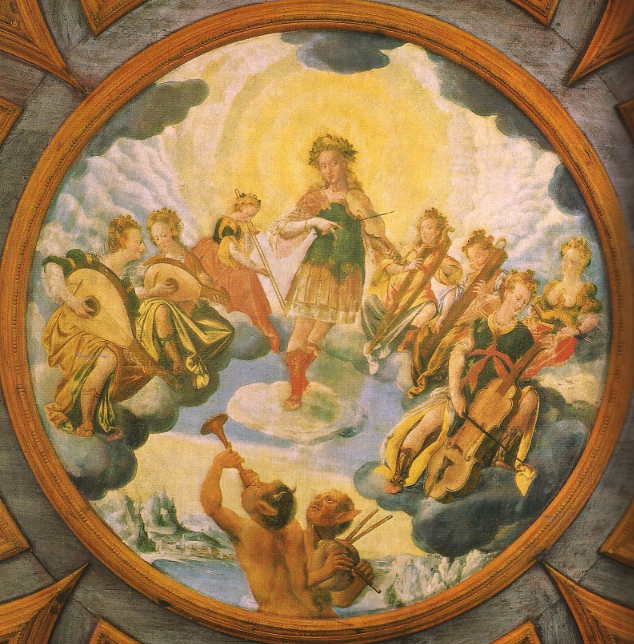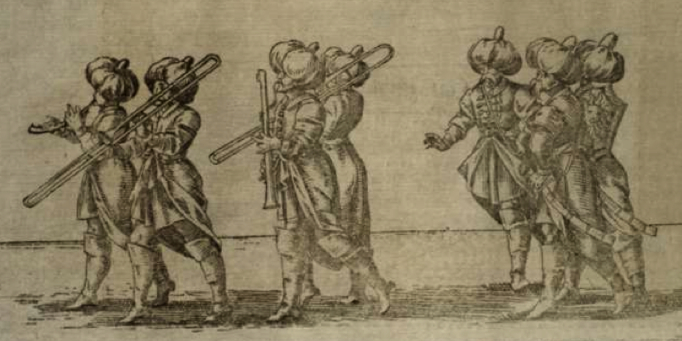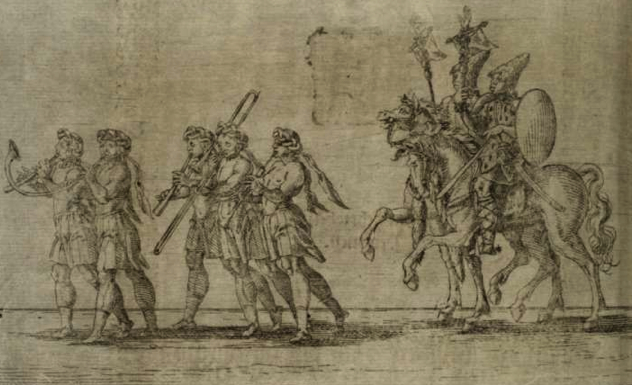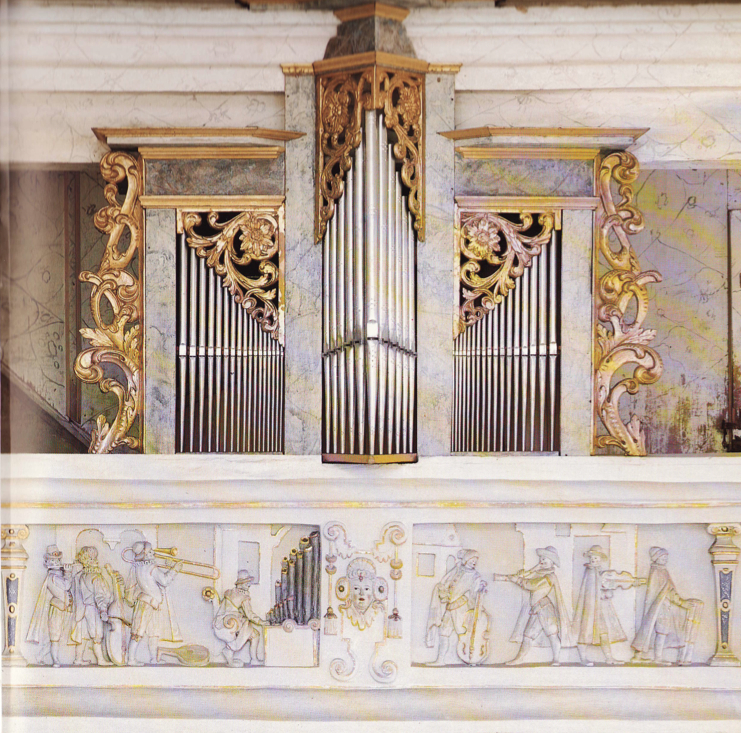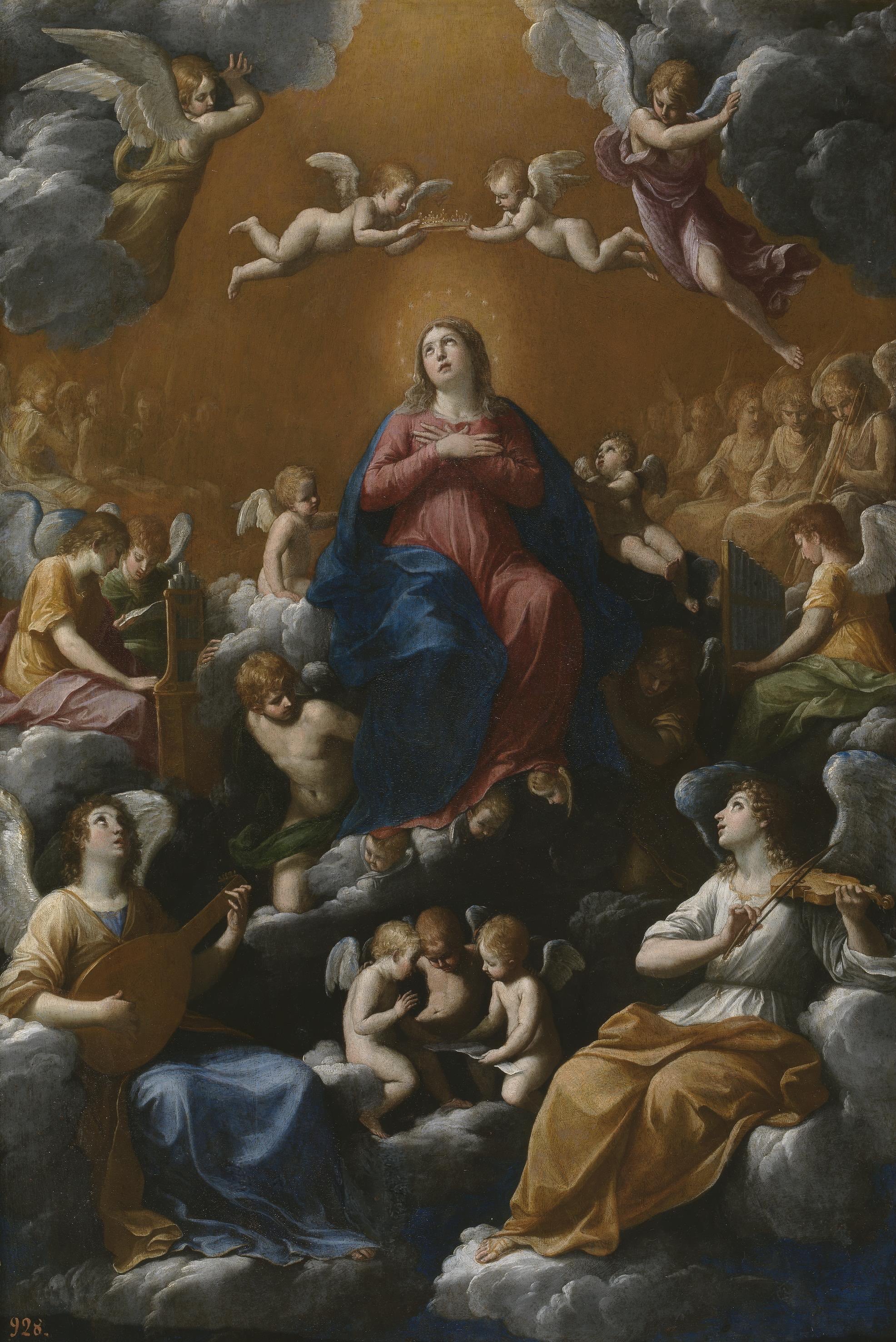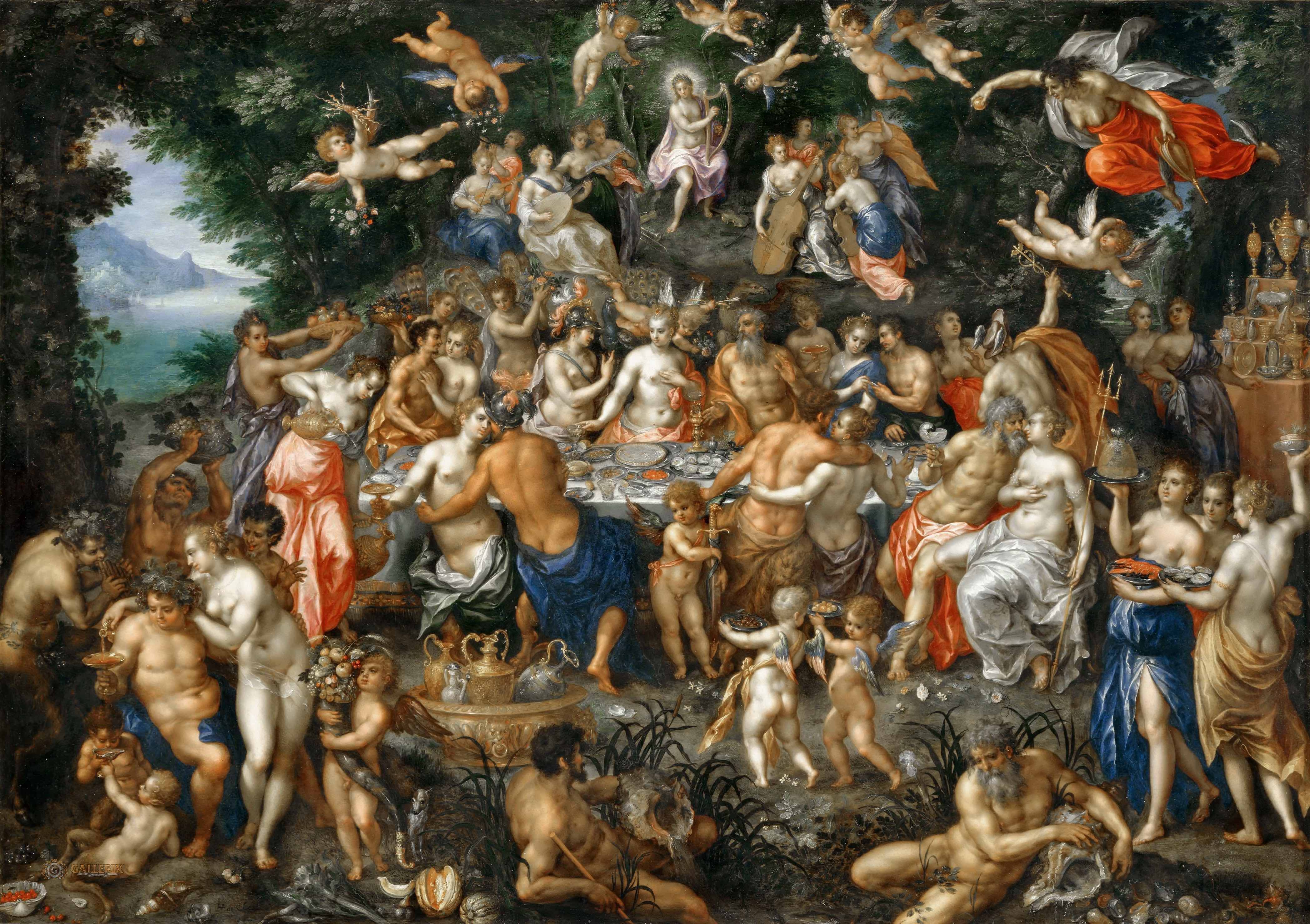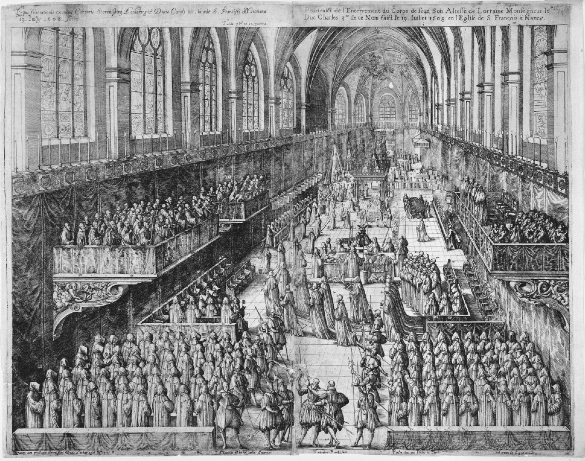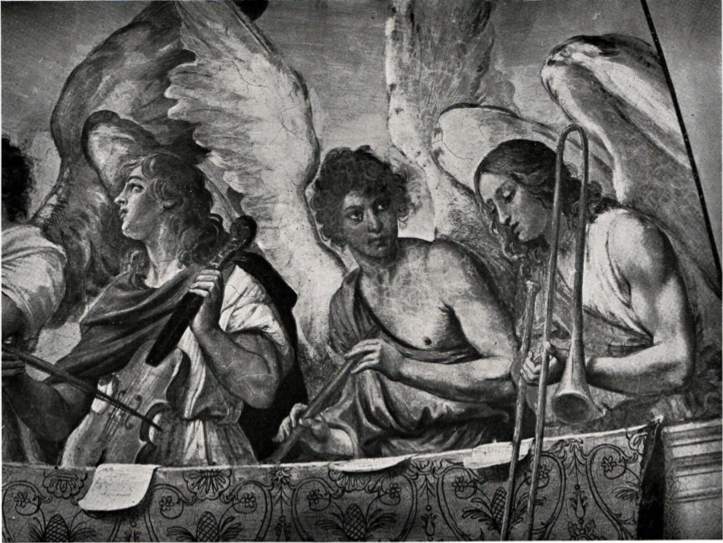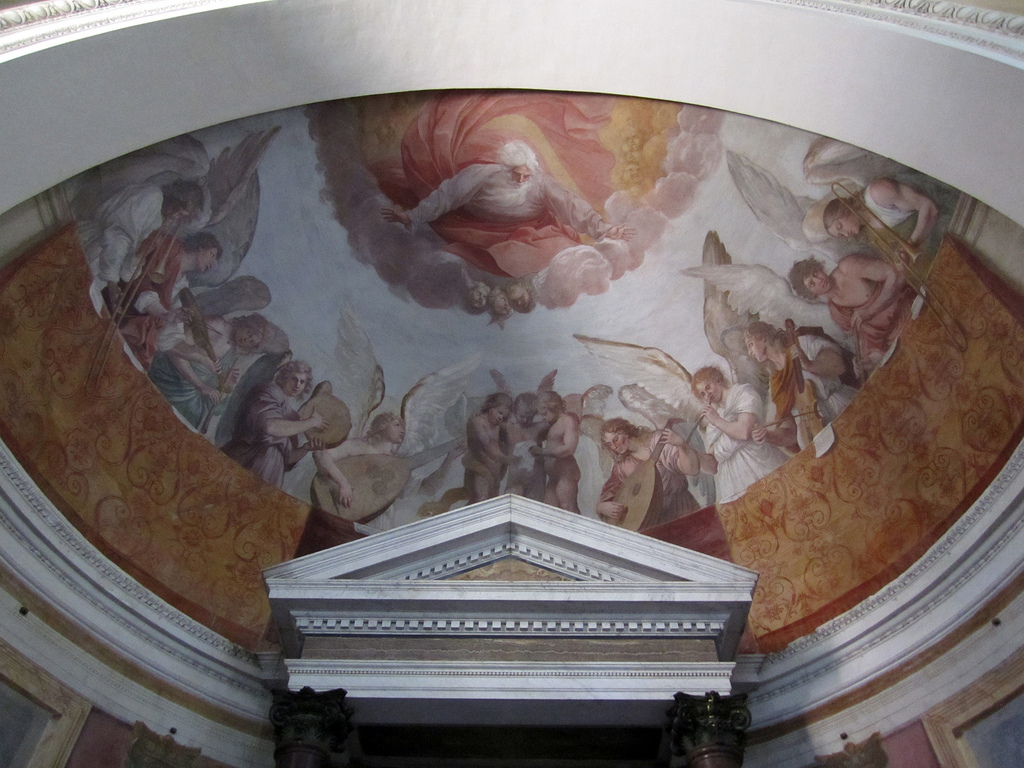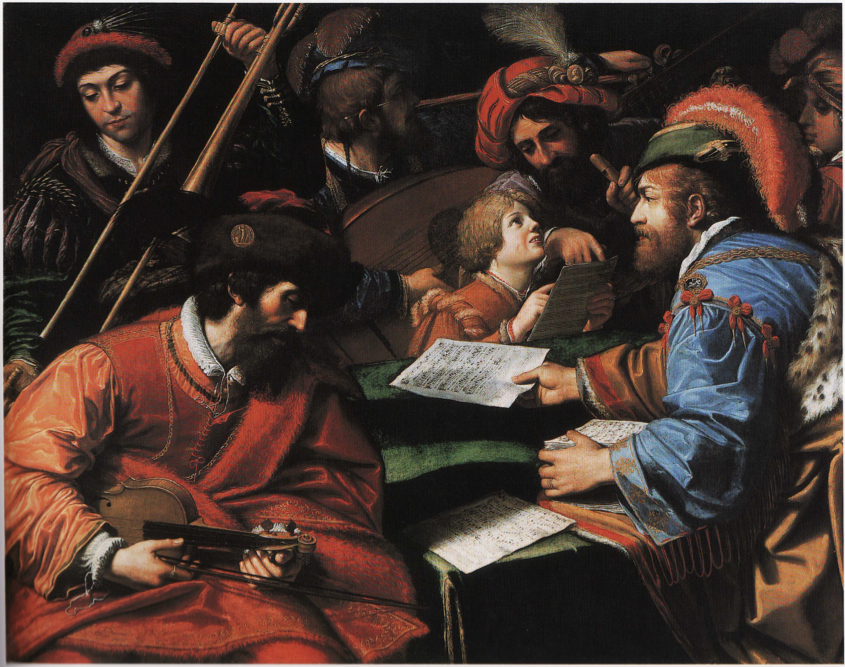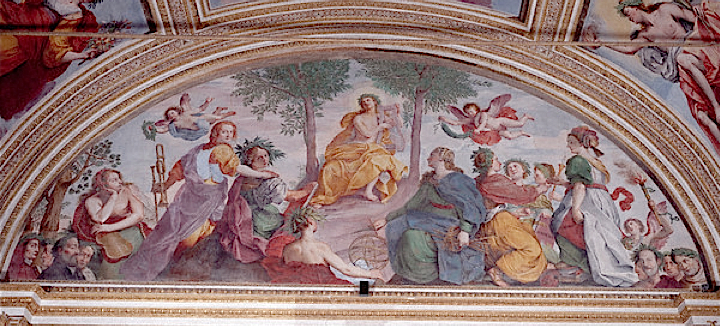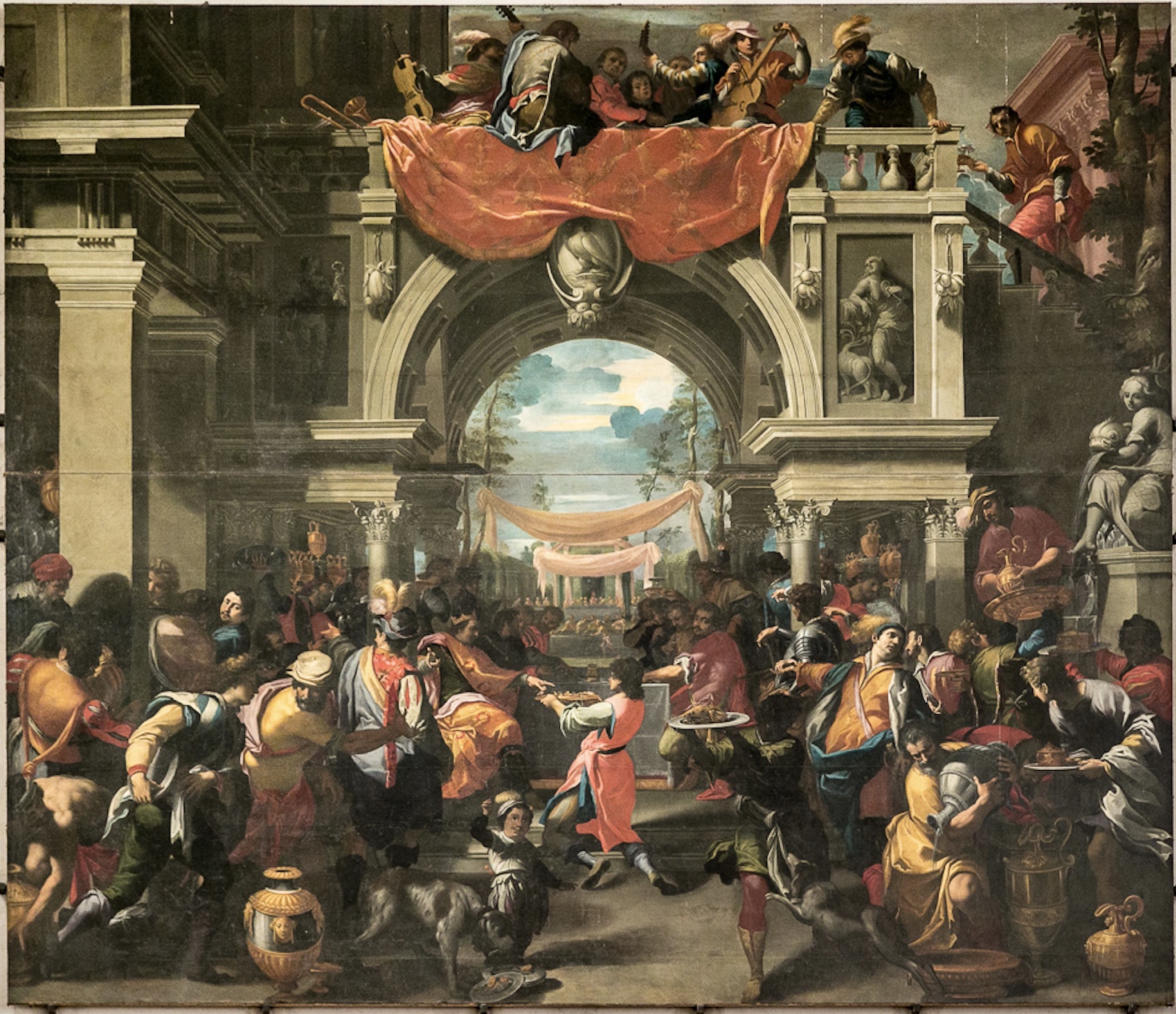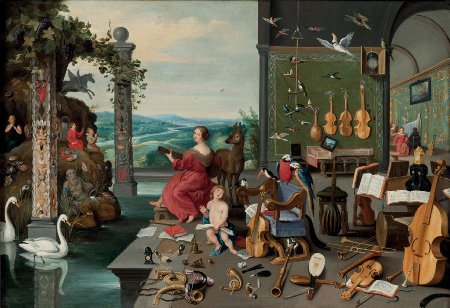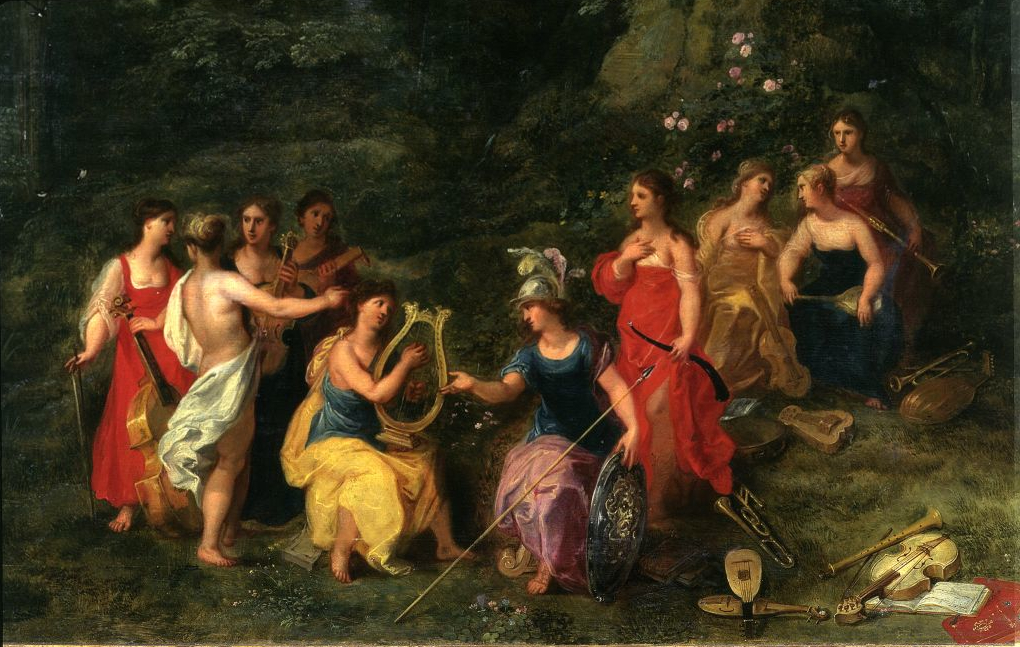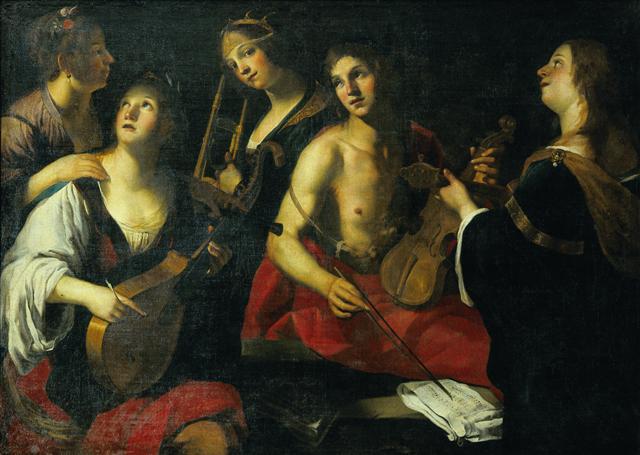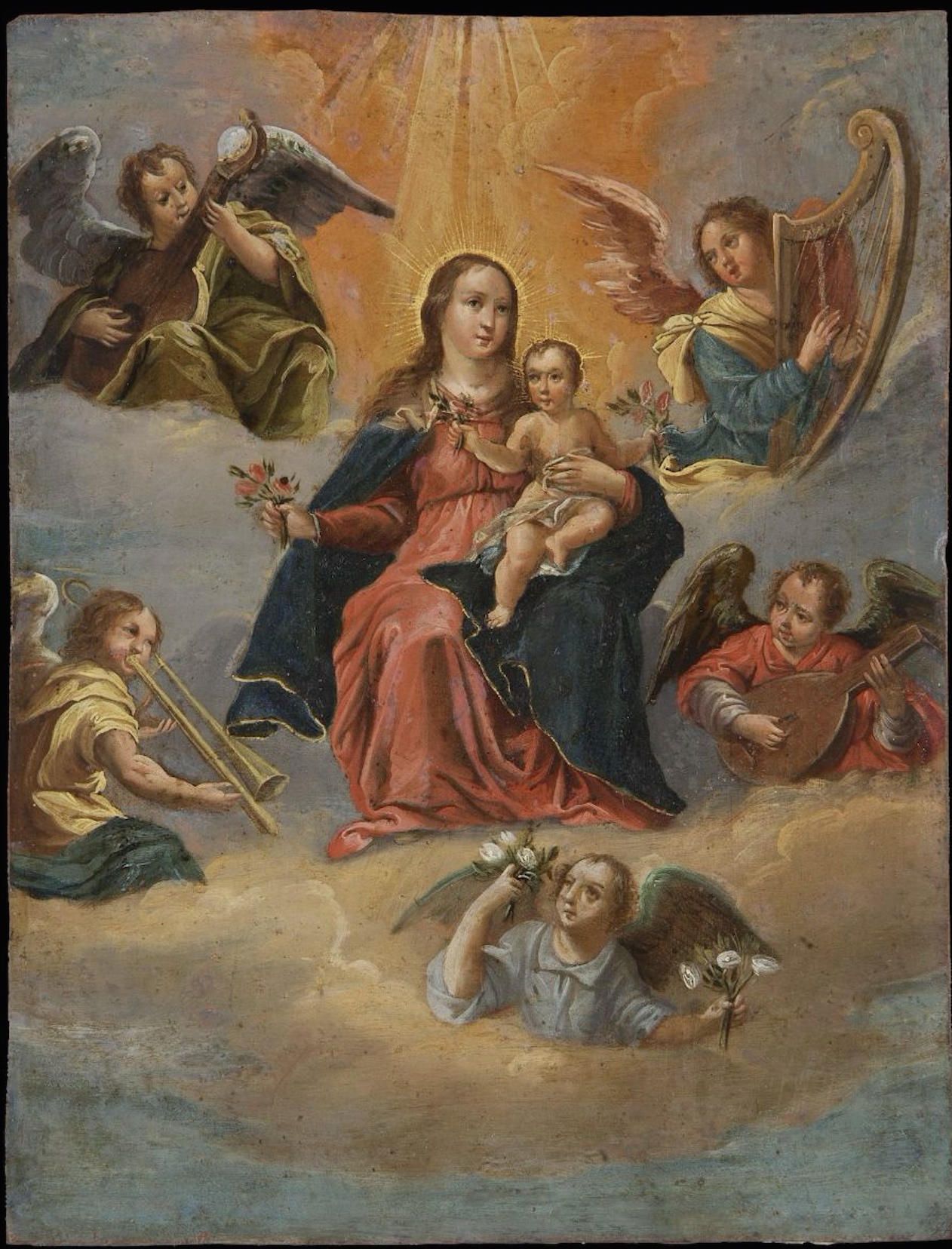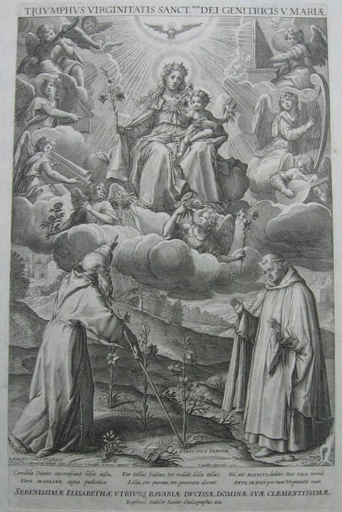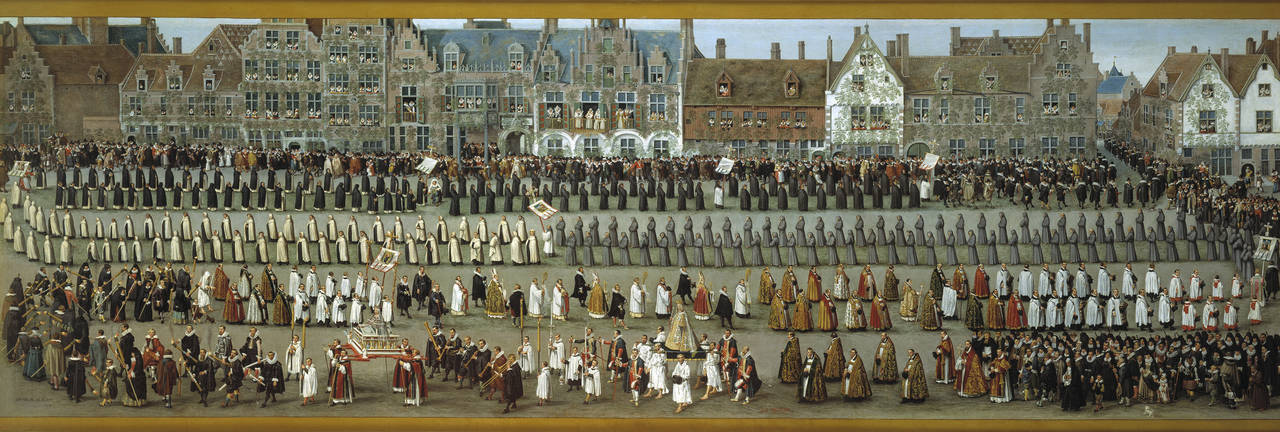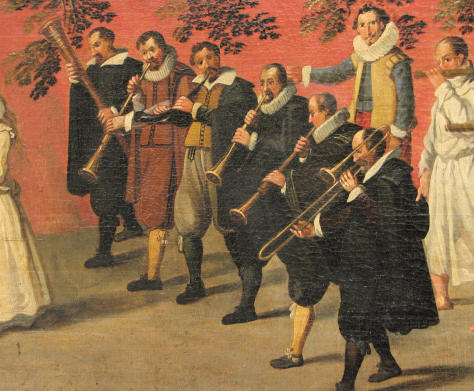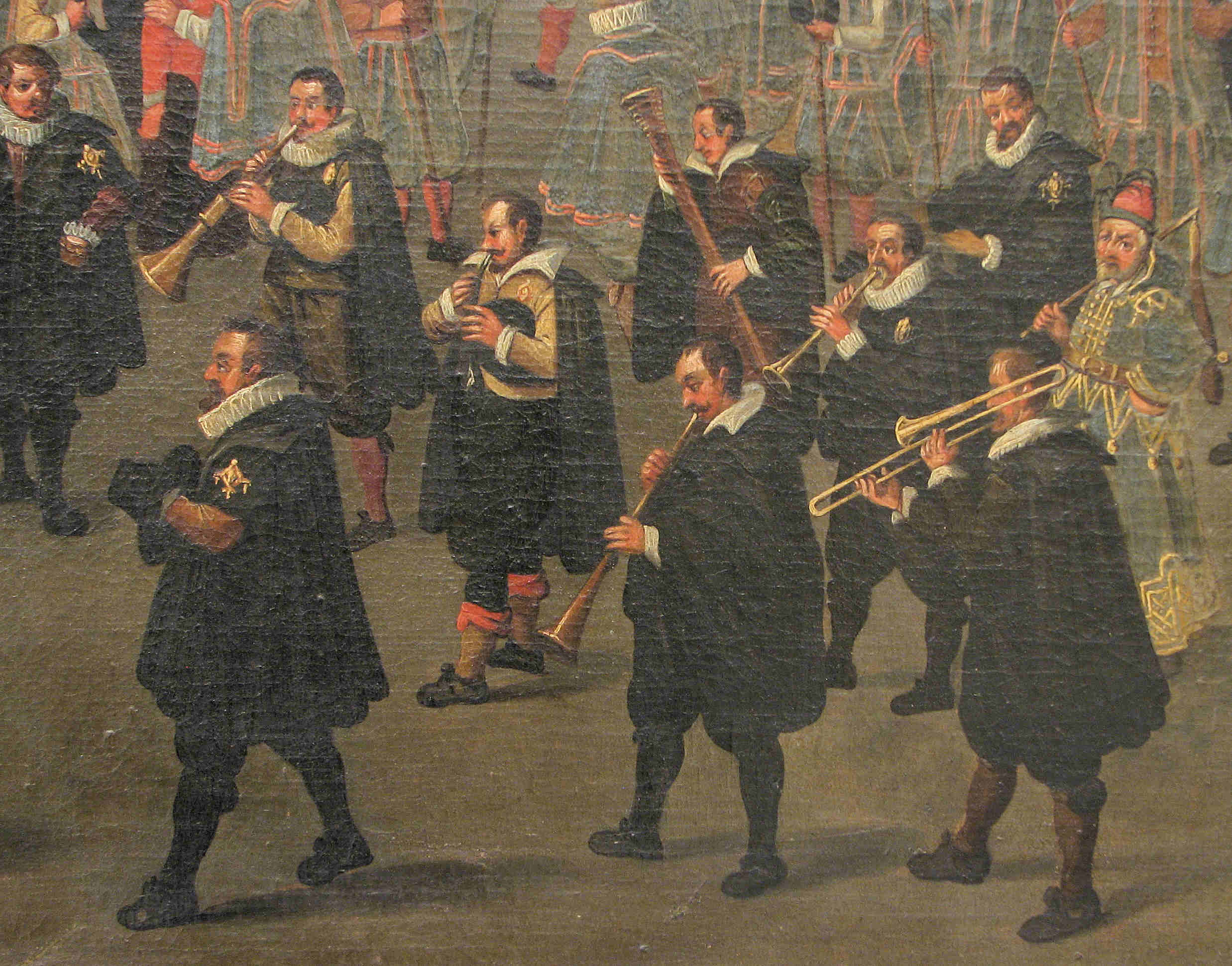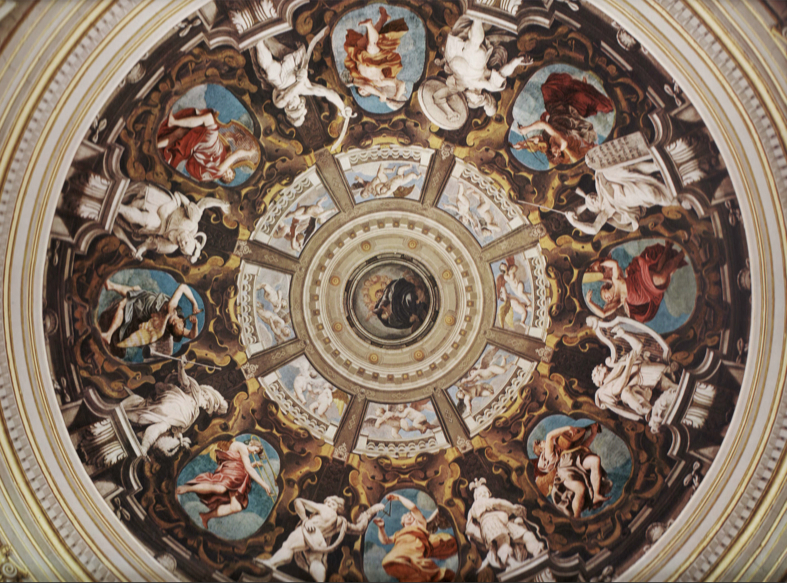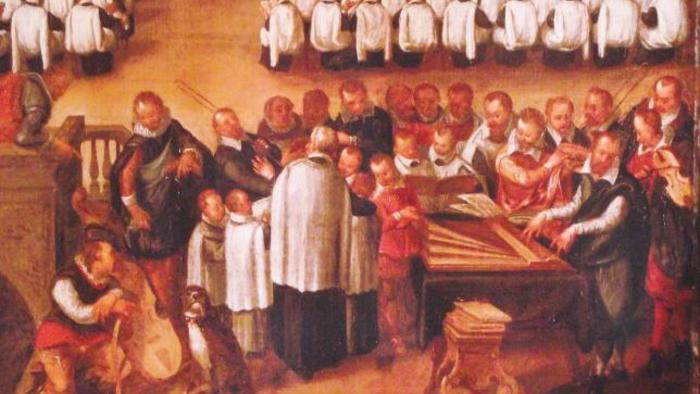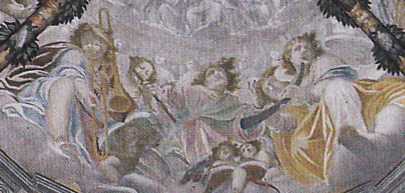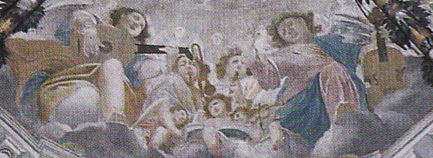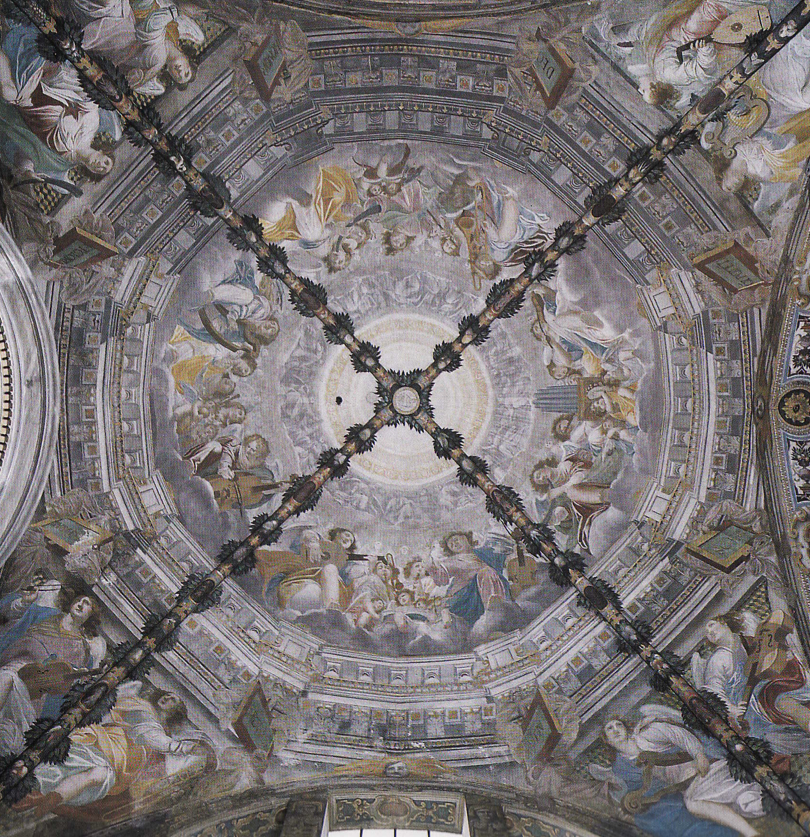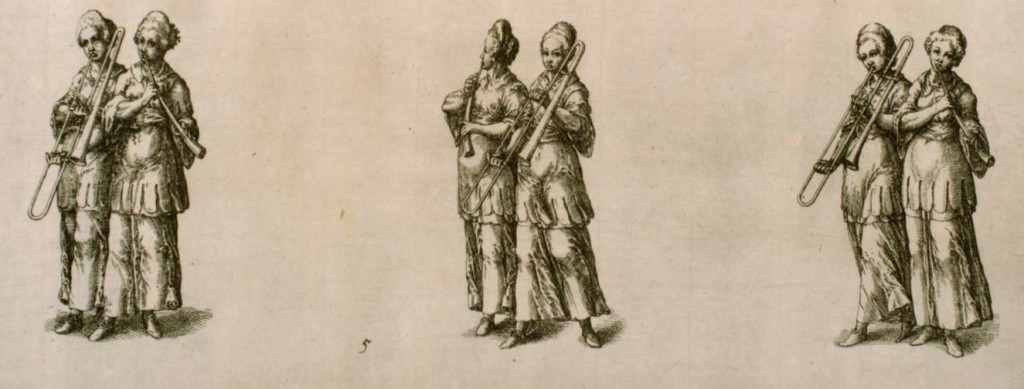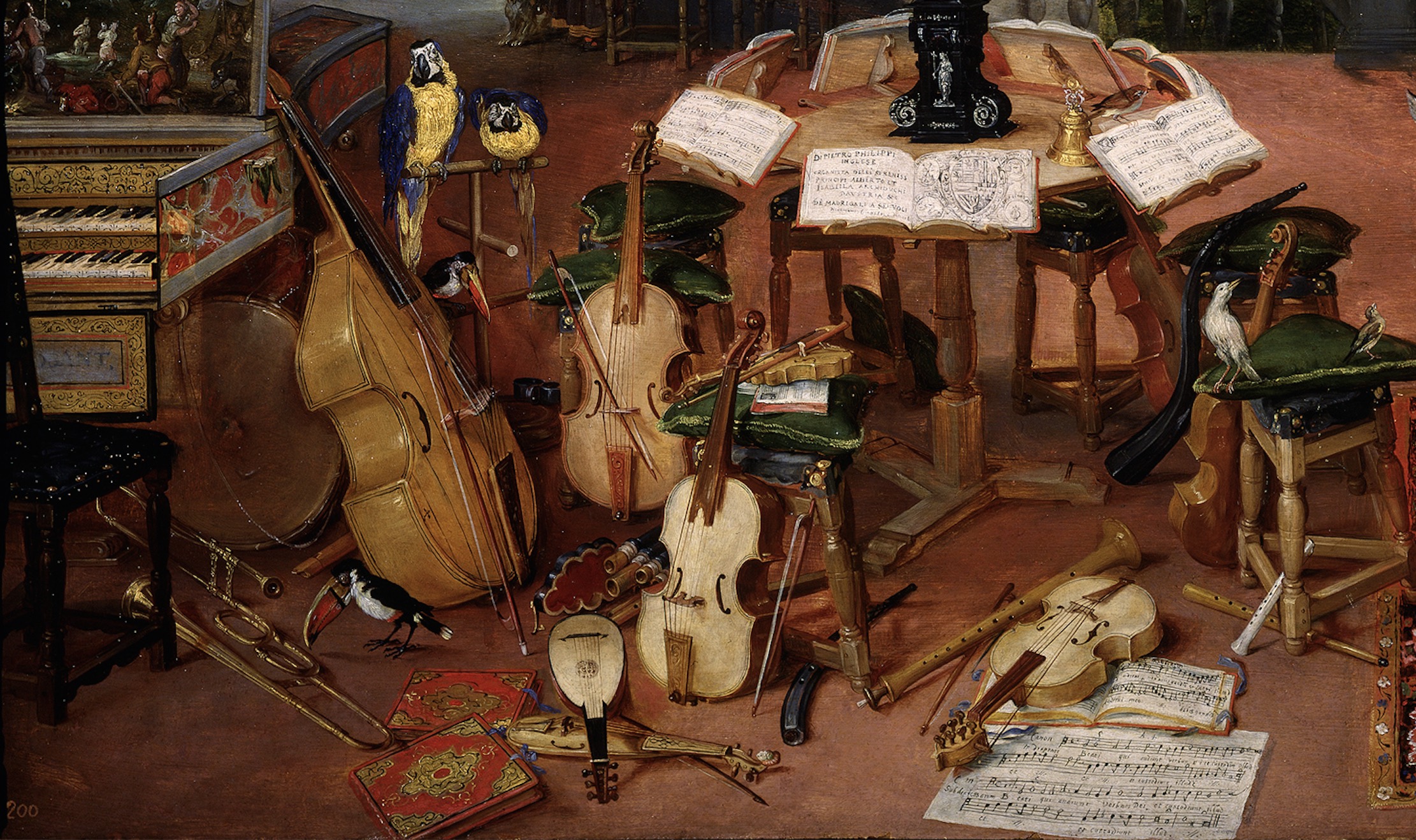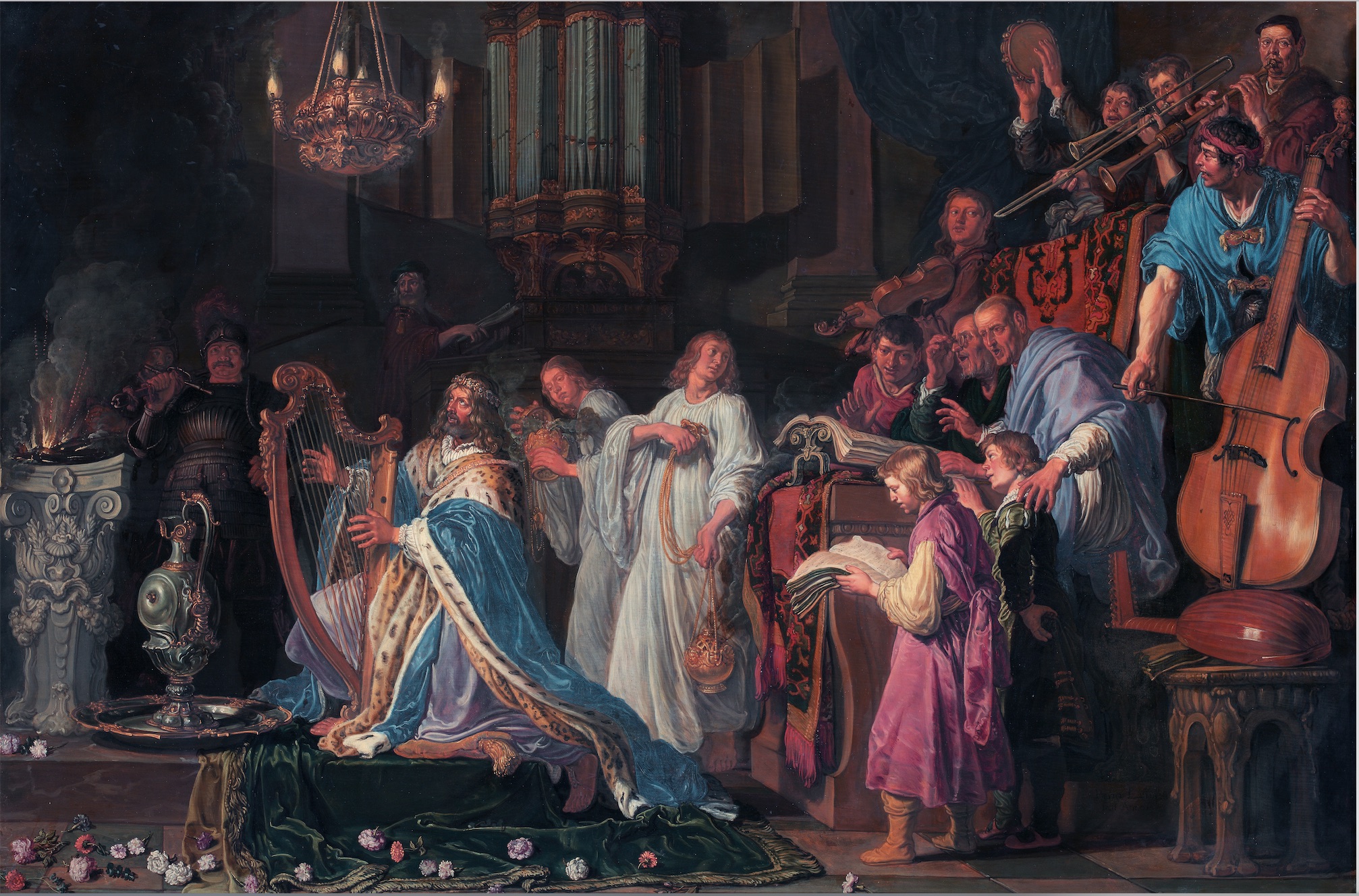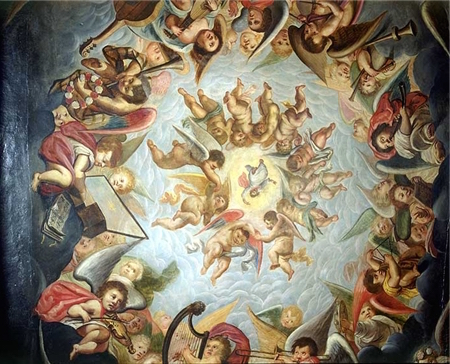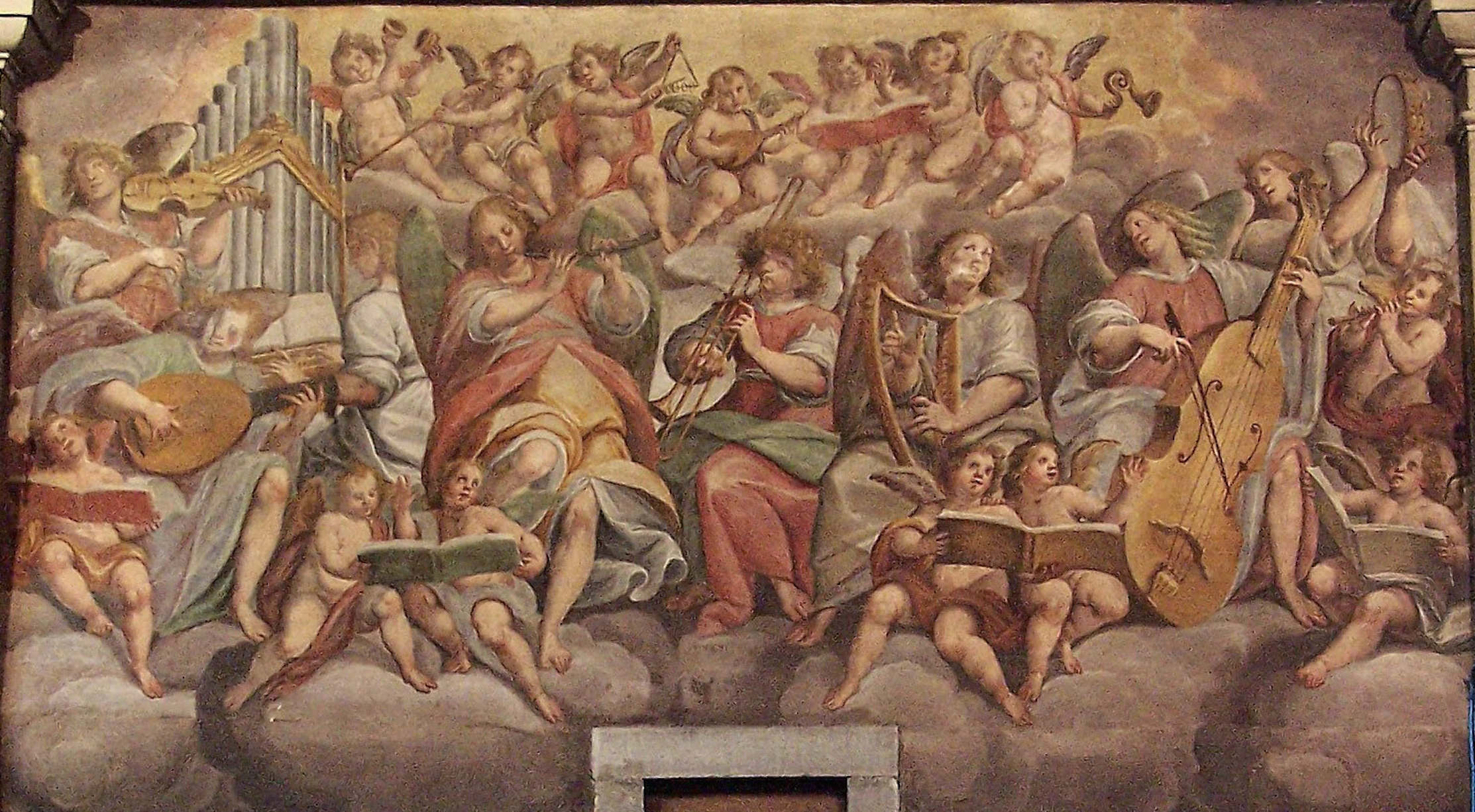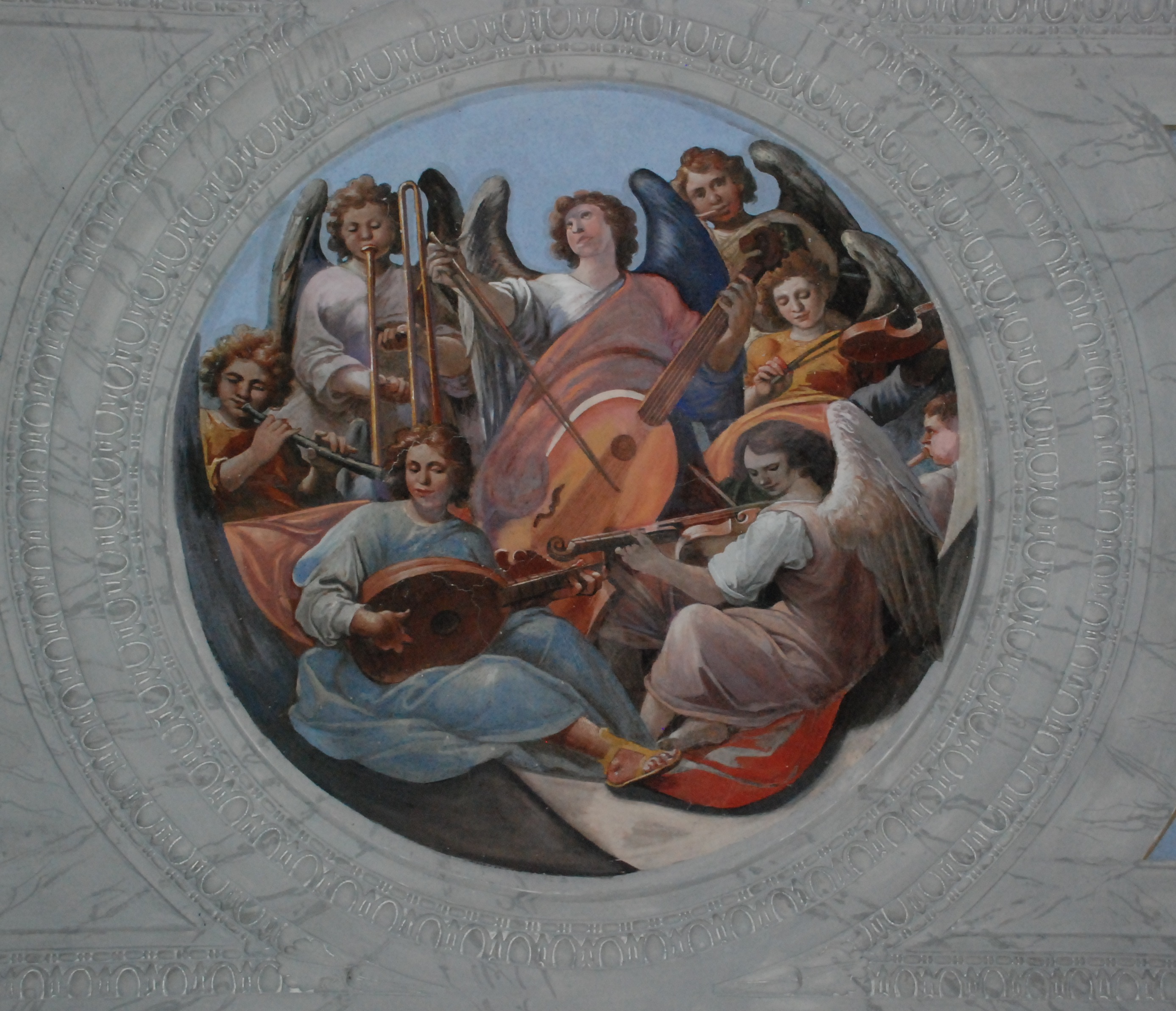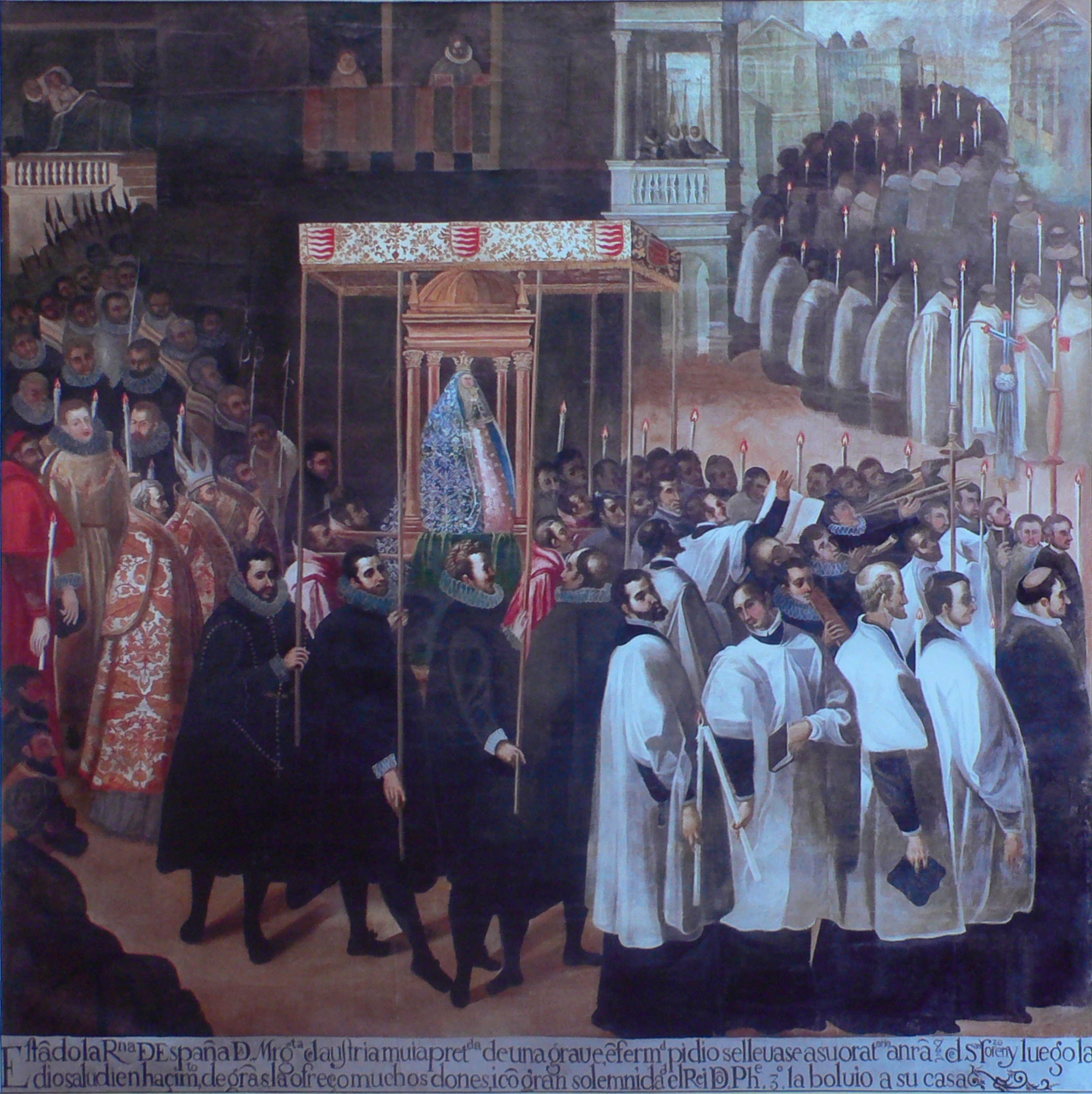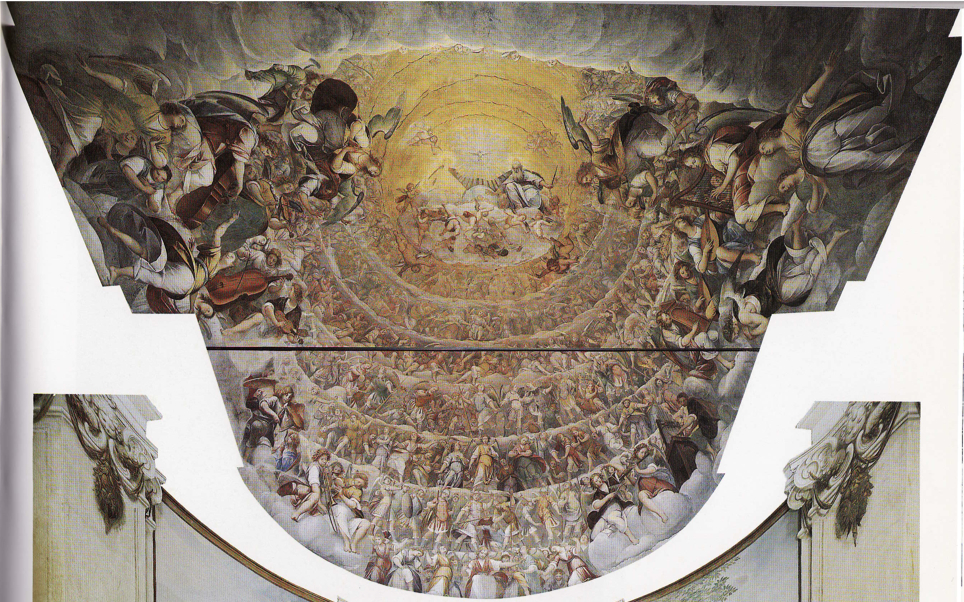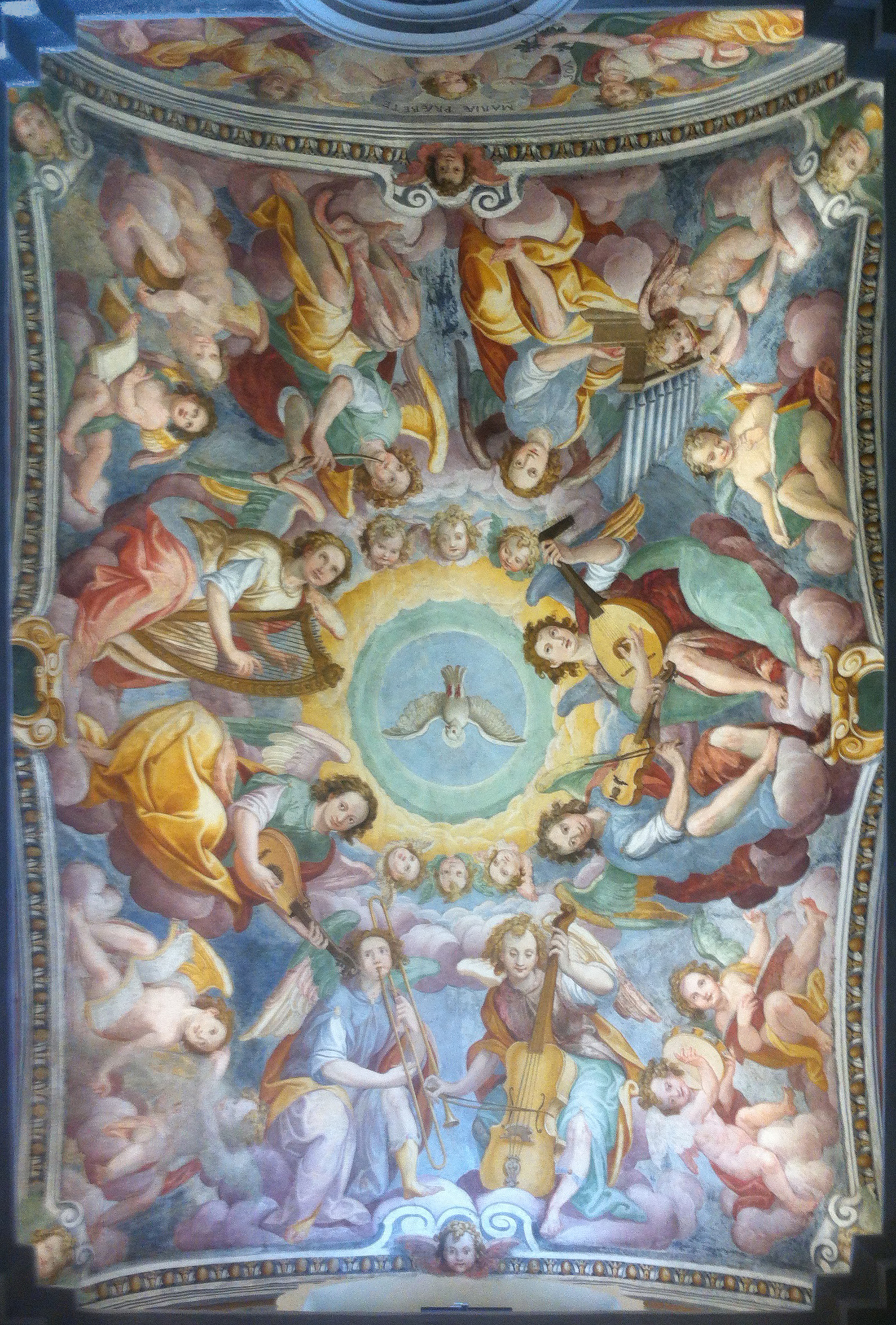A history of the trombone in timeline form. For sources see Trombone History Bibliography.
_______________
Early 1600s—Kassel, Germany: A five-part pavan by Landgrave Moritz of Hesse-Kassel specifies four parts: Fiffaro, Cornetto, Trombone, and dolzano. Landgrave Moritz, incidentally, is the same man credited with the discovery and sponsorship of the young Heinrich Schütz (Boydell, Crumhorn 402).
Early 1600s—Schloss Würting, Austria: A ceiling painting in the Würting castle in Upper Austria depicts Apollo and the muses, with one of the muses playing trombone (see detail and full image below; public domain) (Feuchtmüller pl. 190).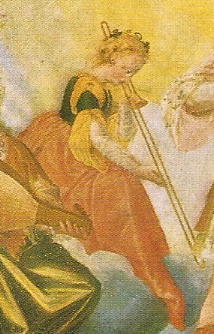
Early 1600s—Rozmberk, Ceske Budcjovice district, Czech Republic: In Allegory of Music, an anonymous wall painting in the music alcove of the Knights’ Hall in the Lower Castle at Rozmberk, a female trombonist is depicted among several other female musicians (see below image; public domain) (Volek pl. 107).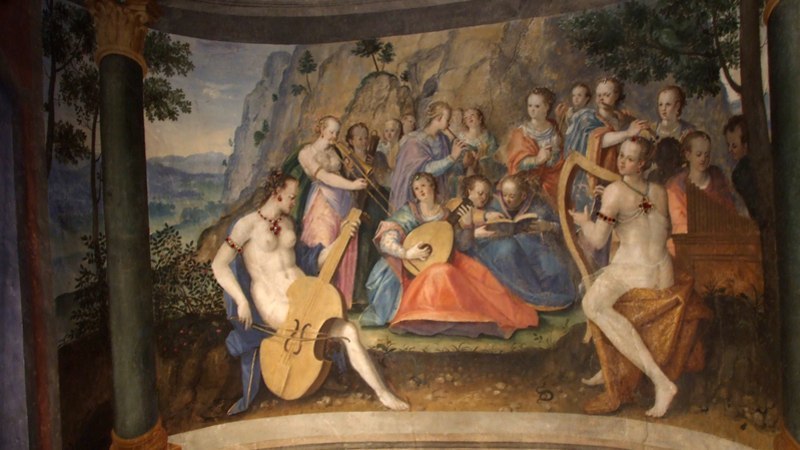
Early 1600s—Bologna, Italy: A painting in the Oratorio dei Battuti of Santa Maria della Vita features a number of angel musicians, including what appears to be a partially-obscured trombone player (see below image; public domain). Special thanks to Bruce Dickey.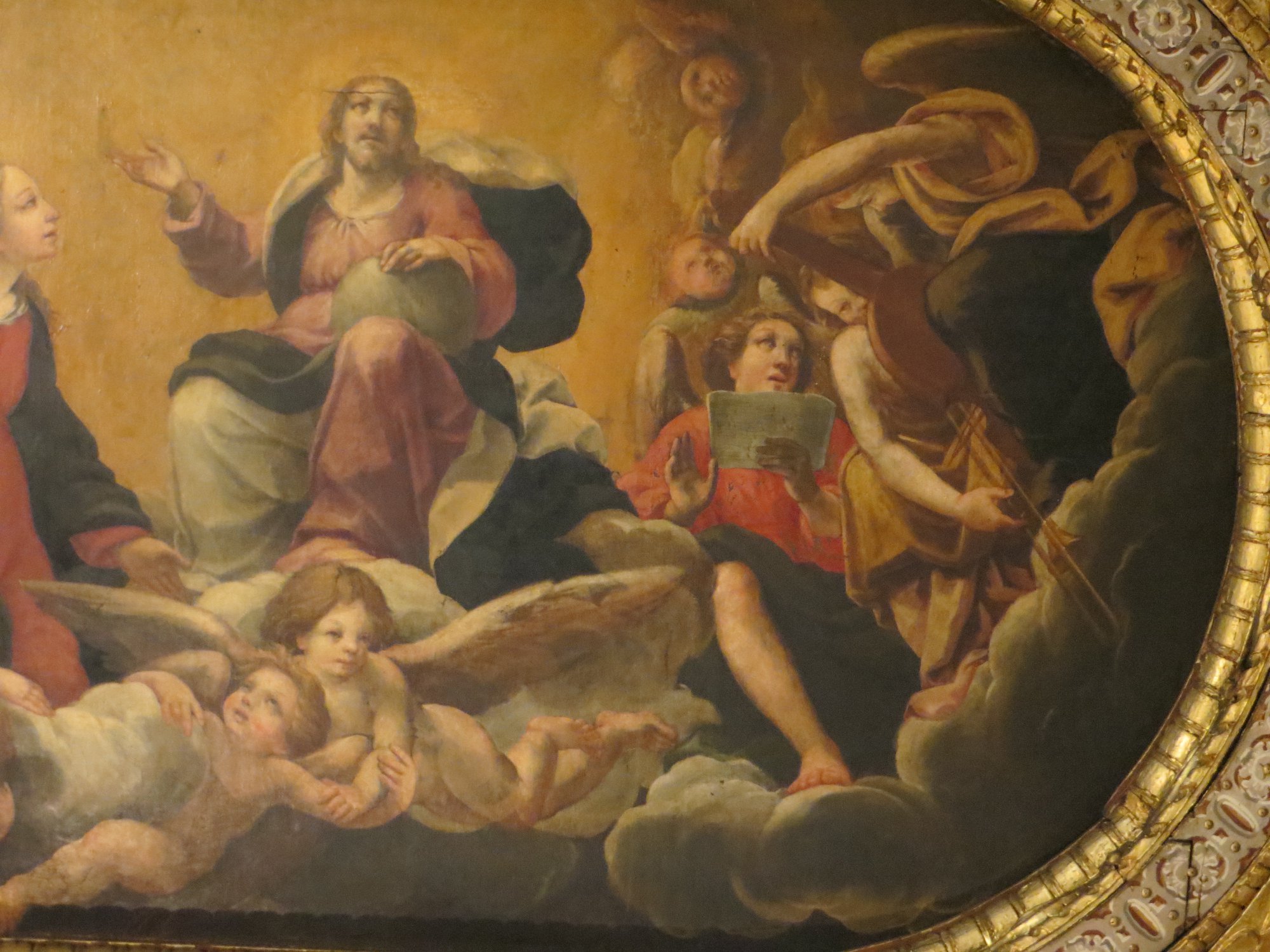
Early 1600s—Bologna, Italy: A painting in the Oratorio dei Battuti of Santa Maria della Vita features an angel playing what appears to be a trombone. One possibility is that part of the original bell of the instrument may have been turned into an extra bow of tubing by a restorer (see below image; public domain). Special thanks to Bruce Dickey.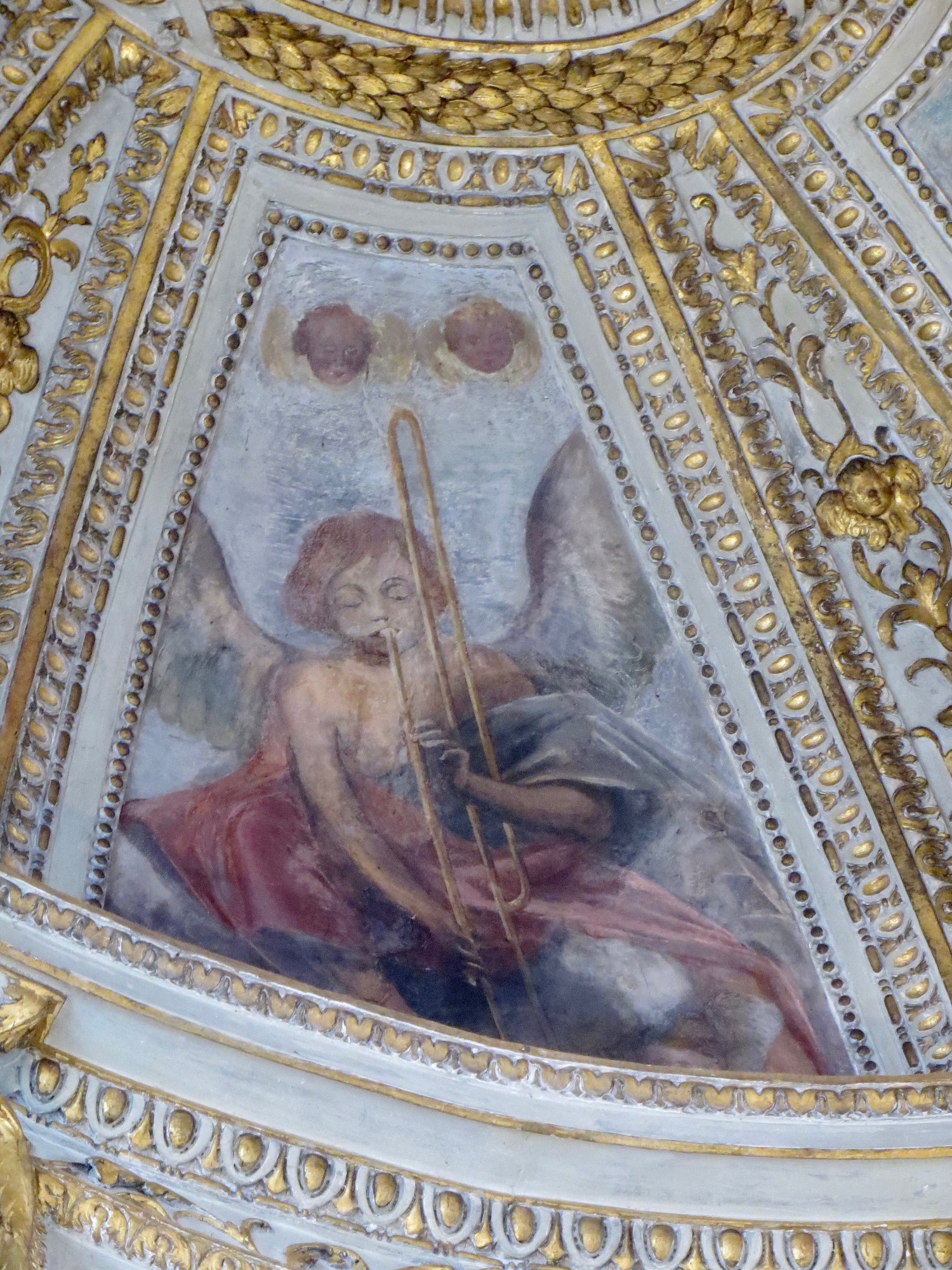
Early 1600s—Fiegni, Fiastra, Italy: Incoronazione della Vergine, a fresco in the apse of the Sanctuary of the Blessed Ugolino, or Beato Ugolino sanctuary church, includes an angel playing trombone (see detail and full image below; public domain).
1600s—La Plata, Bolivia: Instruments used at La Plata Cathedral during most of the 17th century are cornett, 2 or 3 shawms, trombone, and 1 or 2 curtals (Bermúdez).
1600s—Southern Netherlands: An anonymous 17th century drawing portrays five angel-musicians, including a trombonist, performing from a balcony or platform. Separate leaves of music for four of the five players are pictured draped over the edge (see below image; public domain) (Paris, Louvre; Wangermée vol. 1 287). The drawing is almost certainly either a preparatory sketch for or a copy of Guido Reni’s fresco, Gloria d’angeli (see 1609, below).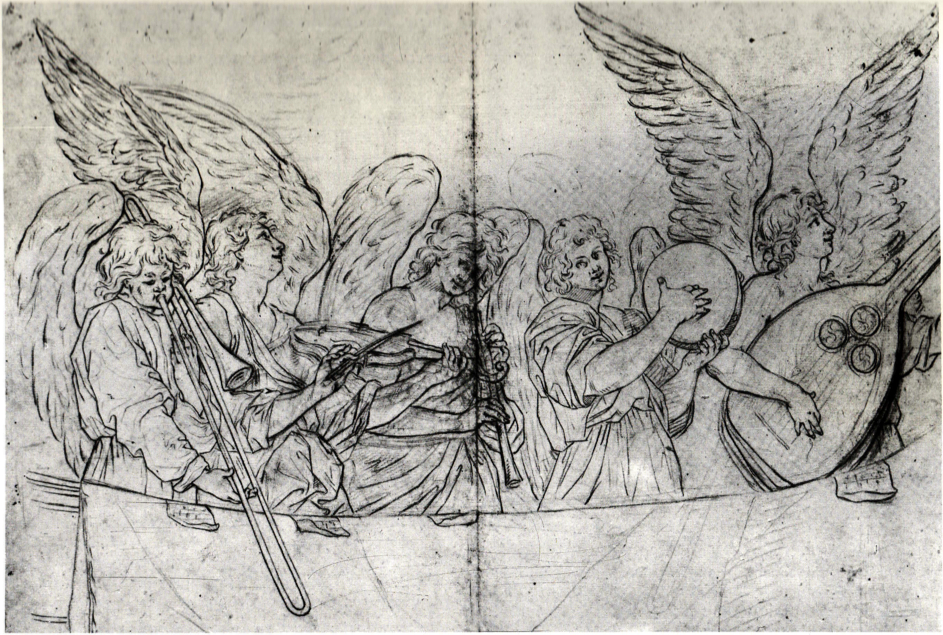
1600s—Thaleia, Muse of Comic Poetry, an anonymous engraving, includes the following caption: “If our story is great, or if it is a comedy of life, Our story, even after it has been told does not satisfy God, It does not create the eternal well-being which pleases us; And expressed it does not include the praises of God” (see below image; public domain) (Naylor 96).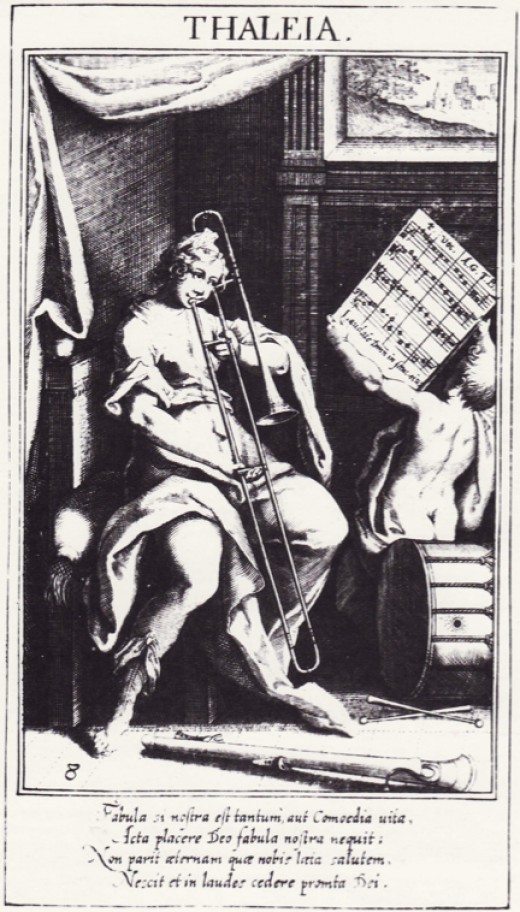
1600s—Pastrengo (Verona), Italy: A fresco in Sanctuario di Santa Maria di Pol depicts an angel trombonist (see below image; public domain) (special thanks to Michele Magnabosco).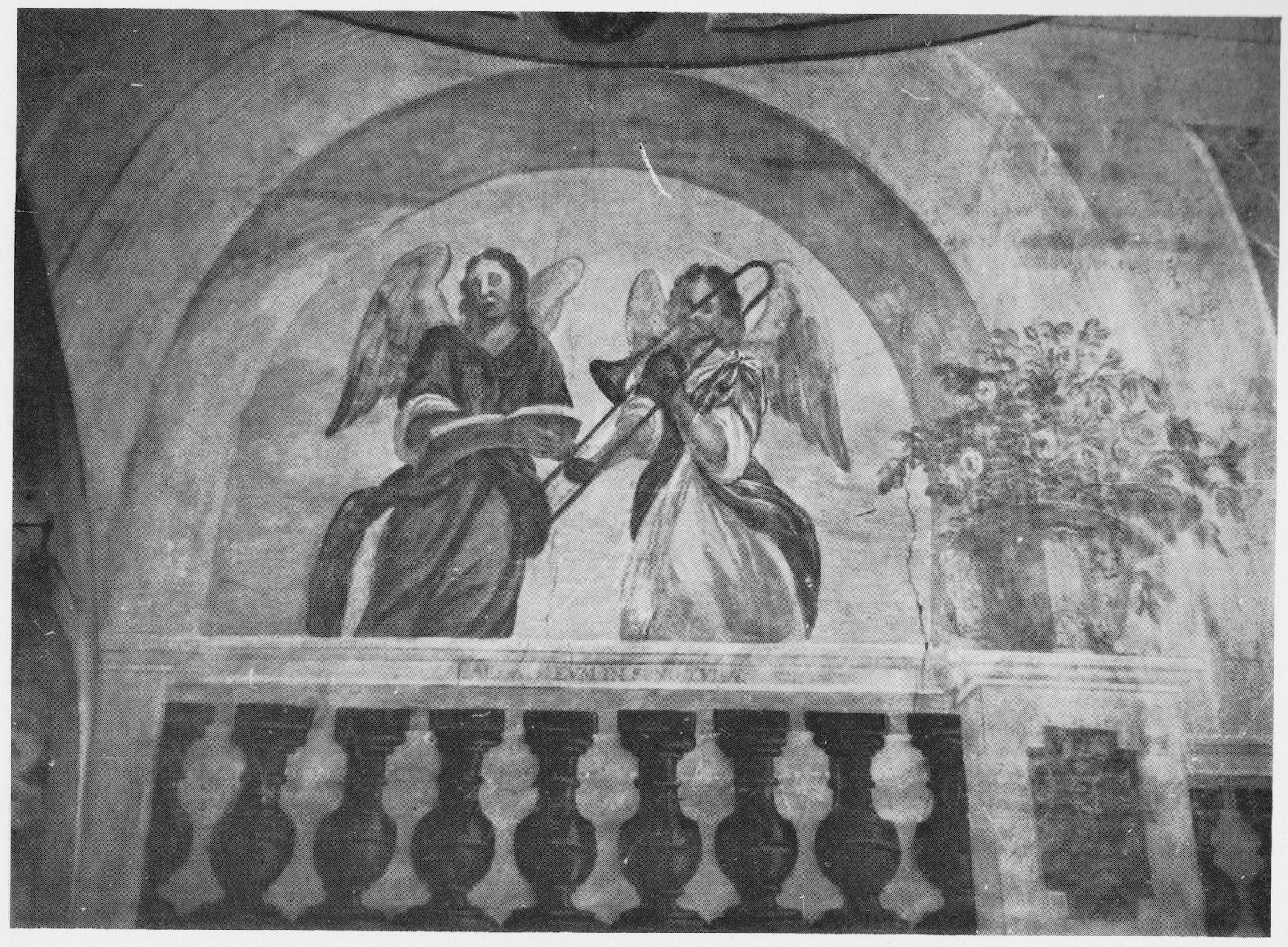
1600s—Malvaglia, Switzerland: A fresco in the parish church of San Martino features a concert of angel musicians with a trombonist (see below detail; public domain).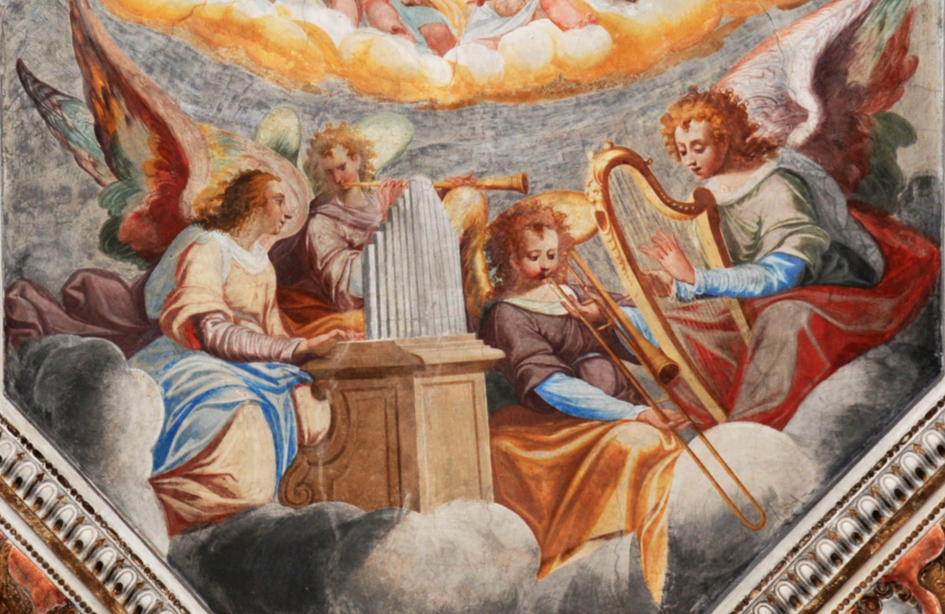
c. 1600s—Spain (?): An image attributed to Santacruz featuring an angel playing trombone bears a resemblance to a painting by Lippi that is considered the earliest reliable depiction of a trombone (see below image; public domain) (source: Gallica, the digital library of the National Library of France).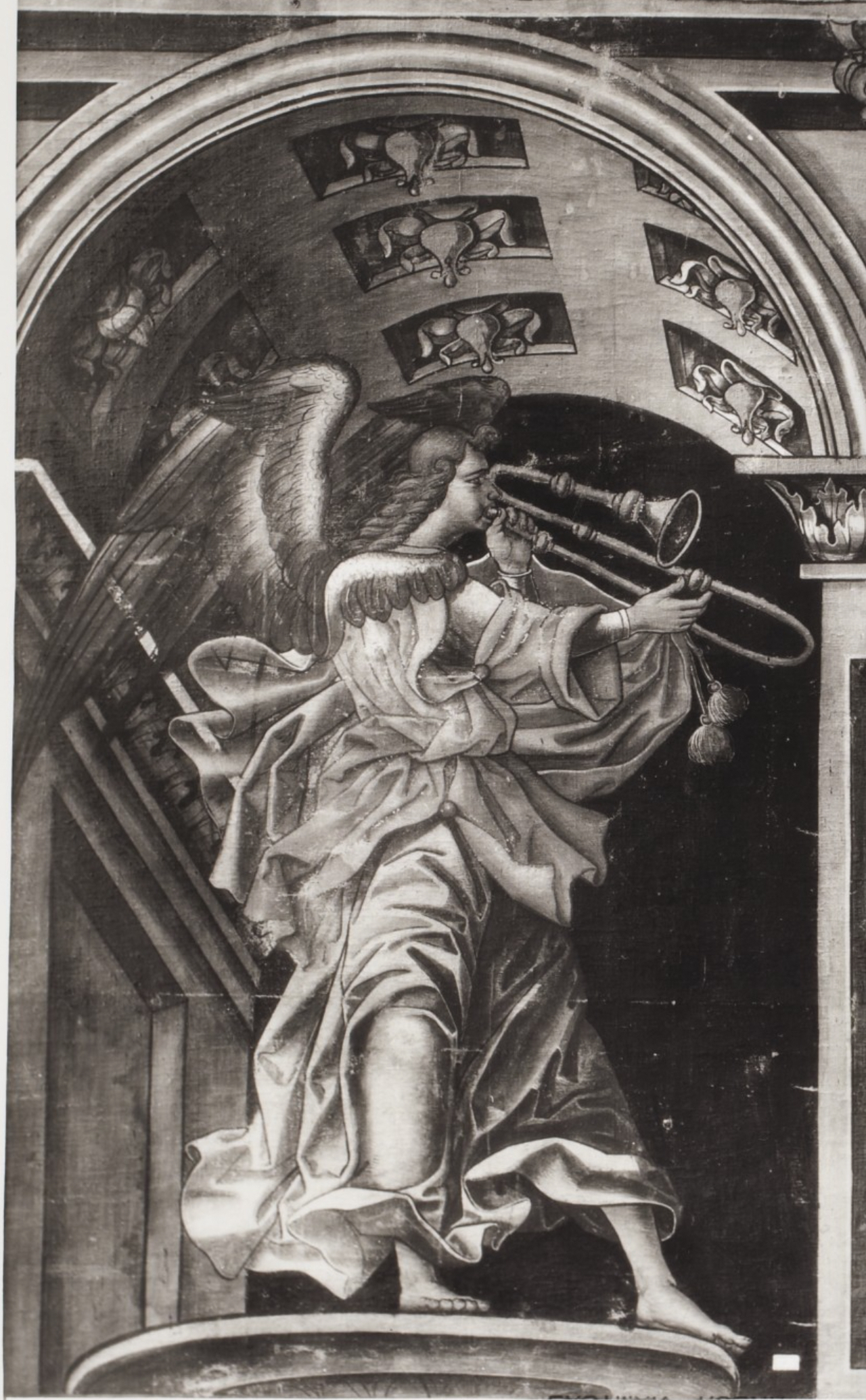
1600s—A Flemish painting, Wedding at Canaa, depicts several instruments, including what is probably a trombone, playing from a loft (see detail and full image below; public domain) (special thanks to Tassos Dimitriadis).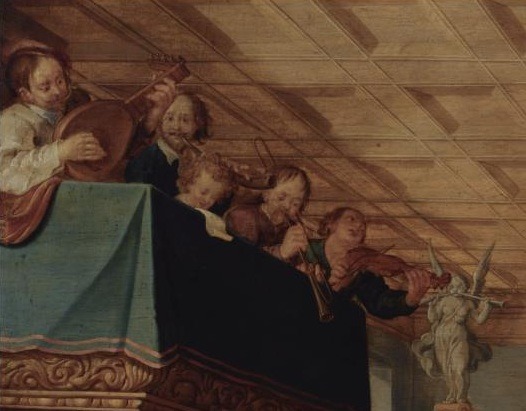
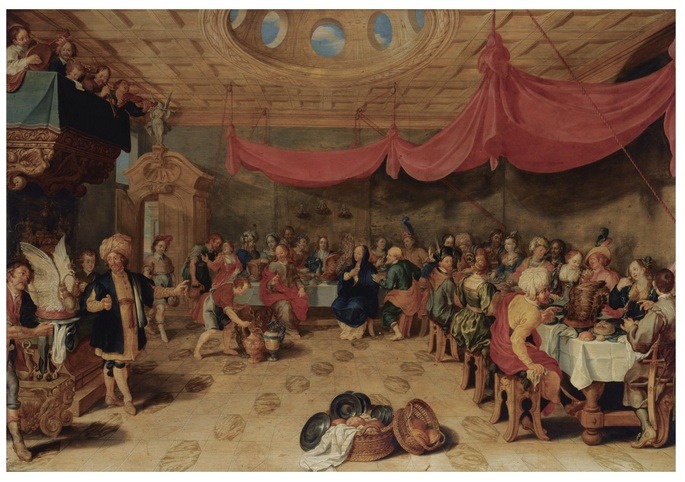
1600s—An artist of the Flemish school paints a secular version of a very popular St. Cecilia painting (see Paper, Canvas, Silver, Wood, and Glass: St. Cecilia Trombone Image in Many Forms). Here the musicians are spread out, wings removed, with secular clothing rather than robes. Note the similarity of instruments played, sequence of instruments (though the trombone is switched with the gamba and placed on the far right), inclusion of people holding music, and placement of the organist in the middle (St. Cecilia in the original painting). The extra stay on the trombone slide is retained from the original. The ribbon flowing from the organist’s hair, present in many other versions of the painting, is also clear here. It is worthwhile to note that the original artist, Pieter de Witte, was of Flemish descent, and four other images among these copies are by Flemish artists (see below image; public domain; courtesy of Tassos Dimitriadis).
1600s—Vijf muzikanten op een bal, a print from the Dutch school, features a trombone as a member of a wind quintet (see below image; public domain) (special thanks to Tassos Dimitriadis).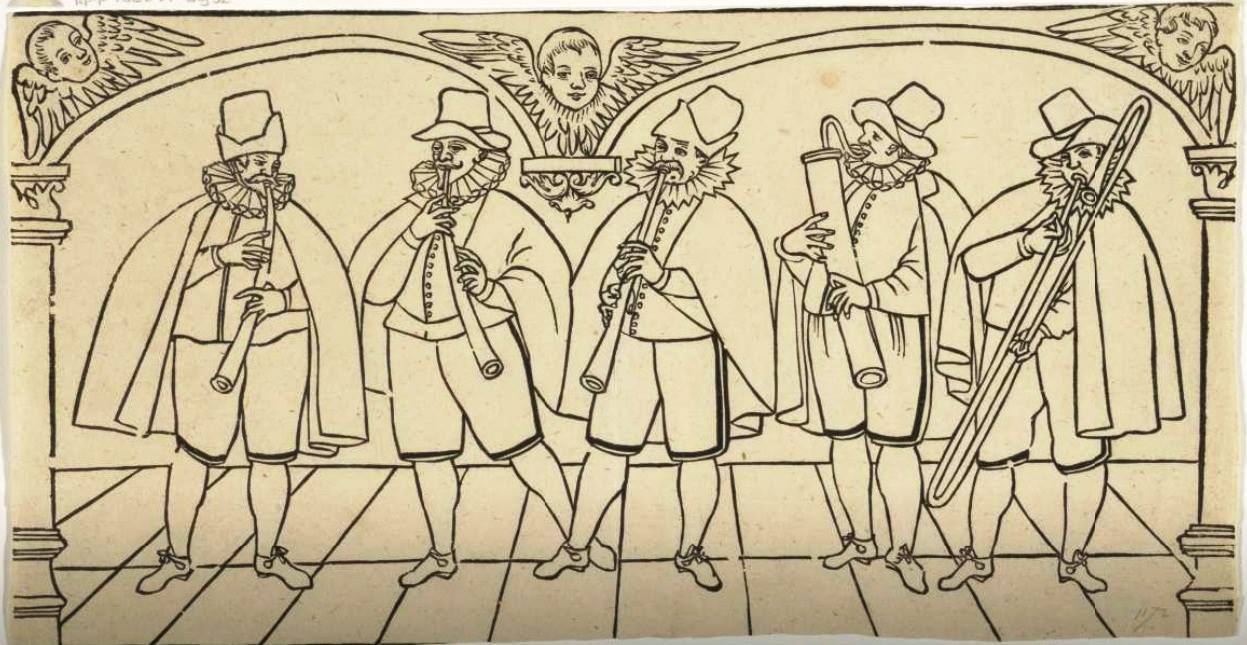
1600s—Betenbrunn, Heiligenberg, Germany: A painting at the Wallfahrtskirche Mariae Geburt depicts an angel playing trombone (see below image; public domain).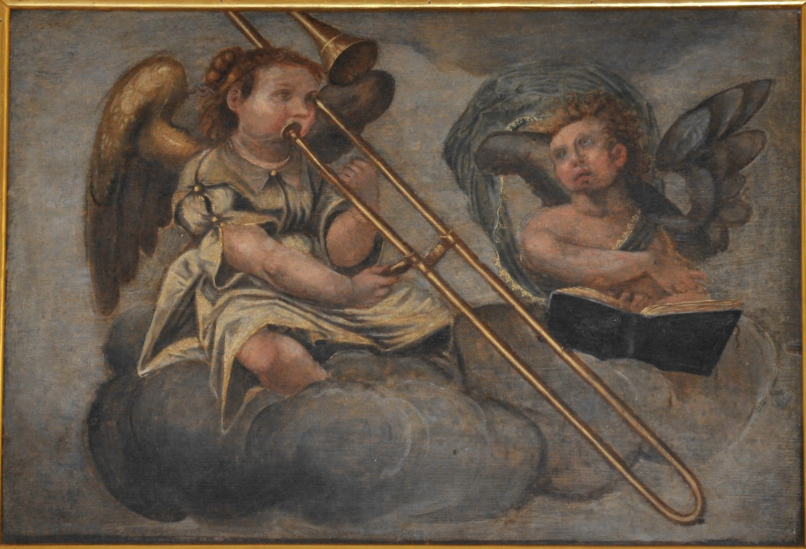
1601—Marburg, Germany: A list of new instruments at the Marburg castle includes 1 trombone (Posaunn) (Baines, Two Cassel Inventories).
1601—Siena, Italy: A musician by the name of Ottavio Basili is appointed as cathedral trombonist. He serves until 1610 (Reardon, Agostino Agazzari 53). 1601—Siena, Italy: A small core of professional musicians is assembled at the Santissima Annunziata, the church attached to the orphanage and school Santa Maria della Scala. The group consists of maestro di cappella and trombonist Alberto Gregori, trombonist Piergiovanni Odorini, and an organist. This professional ensemble is augmented by orphan apprentices from the school. Records of an official visit by the rector in 1610 show Gregori and Piergiovanni still on staff, although the ensemble probably disbands by 1612 due to financial woes (Reardon, Insegniar 130).
1601—Wolfenbüttel, Germany: A festival book for Landgrave Moritz of Hesse-Kassel documenting the 1596 celebrations in honor of the baptism of Elizabeth, daughter of Moritz, includes at least three different images (by artist Wilhelm Dilich) of trombones in musical ensembles walking in procession (see below 3 images; public domain) (Dilich 00135).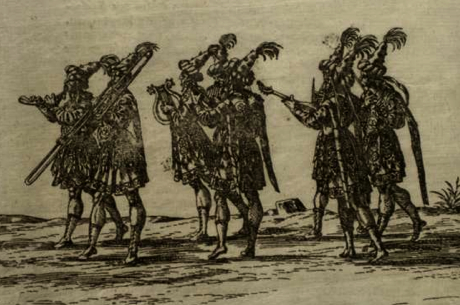
1601—Venice, Italy: The nucleus of instrumental musicians employed at St. Mark’s is 4 trombones and cornettos (Moore 81).
1601—Naples, Italy: Scipione Cerreto lists musicians active in Naples in his treatise, Della prattica musica. Instrumentalists include players of trombone, shawm, cornett, lute, organ, viol, and seven-course guitar (Mammarella, Musical Instruments in a 1592 Inventory).
1601—Siena, Italy: In the palace wind band, trombonist Alberto Gregori, who has been serving in a temporary supernumerary post, becomes a permanent member of the group, replacing recently-deceased Tiverio Rivolti (D’Accone, Civic Muse 598).
1601-1650—Naples, Italy: Payments are made to maestri of trumpet and trombone at the Conservatorio di Loreto during the first half of the 17th century (Fabris 26).
1602—Weikersheim Castle, Germany: An organ for the castle chapel is made by Georg Schweitzer. The case just below the organ contains a relief image of a trombonist performing with a flute, viol, and organ (see detaill and full image below; public domain) (Völkl 39).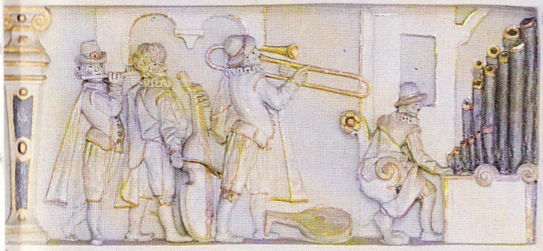
1602—Bologna, Italy: Pompeo Vizani, a Bolognese patrician, describes regular brass performances at the city’s piazza: “There on a beautiful arch or balcony of stone, trumpets are played every evening. And after the trumpets have finished, very pleasant music is played on trombones and cornettos at the same Piazza as well as the great building of the church of St. Petronio” (Smithers, Baroque Trumpet 77-78).
1602—Bologna, Italy: Pompeo Vizani describes local civic brass ensembles: “When they appear in public, these ‘Signori’ are dressed in rich robes of silk, and during the winter they are muffled up with very precious furs as well. They are accompanied by a very respectable household of eight trumpeters, with a drummer, or player of the nakers, who with these trumpets plays certain Morish drums. To both the drums and trumpets are attached banners with the arms of liberty; also eight excellent musicians with trombones and cornettos…” (Smithers, Baroque Trumpet 78).
1602—Venice, Italy: The nucleus of musicians at St. Mark’s, mentioned above (1601), expands for Christmas day, when 6 extra trombones are hired among the 14 extra instrumentalists (the others are 3 cornettos, 2 violins, and a violone) (Moore 81; Tim Carter, Music in Late 117).
1602—Venice, Italy: Lodovico da Viadana’s Cento concerti ecclesiastici includes O bone Jesu, which isscored for tenor voice and 2 trombones (Roche, North Italian 54). It also includes Canzon Francese in risposta, which is scored for 2 trombones, cornett, violin, and organ (Collver 72).
1602—Suffolk, England: Sir Thomas and Lady Kyston of Hengrave Hall, a wealthy Elizabethan family, employ madrigalist John Wilbye to manage their musical entertainment. Records show that Wilbye is supplied with 2 sackbuts, among other instruments (Boyd 124).
1602—Siena, Italy: Trombonist Giovanfrancesco di Benedetto is elected leader of the palace wind band. He had previously played for 15 years in the Medici court in Florence, Italy (D’Accone, Civic Muse 598).
1602—Cremona, Italy: Viadana specifies trombone in a collection of canzoni (Selfridge-Field, Instrumentation).
1602—Madrid, Spain: An inventory of musical instruments at the Royal Palace includes 9 trombones (sacabuches), several of which are among the most highly valued instruments in the inventory (McLeish, An Inventory of Musical Instruments).
1602-03—Italy: Guido Reni’s Assumption and Coronation of the Virgin includes an angel playing trombone among the angel-musicians to the right of the Virgin Mary. If the museum’s dates of 1602-03 are correct, the original location is probably Rome (see detail and full image below; public domain) (Museo del Prado).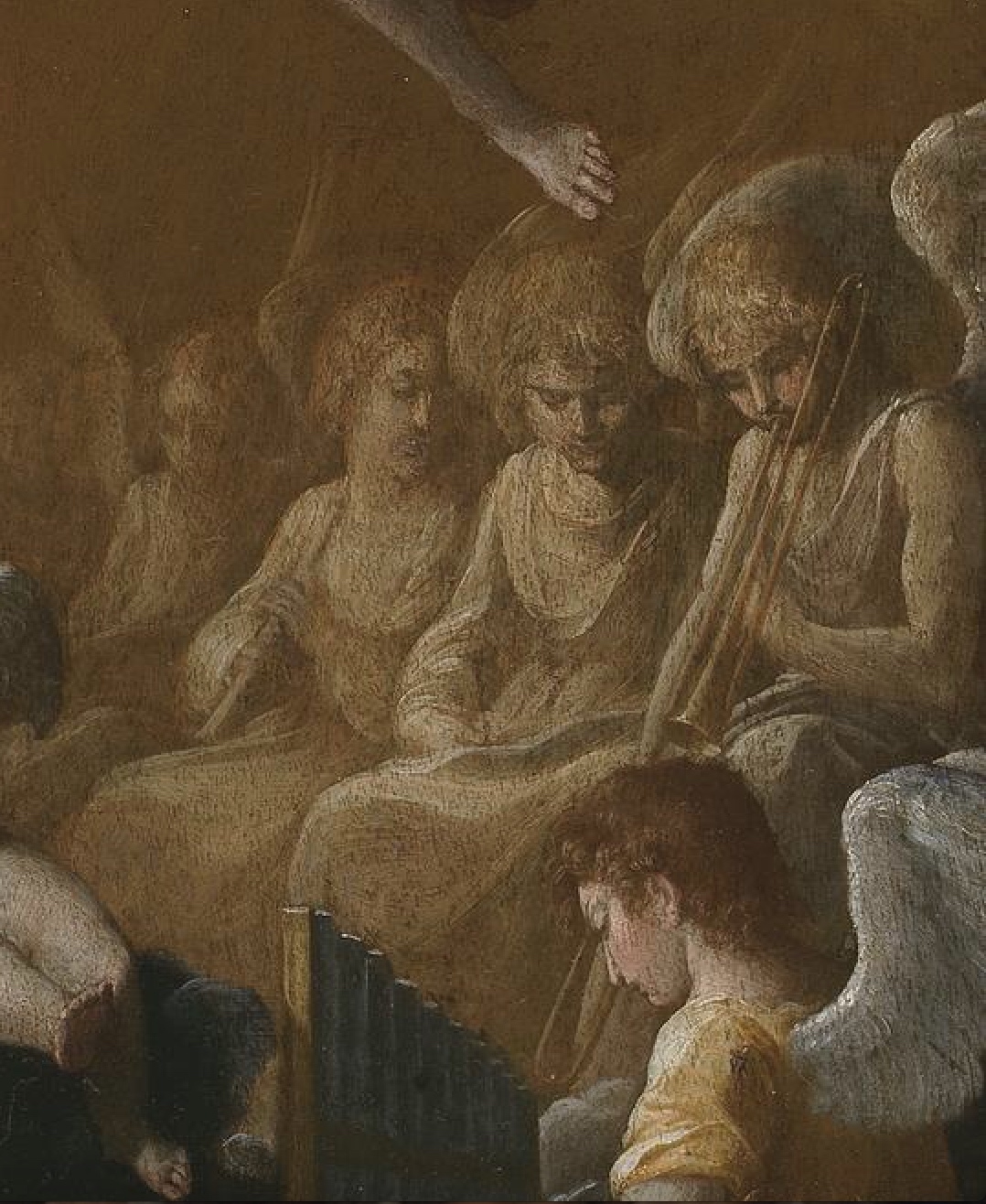
c. 1603—Permanent, salaried wind ensemble of 5 players, including trombone, is formed under duke Vincenzo I of Gonzaga. In addition to typical court functions, it performs in plays, intermedi, tournaments, jousts, and other court entertainments (Kurtzman, Trombe).
1603—England: A band of 6 Hoboies and Sagbuttes performs for the funeral of Queen Elizabeth (Whitwell, Renaissance 37).
1603—England: Records for the King’s Music begin listing “Hoboies and Sagbuttes” together instead of separately, clearly indicating that they are an ensemble of their own. The group consists of 7 (Woodfill 300).
1603—Suffolk, England: Merchant Thomas Kytson is found, upon his death, to own “One case (consort) of recorders, in number seven. Four cornutes, one being a mute cornute…. Two sackbuts….Three hoeboys, a curtall and a lysarden. Two flutes…” (Whitwell, Renaissance 153).
1603—York, England: York House Books show that the town waits own a sackbut (Woodfill 85).
1603—Venice, Italy: 5 trombones, 4 cornetts, 1 bassoon, 2 violins, and a violone perform for Christmas at St. Mark’s (Moore 81).
1603—Siena, Italy: Trombonist Alberto Gregori replaces trombonist Giovanfrancesco di Benedetto as leader of the civic wind band (D’Accone, Civic Muse 599).
1603—Venice, Italy: According to a treasurer’s note detailing the instruments employed at St. Mark’s at the midnight Mass and Christmas morning Mass, more trombones are employed than any other instrument. The instruments include 1 violin, 3 cornetti, 1 trumpet, 4 trombones, 1 bass violin, 1 bassoon, and 1 portatif (on the balcony), in addition to the 2 main organs.
1603—La Plata, Bolivia: Payment accounts for La Plata Cathedral record repairs to the sackbut (Bermúdez).
1603—Augsburg, Germany: The title page of Christian Erbach’s Modorum sacrorum sive cantionum, liber II features a woodcut with many musicians, including a trombonist (see below image; public domain) (Naylor 218).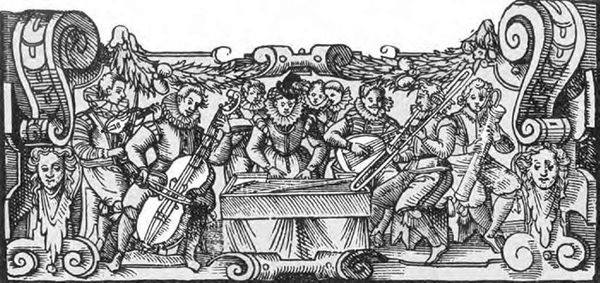
1603-05—Frankfurt, Germany: Adam Elsheimer’s, The Exaltation of the Cross, part of an altar piece of several copper panels, portrays an angel playing trombone among a group of other angel musicians. Elsheimer, known for his variety of light effects, places the trombonist near the burst of light at the top of the painting (see detail below; public domain: wikimedia commons; Städel Museum) (Klessmann).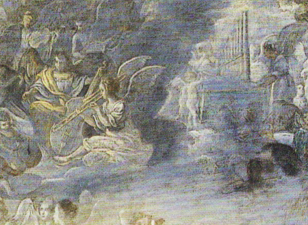
1604—Azores, Portugal: Vasco Pereira Lusitano paints Coroacão da Virgem, in which he depicts numerous instruments, including 2 trombones played by angels (see below image; public domain) (Museu Carlos Machado, Ponta Delgada, Azores, Portugal) (source: wikimedia commons).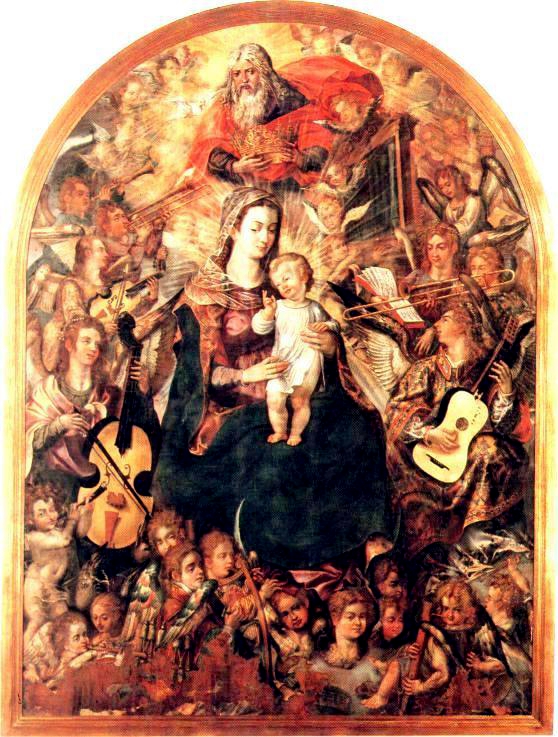
1604—Mainz, Germany: A Te Deum is performed in celebration of a coronation. Alternating verses are played by the civic wind band of cornetts and trombones and a trumpet and timpani ensemble (Whitwell, Baroque 206).
1604—Sansovino mentions Venetian musicians, “who on certain solemn days over the year play most excellently on trombones, cornettos and other, various and diverse instruments at Mass as well as at Vespers.”
1604—Duke Charles of Lorraine, wishing to procure trombonists for his court orchestra, sends to England for the best players (Daubeny 94).
1604—Mainz, Germany: The court of Johann Schweickard von Kronberg maintains a band of trombones and cornetts (Whitwell, Baroque 45).
1605—England: At Queen Anne’s, churching anthems are sung “with organ, cornetts, sackbut, and other excellent instruments of music” (Woodfill 190).
1605—Bologna, Italy: An attempt is made to teach 4 clerics at San Petronio to play trombone. The effort is apparently unsuccessful, as payments for their instruction only continue 4 months, after which 3 trombonists are recruited from Germany “per uso della Cappella” (Schnoebelen, Performance Practices at San Petronio, 44).
1605-06— Milan Italy: During a diocesan inquiry about monks’ use of outside musicians at St. Amrogio, witnesses, including a paid trombonist himself, testify to the presence of singers, violins, trombones, and cornetto, along with an occasional lute (Kendrick, Sounds of Milan 79).
1605-09—Piacenza, Italy: A fresco by Ludovico Carracci and Camillo Procaccini (also attributed to Lorenzo Garbieri) on the ceiling of the Cathedral of Piacenza includes an angel playing trombone (see below image; public domain) (Brogi pl. 203; Neilson, Camillo Procaccini, Paintings and Drawings, pl. 147).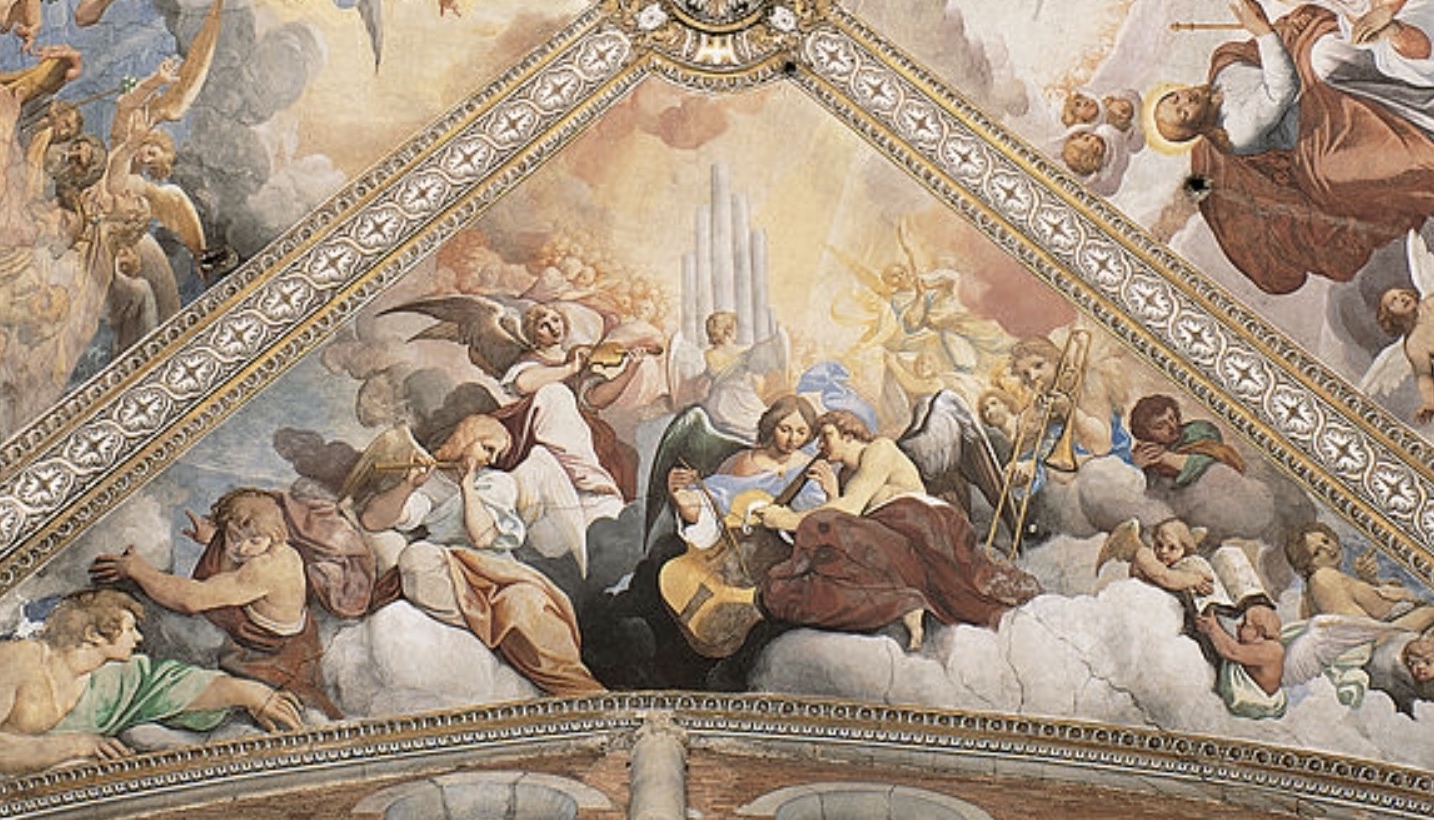
1606—Poland: Trombone is among the musical instruments named in Swiatowa rozkosz, a book of poetry by Hieronim Morsztyn (Przybyszewska-Jarminska, The History of Music in Poland: The Baroque, Part 1, p. 153).
1606—Innsbruck, Austria: Paolo Piazza’s Adorazione dei Magi, an altarpiece painting in Innsbruck’s Kapuzinerkirche, depicts many angel musicians, including an angel trombonist (see below detail; public domain) (Panchieri 43).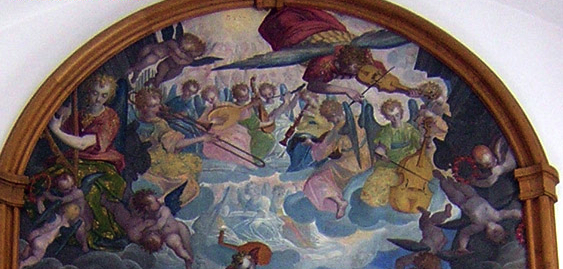
1606—Italy: Leone Leoni’s Sacri fiori includes two works that feature trombone: In te Domine speravi for 2 alto voices and two trombones, and Deus exaudi for 2 soprano voices, a trombone, and a violetta (Kurtzman, Monteverdi Vespers, 121).
1606-08—Padua, Italy: 5 “supernumeraries” (musicians not considered full-time), consisting of 4 trombones and one violin, are retained at the Basilica del Santo for music of “solemn occasions” (Roche, North Italian 22).
1606-09—Brussels, Belgium: Hendrick de Clerck’s painting, The Nuptials of Thetis and Peleus, features a group of musicians (upper-middle); among the musicians are several musical instruments resting on the ground, including what appears to be a trombone (see detail and full image below; public domain).
1607—Mantua, Italy: Monteverdi’s L’Orfeo, considered by many the first true opera, uses 5 trombones (2 altos, 2 tenors, and a bass). Trombones are particularly prominent in the underworld scenes (Daubeny 95). An ensemble of trombones and cornettos plays in acts III and IV.
1607—Jean-Baptiste Duval, French ambassador to Venice, attends the first Vespers of St. Theodore, at the Church of the Redeemer in Venice, and remarks, “There was a concert of the best musicians they had, singers as well as instrumentalists; mainly six small organs besides that of the church, which is very good, trombones or sackbuts, oboes, viols, violins, lutes, cornettos, recorders and flageolets (small flutes). Their harmony and music is very full, and they sing well according to their style which one does not relish at first, and does not find a pleasure, since it is different from our usage.”
1607—Jean-Baptiste Duval, French ambassador to Venice, visits St. Mark’s on Christmas day, hearing music in which “the double organs and different instruments, such as trombones, cornettos and treble violins were united with voices of the singers, and all this indeed filled the church and produced a grand harmony” (Kenton 35).
1607—Dresden, Germany: A depiction of a portion of a procession features a trombone player and 3 shawm players on horseback (see below image; public domain) (Dresden, Sachsische Landesbibliothek).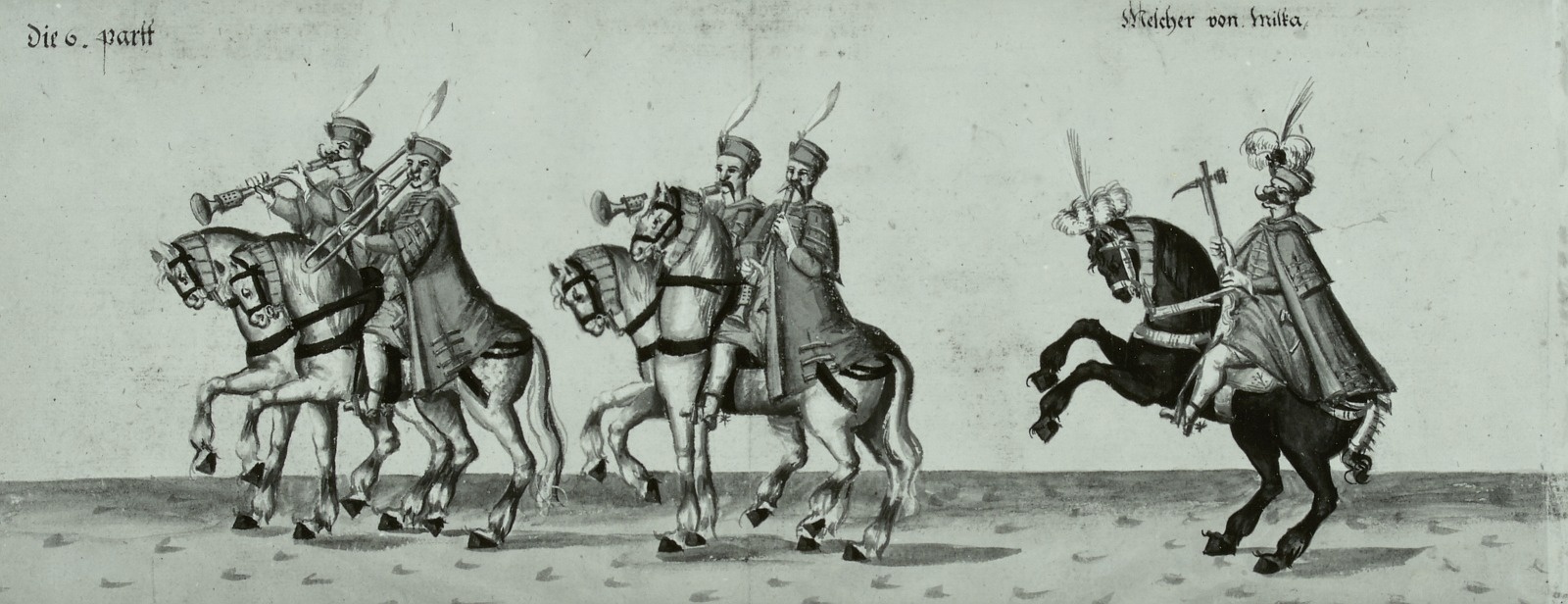
1607—London, England: King James and his son, Prince Henry, feast at the hall of the Merchant Taylors Company. Among the entertainers, according to account books, are “Mr. Laneere, and four others of his Majesty’s musicians, players of wind instruments, being placed over the screen.” The “Laneere” referred to could be any of 5 different wind-playing Laniers, at least 3 of whom play trombone, who are all in court employ at this period (Duffin, To Entertain a King).
1607—England: Lord Hay commissions a masque at Whitehall by Thomas Campion to celebrate Lord Hay’s marriage. Present at the performance is King James I. The masque features several consorts, including a 10-member group with a double sackbut (double Sack-bott) (Long Study 47; Spitzer 46).
1607—Spain: An inventory of the instrument collection of Philip II made after his death includes “four silver sackbuts, with keys; a sliver sackbut of great dimension; a soprano sackbut; a brass sackbut” (Whitwell, Renaissance 101).
1607—Lerma, Spain: Musical personnel are hired for the church of San Pedro. The initial 4 musicians are instrumentalist: 2 trombones, an alto shawm, and a bajón (Kirk, Instrumental Music in Lerma).
1607—Italy: Giulio Radino publishes a Magnificat which, though texted in all 16 parts, specifies Choro de Tromboni in 4 of the parts (Kurtzman, Monteverdi Vespers, 124).
1607—Italy: A posthumous print of Giulio Radino Padavano’s Concerti per sonare et cantare includes works by several composers. Amadio Freddi’s O Domine Iesu, which is included in the collection, is texted in all voices, but has a rubric calling for trombone in every part except the cantus. The Padavano collection also contains Media nocte, a 12-part motet by Orindio Bartolini that calls for trombone in the texted part-book (Kurtzman, Monteverdi Vespers, 121).
1607—Siena, Italy: Agostino Agazzari writes his first and most influential treatise, Del sonare sopra il basso. He includes trombone in the category of “ornamenting” instruments, responsible for embellishing the bass line with interpolated notes (passagi) and devising counterpoint. Agazzari also writes, “Sometimes in small consorts, when there are organetti in the octave above, the trombone replaces the double bass, but it must be well and softly played” (Agazzari 65).
1607—Germany: The title page to Michael Praetorius’s collection, Musicae Sionae, features an ornate woodcut that includes a depiction of trombone (see middle-right of below image) (public domain; source: wikimedia commons).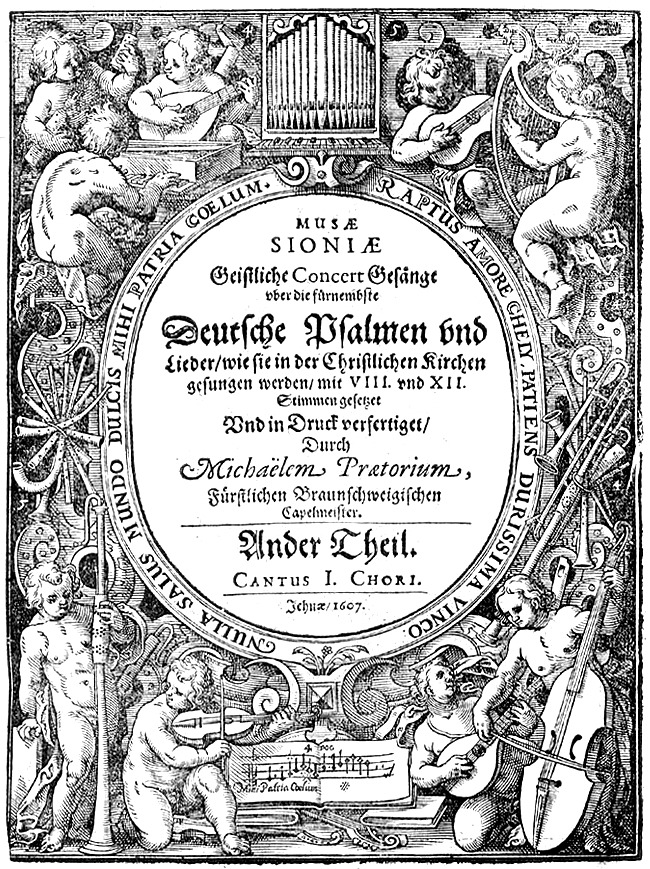
1607—Hamburg, Germany: At the dedication of St. Gertrude’s Chapel, trombones participate in polychoral works by Praetorius and Jacob Handl (Gable, St Gertrude’s Chapel).
1607-1700—According to Anthony Baines, during this time span there exists a Nuremberg-made trombone “for about every three of four years, including at least seventeen in the tenor range, five basses (mostly pre-1650) and five altos (post 1660)” (Baines, Brass 111).
1608—Venice, Italy: English traveler Thomas Coryat attends a performance at the Scuola San Rocco that includes a 20-voice vocal choir and 24 instrumentalists: 10 trombones, 4 cornetts, 2 violas da gamba, 1 violin, and 7 organs. Clearly overwhelmed, Coryat remarks, “This feast consisted principally of Musicke, which was both vocall and instrumentall, so good, so delectable, so rare, so admirable, so super excellent, that it did even ravish and stupifie all those strangers that never heard the like” (Glixon, Honoring God 157).
1608—Venice, Italy: Raverii’s 1608 collection, Canzoni per Sonare con ogni sorte di stromenti, includes Claudio Merulo’s Canzon vigesimaterza a 5 and Canzon decimaottava a 5.
1608—Florence, Italy: Il tempio della Pace, an intermedio by Michelangelo Buonarroti that makes use of polychoral techniques, written for the wedding of Cosimo de’ Medici to Archduchess Maria Magdalena, includes multiple trombones (Carter, A Florentine Wedding).
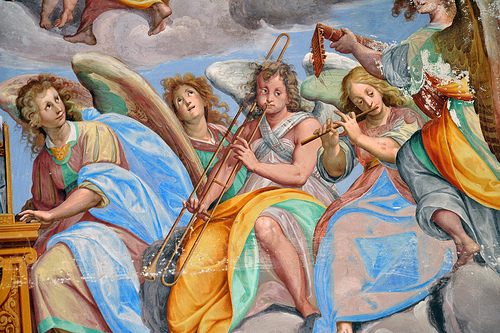
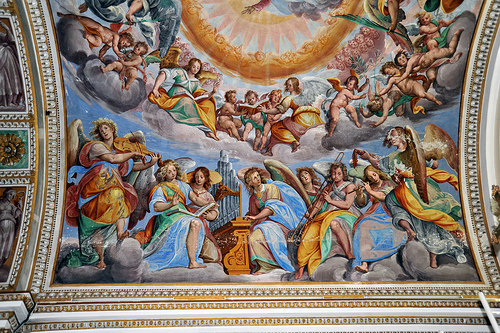 1608—Gravedona, Italy: Glory of God the Father and the Angels, a fresco by Giovanni Mauro della Rovere (also known as Fiammenghino), located in the Church of Santi Gusmeo e Matteo, includes a depiction of what could be a trombone. The instrument has characteristics of both slide trumpet and trombone; it could simply be an awkwardly-rendered depiction of either instrument. Other nearby angel-musicians play viol, organ, flute, and lute (see facing detail and medium detail below; public domain) (Angelis 43).
1608—Gravedona, Italy: Glory of God the Father and the Angels, a fresco by Giovanni Mauro della Rovere (also known as Fiammenghino), located in the Church of Santi Gusmeo e Matteo, includes a depiction of what could be a trombone. The instrument has characteristics of both slide trumpet and trombone; it could simply be an awkwardly-rendered depiction of either instrument. Other nearby angel-musicians play viol, organ, flute, and lute (see facing detail and medium detail below; public domain) (Angelis 43).
1608—Modena, Italy: During the visit of Isabella of Savoy, Paolo Bravusi conducts a performance of 5 trombones and 3 cornetts (Whitwell, Baroque 187).
1608—The earliest extant work by Heinrich Schütz, Ach wie sol lich doch in Freuden leben (Ah how shall I still live in joy), calls for 3 “choruses”: soprano voice with 3 lutes, soprano voice with 3 violas, and soprano voice with 3 trombones (Smallman 12).
1608—England: A decree at Exeter states that Peter Chambers “shalbe considered for his instruments, viz one doble Sackbutte and one single Sackbutte as shalbe in reason thoughte fitte” (Payne 146).
1608—England: Shakespeare includes the following reference to sackbut in Coriolanus: “The trumpets, sackbuts, psalteries, and fifes, Tabors and cymbals and the shouting Romans, Make the sun dance. Hark you!” (Long Histories 226).
1608—Nancy, France: An engraving by Friedrich Brentel depicting the funeral of Charles III, Duke of Lorraine, includes 2 trombonists performing with other musicians in a loft of St. François Church (see detail and full image below; public domain) (“Obsequies of Charles III, Duke of Lorraine,” Bibliotheque Nationale, Paris; see also Lesure 60 and Whitwell, Baroque 25). Funeral records of the event indicate, “The last high Mass was performed by singers from the ducal chapel [along with] cornetts, dulcians [gros haultbois] and sackbuts” (Bowles, Music in Court Festivals of State). Click to expand detail. You can also find the image online at the Metropolitan Museum of Art.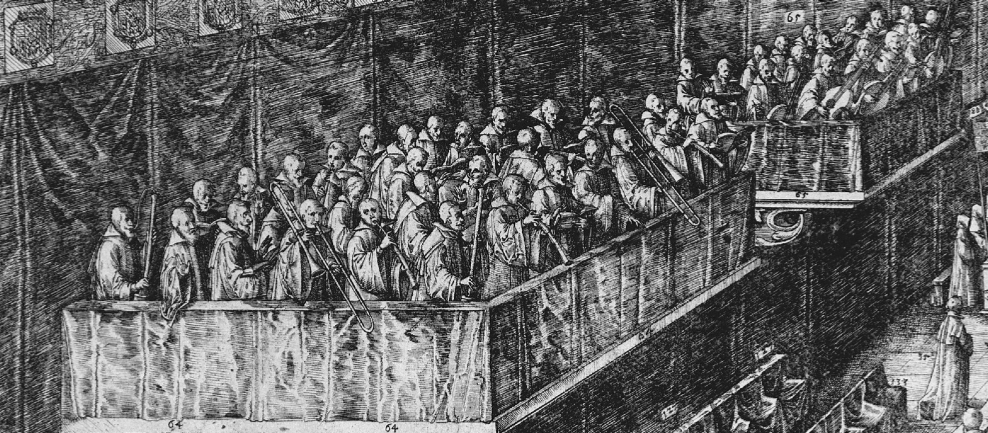
1608—Venice, Italy: Tiburtio Massaino, maestro di cappella at Lodi from 1600 to 1608, writes for a pure consort of 8 trombones and continuo in Canzon 33 per 8 Tromboni from Canzoni per sonare con ogni sorte di stromenti (Massaino).
1608—Venice, Italy: Il primo libro de’ concerti ecclesiastici…, a collection of vocal music by Arcangelo Crotti, includes numerous works that specify trombone. Among them are Sonata sopra Sancta Maria (soprano, 2 violins or cornetts, trombone, organ), O sacrum convivium (soprano, cornett, trombone, organ), Congratulamini (soprano, cornett, trombone, bass instrument, organ), and Pater peccavi (soprano, cornett, 3 trombones, organ) (Collver 101).![]()
![]()
![]()
1608—Salzburg, Austria: A single trombonist is included in the orchestra maintained by the Salzburg court (Chafe 37).
1609—Stuttgart, Germany: At the wedding celebrations of Archduke Johann Friedrich of Württemberg-Teck and Markgräfin Barbara Sophia of Brandenburg, a trio of trombone, cornetto, and bombard is featured in the Entourage of Young Court Noblemen (see below image; public domain) (Bowles, Musical Ensembles 177). In a separate performance, “As soon as the noble party had arrived at the [court] chapel, there could be heard the trombones, trumpets and kettledrums [along] with two choruses placed opposite each other” (Bowles, Timpani 370). Also in connection with the celebrations, according to records of the time, “There was a completely glorious musical performance, with 20 voices and five ensembles with all kinds of instruments, such as lutes, fiddles, bassoons, dulzians, cornetts, trombones and others” (Bowles, Musical Ensembles 167).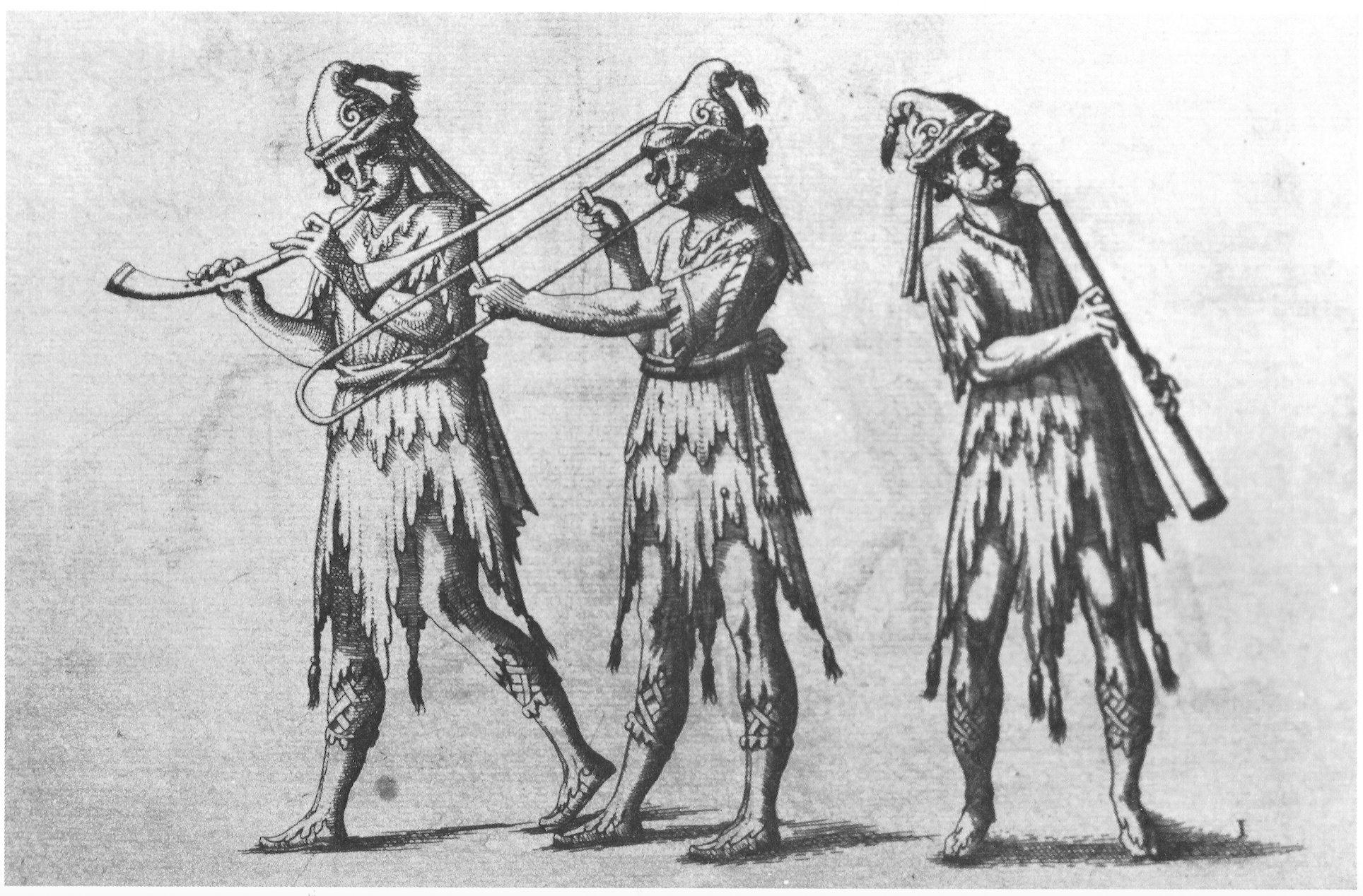
1609—Jasna Góra, Poland: At the Pauline monastery at Jasna Góra an admonition following a visit by Bishop Piotr Tylicki advises “that those skilled in playing the trombone conduct themselves in the gallery in such a way that from this may arise no cause for indignation” (Przybyszewska-Jarminska, The History of Music in Poland: The Baroque, Part 1, p. 104).
1609—Rome, Italy: Guido Reni’s Gloria d’angeli, a fresco located in S. Gregorio Magno, Cappella di S. Silvia, includes 2 trombones (see 2 details and full color image, below; click on picture to expand; images public domain) (Cavalli, pl. 28 and 32; Pepper, pl. 30). A drawing pictured above (see 1600s—Southern Netherlands) is clearly either a preparatory sketch for or a copy of Reni’s painting.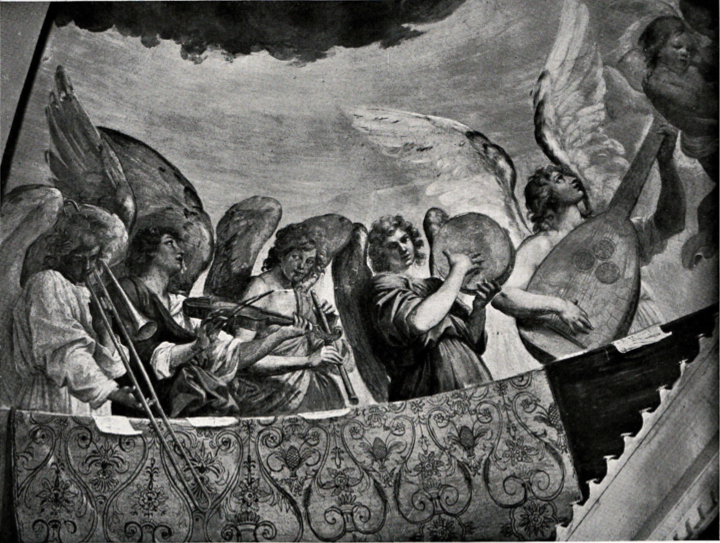
1609—Jean-Baptiste Duval, French ambassador to Venice, again visits the Church of the Frari in Venice (see 1608, above), this time hearing music performed by “two portative organs, trombones, lutes, theorboes, cornettos and bass violins.” He then remarks, “Those who are accustomed to their music find it very good and full” (Kurtzman, Monteverdi Vespers 114).
1609—Prince Francesco, setting up his court as governor of the Mantuan province of Monferrato, seeks assistance of Ercole Gonzaga in hiring group of pifferi from Cremona (Kurtzman, Trombe). Claudio Monteverdi is also engaged in assisting Prince Francesco, and refers to the players he is recruiting in a letter to the court secretary: “You will be doing me a kindness by letting the said Prince know that I have spoken to those cornett and trombone players [“sonatori di cornetto et trombone”], as he commissioned me to do, and that they told me they will come and serve His Highness, but on these two conditions: one, that they would like to be helped by His Highness with letters of request to the Count of Fuentes (or to whom it my concern) so that they can draw some wages which fall due after the Count of Fuentes leaves for the state of Milan; and so that Your Lordship may understand, these wages are due because they play in the castle at Cremona. And the other point is that the father and two sons who play all the wind instruments would each like 12 scudi a month. I objected to this at once, and told them that His Highness would go up to eight, with which (it seems to me) they should be contented. They have not said either yes or no about it. The two others, because they are not as competent as these three, could I believe be had for less salary. They play together well and readily both dance and chamber music, since they practise every day” (Stevens Letters 64).
1609—Bologna, Italy: Adriano Banchieri describes a mass he composed for 4 choirs that included, in addition to several continuo instruments, violins, viole da gamba, and 3 trombones (Schnoebelen Bologna 1580, 113).
1609—Italy: A number of Girolamo Giacobbi’s psalms are scored for coro ordinario (SATB) and coro grave (alto voice with 3 trombones) (Roche, North Italian 120).
1609—Italy: Lodovico da Viadana’s Cento concerti III includes Repleatur, a concertato work for alto voice, tenor voice, and 2 trombones. It also includes Benedicam Dominum in omni tempore for 2 tenor voices and 2 trombones (Roche, North Italian 82; Kurtzman, Monteverdi Vespers 123).
1609—Italy: A motet titled Cantate Domino contains the following rubric at the beginning of the piece: “To be concerted with two violins and two trombones” (Kurtzman, Monteverdi Vespers, 123).
1609—Italy: Ercole Porta calls for violin and trombone in his 2-part Sinfonia (Winkler 298).
1609—St. Omer, France: A document about musical practices at a Jesuit school describes the trombone as Tuba ductilis (Herbert, Sackbut 70).
1609—St. Omer, France: A document describes the elements of a good music education for boys, listing sackbuts and cornetts among suitable instruments (Herbert, Sackbut 78).
1609—Dresden, Germany: Artist Daniel Bretschneider depicts a procession of elaborately-costumed musicians featuring 3 string players and a trombone player. The musicians are part of a larger carnival procession (see detail below; public domain) (Bildindex der Kunst und Architektur).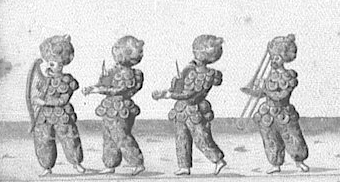
1609—Dreseden, Germany: Artist Daniel Bretschneider depicts an elaborately-costumed ensemble of 2 trombones and 2 cornetts, part of a larger carnival procession (see detail below; public domain) (Bildindex der Kunst und Architektur). 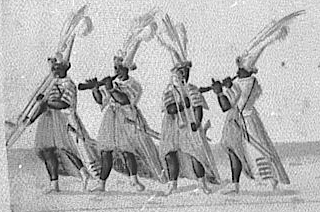
1609—Dresden, Germany: Artist Daniel Bretschneider depicts a wind band consisting of 3 trombones and 3 cornetts in Roman garb. The ensemble is part of a larger carnival procession (see detail below; public domain) (Bildindex der Kunst und Architektur).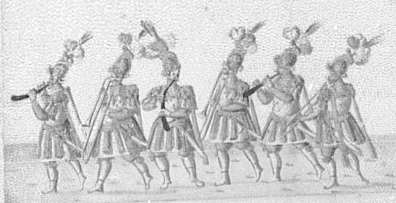
1609—Dresden, Germany: Artist Daniel Bretschneider depicts an apparently all-female wind band comprised of 4 trombones and 4 cornetts. The ensemble forms part of a larger carnival procession (see detail below; public domain) (Bildindex der Kunst und Architektur).
1609—Dresden, Germany: Artist Daniel Bretschneider depicts an ensemble of Moorish musicians in procession (see detail below; public domain) (Bildindex der Kunst und Architektur).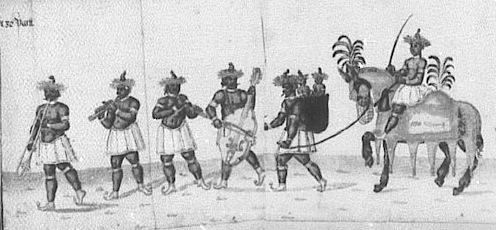 1609—Dresden: Artist Daniel Bretschneider depicts a group of 3 Moors playing wind instruments as part of a procession. The two instruments on the outside appear to be shawms, the one on the inside a trombone (see detail below; public domain) (Bildindex der Kunst und Architektur).
1609—Dresden: Artist Daniel Bretschneider depicts a group of 3 Moors playing wind instruments as part of a procession. The two instruments on the outside appear to be shawms, the one on the inside a trombone (see detail below; public domain) (Bildindex der Kunst und Architektur).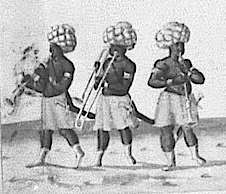 1609—Dresden: Artist Daniel Bretschneider portrays a group of 7 musicians in procession. The individual instruments are difficult to distinguish; however, the 5th musician appears to be playing a trombone (see detail below; public domain) (Bildindex der Kunst und Architektur).
1609—Dresden: Artist Daniel Bretschneider portrays a group of 7 musicians in procession. The individual instruments are difficult to distinguish; however, the 5th musician appears to be playing a trombone (see detail below; public domain) (Bildindex der Kunst und Architektur).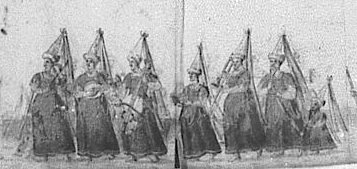
1609—Wittenberg, Germany: Johann Schein says, in his song Frisch auf, de edle Musikkunst from Venus Kräntzlein, “Summon with the noise of cornetts, the sound of trombones (Posaunen), curtals and Sordanen, with pommers too, the gentle sound of recorders, with crumhorns” (Boydell, Crumhorn 71).
c. 1610—Belgium: Hendrick de Clerck’s painting, Minerva and the Muses, includes a trombone resting on some foliage in the foreground of the painting (see bottom-left of below image; click for larger image; public domain).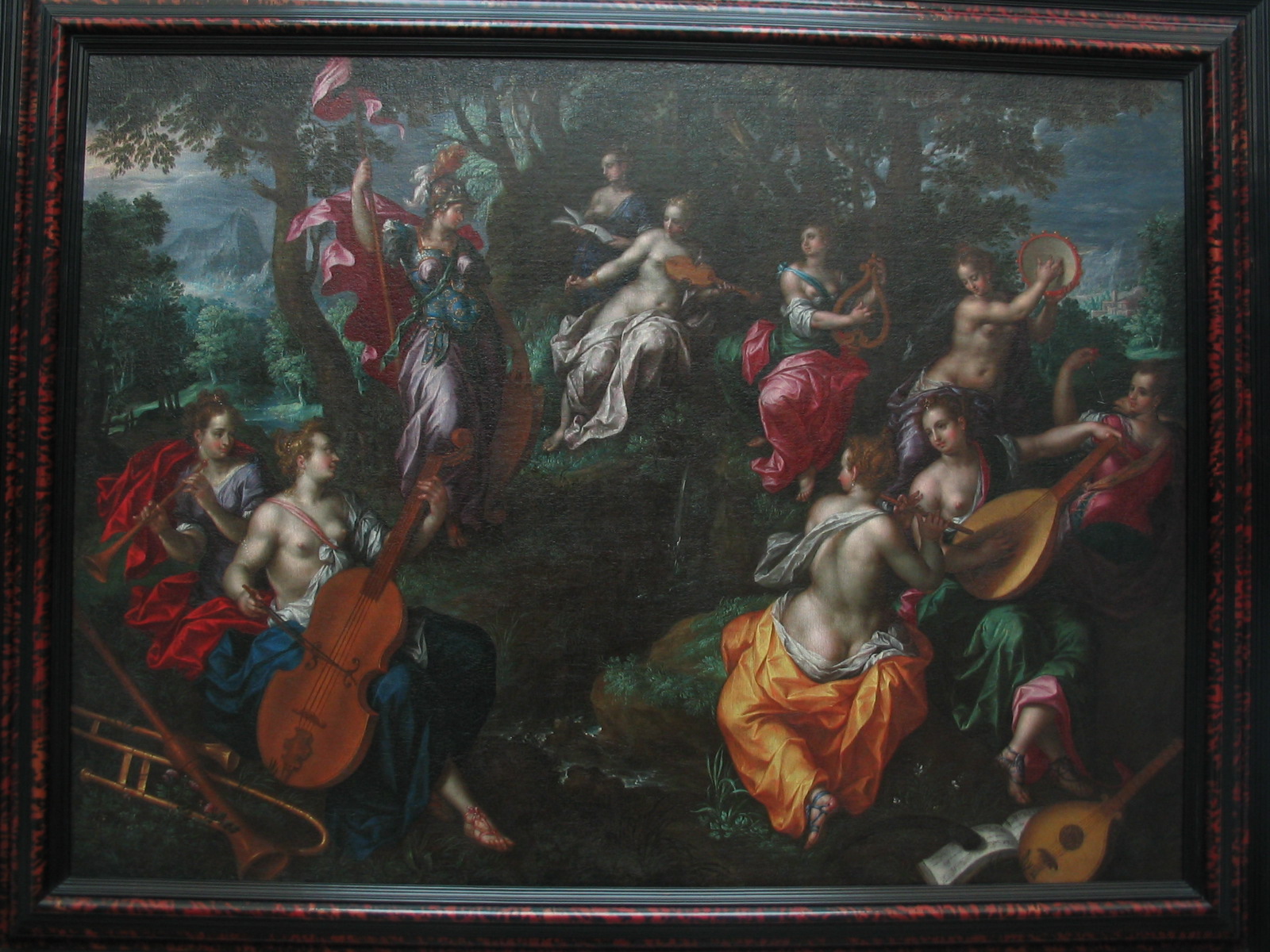
c. 1610—Antwerp, Belgium: Hendrick van Balen’s painting, The Banquet of the Gods, includes a trombone resting on the ground among several other instruments (see bottom right of below detail; public domain image). For other paintings by the same artist that include trombone, see c. 1615 and c. 1625.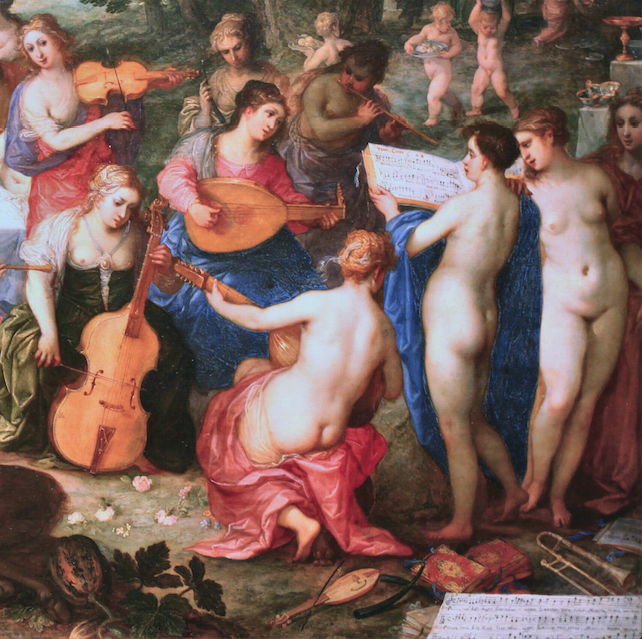
c. 1610—The Judgment of Midas, a painting by Flemish artist Adriaen van Stalbemt, includes a trombone. As in numerous Flemish paintings, the trombone rests on the ground rather than being played (see below image; public domain). 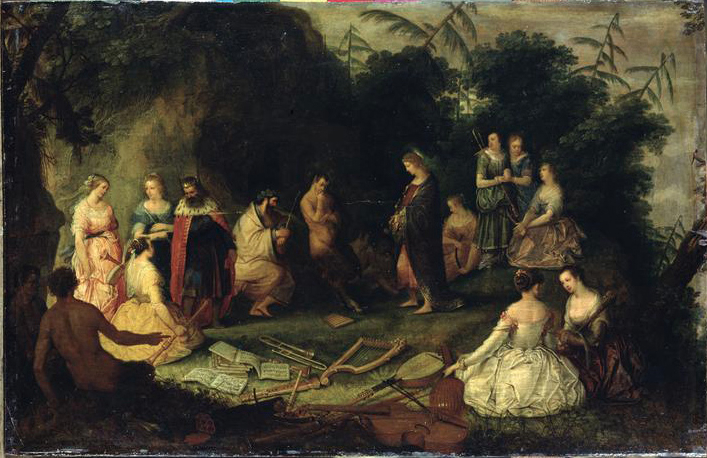
c. 1610—Apollon défié par Marsyas, a painting attributed to Frans Francken (1581-1642), includes a trombone resting on the ground (see below image; public domain) (National Library of France).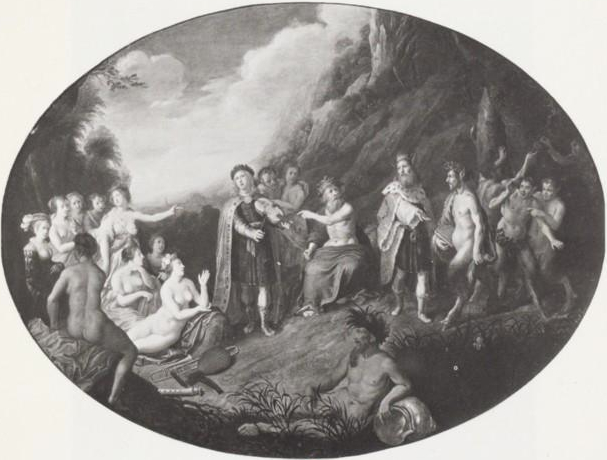
c. 1610—Flemish artist Adriaen van Stalbemt (1580-1662) includes a somewhat awkwardly-rendered trombone in his painting, Landschaft mit Minerva (see detail below; public domain) (National Library of France). For numerous other images by Flemish artists depicting trombones resting on the ground, see here.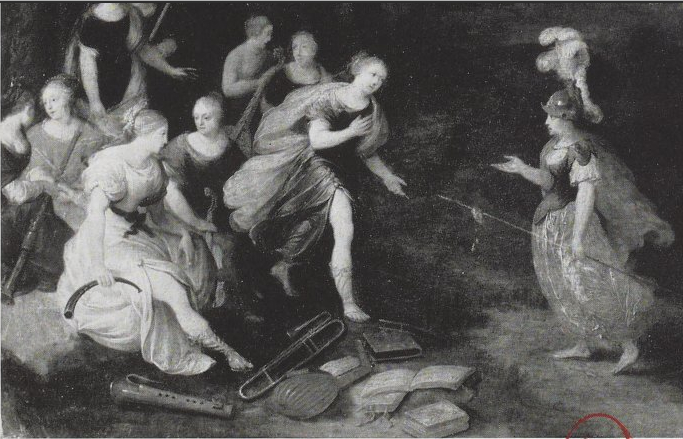
c. 1610—Wedding at Cana, a painting by Flemish artist Frans Francken II (1581-1642) depicts musicians playing trombone, bass viol, viola da braccio, lute, and cornetto (see below image; public domain) (French National Library).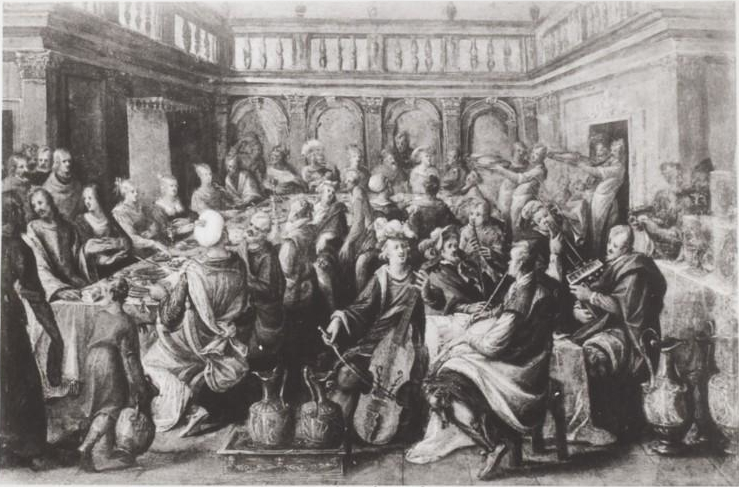
c. 1610—Rome, Italy: Lionello Spada’s painting, Concert, which shows a group of musicians presumably preparing for a performance, includes a clear depiction of a musician removing the outer slide of a trombone (see below image; public domain) (Egan; Monducci 81).
c. 1610—Loreto, Italy: Artist Cristoforo Roncalli, known as “Pomarancio,” makes a set of preparatory red chalk drawings for a fresco to be painted on the cupola of the Basilica di Loreto (fresco now largely lost). Among the drawings are several angel-trombonists. Notice the particular attention the artist seems to pay to the grip of both the left hand and the slide hand in the bottom 2 sketches (see below 3 images; public domain) (Chiappini Di Sorio 194; Polichetti).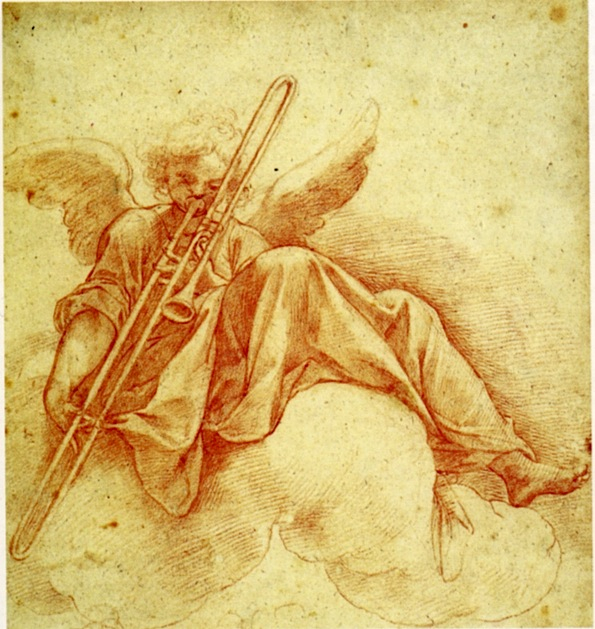
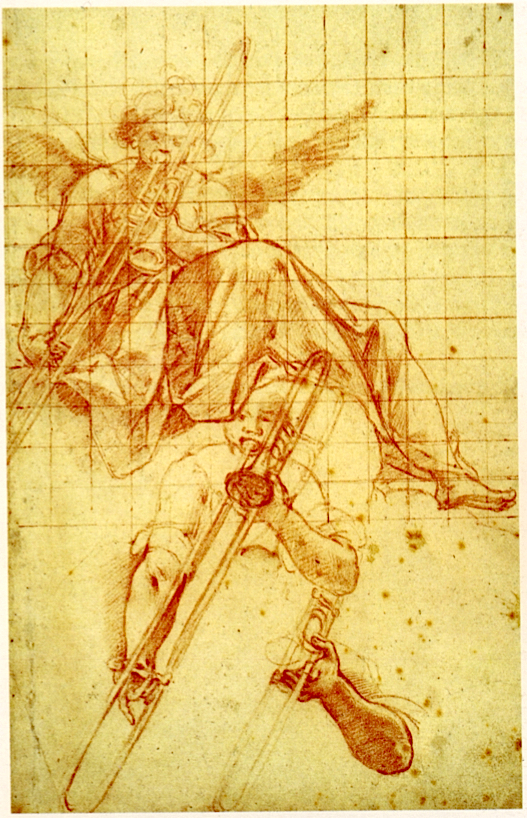
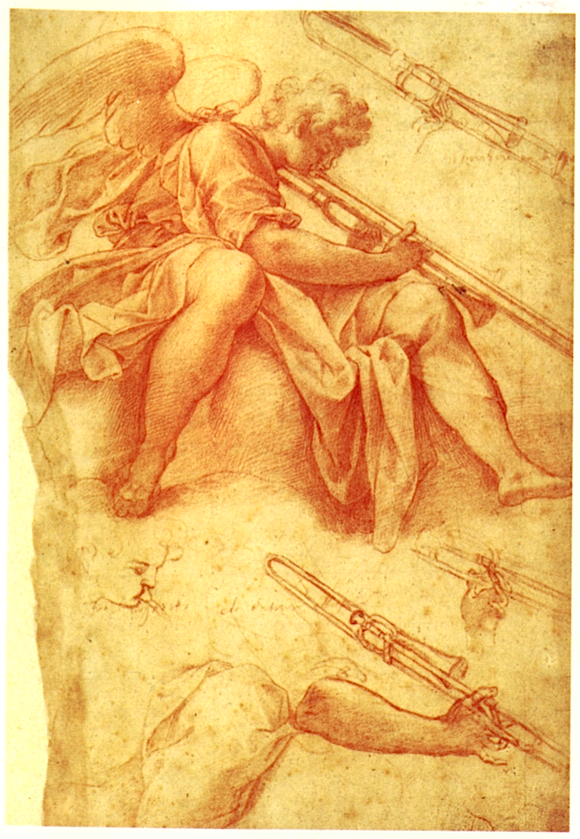
c. 1610—Mantua, Italy: Antonio Maria Viani’s Parnassus as Allegory of Mantuan Literary Glory, located in the Hall of Mirrors of the Ducal Palace, features what appears to be a woman holding a trombone (see detail and full image below; public domain) (special thanks to John Rojak).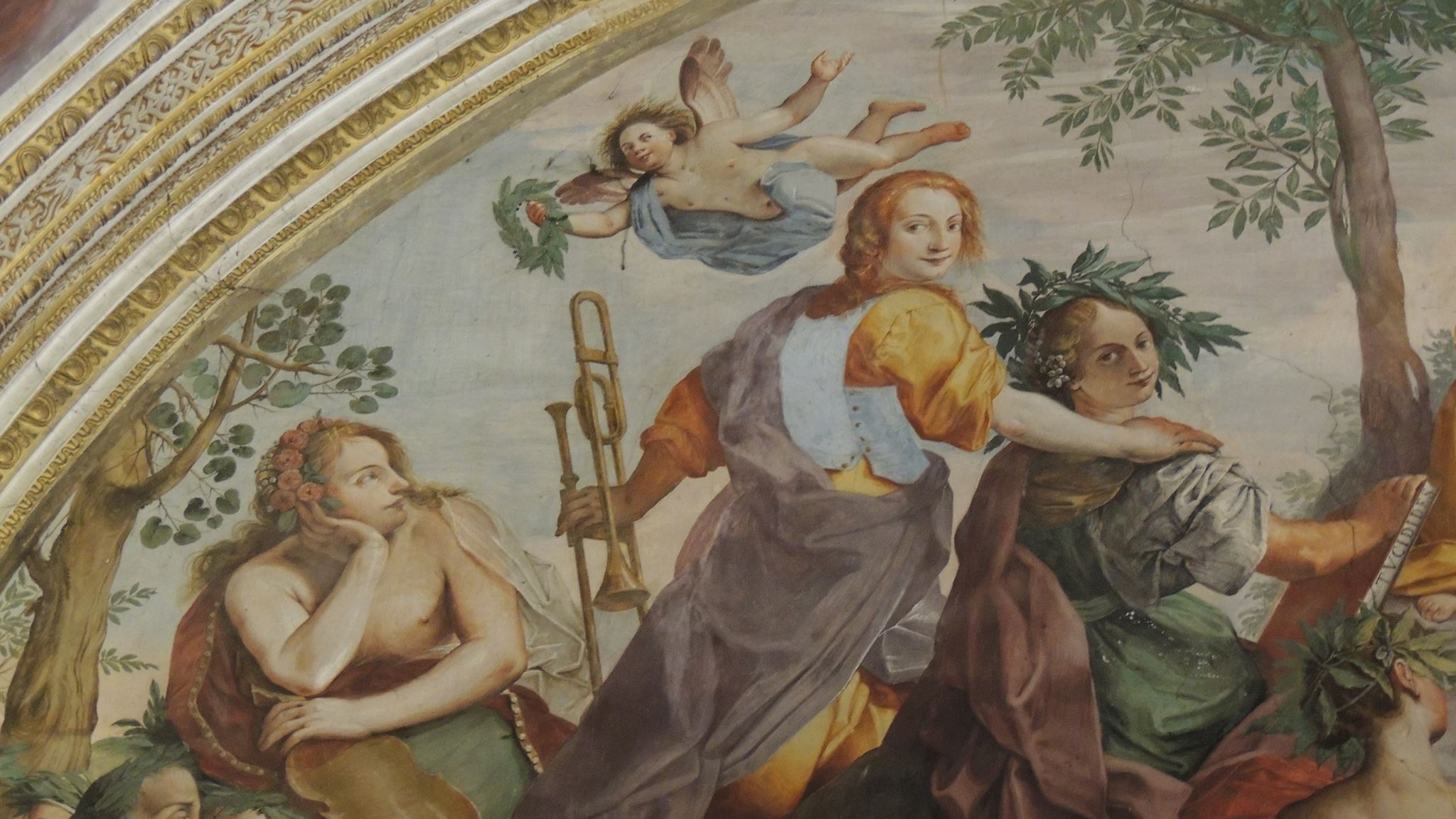
1610—Canterbury, England: A quartet of instrumentalists consisting of 2 trombones and 2 cornetts is retained at the Canterbury Cathedral. The group’s functions is “to make music in the quire” of the Cathedral, on feast days, and on vigils (Bowers 440).
1610—Bologna, Italy: The instrumental ensemble of Santa Petronio includes 7 trombones, 2 cornetts, and 1 violin. Strings are gradually added later (Schnoebelen Bologna 1580, 106).
1610—Bologna, Italy: Adriano Banchieri writes a collection of 21 motets. Following the last page of music, the composer gives a table of several ways the motets may be performed; among the ways are “Trombone & Violino Stromenti” and “Basso Trombone & Soprano voce” (Collver 42).
1610—Siena, Italy: A musician by the name of Pietragnolo Maestri resumes employment as cathedral trombonist, where he contiues to serve until 1613. He had previously served from 1597 to 1601 (Reardon, Agostino Agazzari 53).
1610—Venice, Italy: Monteverdi’s 1610 Sextus part-book reveals what may be a doubling practice for trombonists of the time. As musicologist Andrew Parrott puts it, “At ‘Quia respexit’ the cornett III part shares a stave with trombone I, making it entirely feasible in this verse for one and the same player first to play cornett (of one size or another), then tenor sackbut, and finally cornett again, using the intervening woodwind duets to switch instruments” (Parrott, Monteverdi: Onwards and Downwards).
1610—France: Louis XIII maintains a court wind band that includes 2 trombones (Whitwell, Baroque 24).
1610—Italy: Lodovico Viadana, Sinfonia “La Bergamasca” for 8 instruments, from Sinfonie musicali.
1610—Italy: Claudo Monteverdi composes Vespers, which uses trombones prominently. Only 3 pieces in the collection specify particular instruments; in all 3 of these, trombone is named (Domine ad Adjuvandum, Sonata Sopra Sancta Maria Ora Pro Nobis, and Magnificat a Sette Voci) (Holman, Col nobilissimo; Kurtzman, Monteverdi Vespers, 412). In Sonata sopra Sancta Maria, not only does Monteverdi call for trombone, but he suggests the instrument as a substitute for the vivola da brazzo part (Bonta Violone 69). In Domine ad Adjuvandum, the instrumental bass part is marked, “Trombone, Contrabasso da gamba, & Viuola da brazzo” (Holman, Col nobilissimo).
1610—Milan, Italy: Giovanni Paolo Cima specifies trombone in works from his collection Concerti ecclesiastici, including Sonata (trombone or violone) and Cappriccio d’Andrea Cima a 4 (1 trombone) (Collver 47).
https://www.youtube.com/watch?v=toCLNOkQq5A
1610s—Ravenna, Italy: Carlo Bononi’s painting, Convito di Assuero, includes a trombone among a group of musicians in a loft (see upper left of below image; public domain).
1610-1611—La Plata, Bolivia: La Plata Cathedral employs a trombonist by the name of Antón de Toledo. Accounts also contain records of repairs for shawms, trombones, and curtals (Bermúdez).
1611—London, England: Trombones participate as part of the “Winde Musick” in an elaborate pageant-procession on the eve of the coronation of Charles II (Halfpenny, The Entertainment of Charles II).
1611—Pieter de Witte (also known as Peter Candid and Pietro Candido) includes an angel playing trombone in his drawing, Euterpe (see bottom-left of below image; public domain) (Volk-Knüttel 102).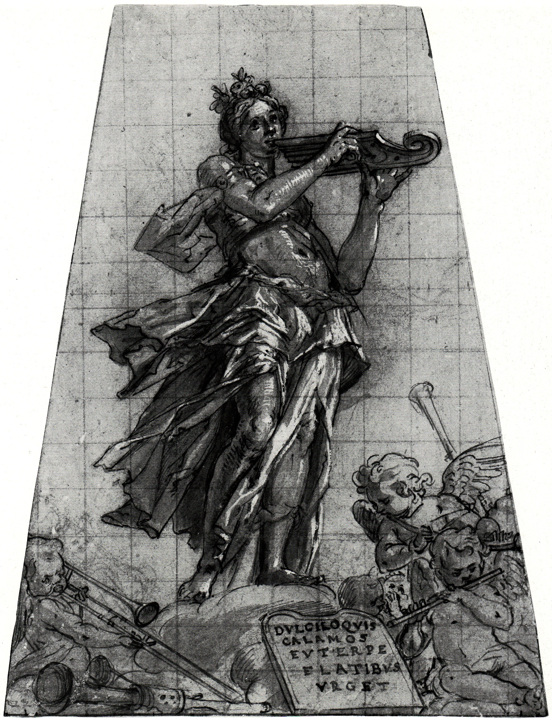 1611—London, England: Randle Cotgrave’s A Dictionarie of the French and English Tongues includes the following entry for the word Sarbacane: “Sarbacane, or (which is better) Sarbataine: A long trunke to shoot in; also, the musicall Instrument called a Sagbut” (Dart, Music and Musical Instruments in Cotgrave’s Dictionarie).
1611—London, England: Randle Cotgrave’s A Dictionarie of the French and English Tongues includes the following entry for the word Sarbacane: “Sarbacane, or (which is better) Sarbataine: A long trunke to shoot in; also, the musicall Instrument called a Sagbut” (Dart, Music and Musical Instruments in Cotgrave’s Dictionarie).
1611—Italy: Arcangelo Borsaro’s Novo giardino de concerti specifies optional substitution of trombones for the lower 2 voices in each of its 20 motets (Kurtzman, Monteverdi Vespers 123).
1611—Mantua, Italy: In a letter from Claudio Monteverdi to Prince Francesco Gonzaga (governor of Mantuan province of Monferrato), Monteverdi reveals that he is still trying to help the prince establish a wind band (see 1609 entry, above). He says, “Your Highness left instruction with Messer Giulio Cesare [Bianchi] the Cremonese (who plays the cornetto) that if someone could be found who would play the recorder, cornetto, trombone, flute and bassoon—for want of a fifth part in Your Highness’s wind band—you would be pleased to take him on. I therefore approach this letter of mine to let Your Highness know that there is a young man here of about twenty-six or twenty-eight (I do not know whether he is passing through or has come on purpose) who can play on the afore-mentioned instruments very readily at least, and with assurance, because I have heard him play both recorder and cornetto; moreover he says that he can also play the gamba and the viola….As is my custom, I sounded him out and told him: ‘If His Highness the Prince were pleased to take you on, this gentleman very much likes not only to hear a variety of wind instruments, he also likes to have the said musicians play in private, in church, in procession, and atop city walls; now madrigals, now French songs, now airs, and now dance-songs.’ And he told me in reply that he would do everything, as he will always consider it great good fortune, this becoming fit to be allowed to serve the likes of Their Highnesses in some way” (Stevens Letters 81).
1611—Lima, Peru: The chapel hires a trombone player (Mendoza de Arce 140).
1611—Mexico City, Mexico: The cathedral trombonist receives a raise (Stevenson, Mexico City Cathedral Music).
1611—Italy: Amante Franzoni writes Canzon francese for 2 trombones, cornetto, and organ. The piece is part of a large collection called Concerti ecclesiastici (Collver 50).
1611—Salzburg, Austria: 2 trombones are included in the orchestra maintained by the Salzburg court (Chafe 37).
1611/12—England: A shagbutt is repaired at Trinity (Payne 146).
1612—Mombello, Italy: A fresco painted by Giovanni Battista de Advocatis in chiesa parrocchiale dell’Invenzione di Santo Stefano features a large group of angels playing musical instruments, including trombone (see below image; public domain).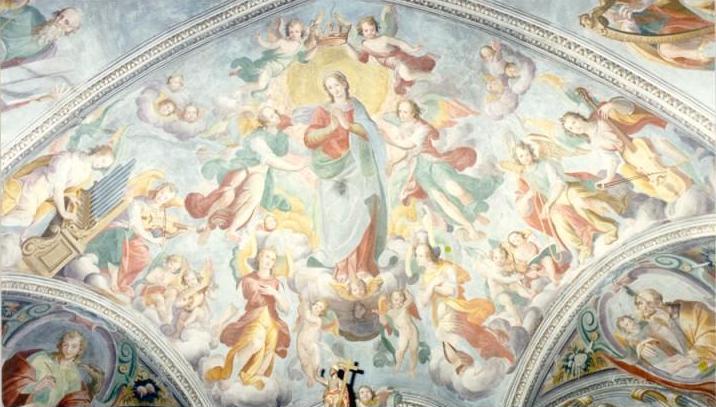
1612—Manufacture date of the bass trombone that historian Anthony Baines calls “the most beautiful trombone in existence” (Young 22). It is also, according, to Robin Gregory, “the oldest known Quintbass trombone in existence” (Gregory 33). In addition to the flat stays, conical bell, and hinged slide extension typical of this period, it has two extra turns of tubing at the top, with a supplementary slide extension for this upper section of tubing. The manufacture location is Nuremberg, a city famous for brass instrument manufacturing (Germanisches Nationalmuseum, Nuremberg) (Montagu 105).
1612—According to Philip Bate, a trombone with a double slide, made by Jobst Schnitzer, survives from this date (Bate 136).
1612—Italy: Lodovico da Viadana’s Salmi a Quattro chori contains instructions for performing his polychoral works for 4 choirs. In the third choir, he instructs, “the tenor is sung by several voices, with trombones.” In the fourth choir, “the [second] part is in a comfortable tenor register, sung by a number of voices with trombones; the third part is a baritone—again, this should have good voices or trombones, with violins. The bass is always low, so it should be sung by deep voices with trombones…” (Roche, North Italian 118).
1612—Bologna, Italy: Adriono Banchieri composes his Moderna armonia di canzoni alla francese. In the foreword, he suggests trombone as one of many options for performing the work (Collver 42). Numbers 11 through 25 are 2-part works (trombone and cornett), and numbers 26 and 27 are 4-part works (2 trombones and 2 cornetts) (Winkler 298).
1612—England: Records for the King’s Music list Sackbuts and Hautboys together rather than separately. The group consists of 7 (Woodfill 301).
1612—Cuenca, Spain: A musician by the name of Juan García Sotos Albos is appointed as a trombonist at Cuenca Cathedral (De Pascual).
1612—Madrid, Spain: Trombonist Bartolomé de Selma leaves employment as trombonist at Cuenca Cathedral to become instrument maker to the royal chapel in Madrid.
1612—Poland: Musical instruments enumerated in a list of possessions left on the death of Albert Zielinski, owner of Strzalkow, over which a court case is disputed, include 3 trombones (Przybyszewska-Jarminska, The History of Music in Poland: The Baroque, Part 1, p. 72).
1612—Salzburg, Austria: A single trombonist is included in the orchestra maintained by the Salzburg court (Chafe 37).
1613—Heidelberg, Germany: The welcoming festivities for Elector Friedrich V of the Rhine Palatinate and his Bride, Princess Elizabeth of England, include a series of triumphal arches constructed along the streets by the faculties of the University of Heidelberg. At the first arch, staged by the Faculty of Philosophy, “pleasing music was [performed] by trombones and cornetts.” The festival record continues, “His Highness the Elector, as well as his spouse, were received with a cordial and very lovely musical [performance with] all kinds of string-playing and [other] instruments. Up high [on the stage] stood an angel who blew on two [sic] sackbuts….When His Highness the Elector, as well as the princes, were escorted in the procession by the four faculties of the world-famous University of Heidelberg, [they] passed through four triumphal arches [surrounded by] many well-wishers. Upon the first archway, which was hung with tapestries, sweet music by sackbuts and cornetts was presented” (Bowles, Musical Ensembles 188). A graphic representation of the welcoming ceremonies depicts a group of musicians, including 3 trombones, performing on a triumphal arch (see below detail; public domain) (Bowles, Musical Ensembles 190; Guion, A History 103).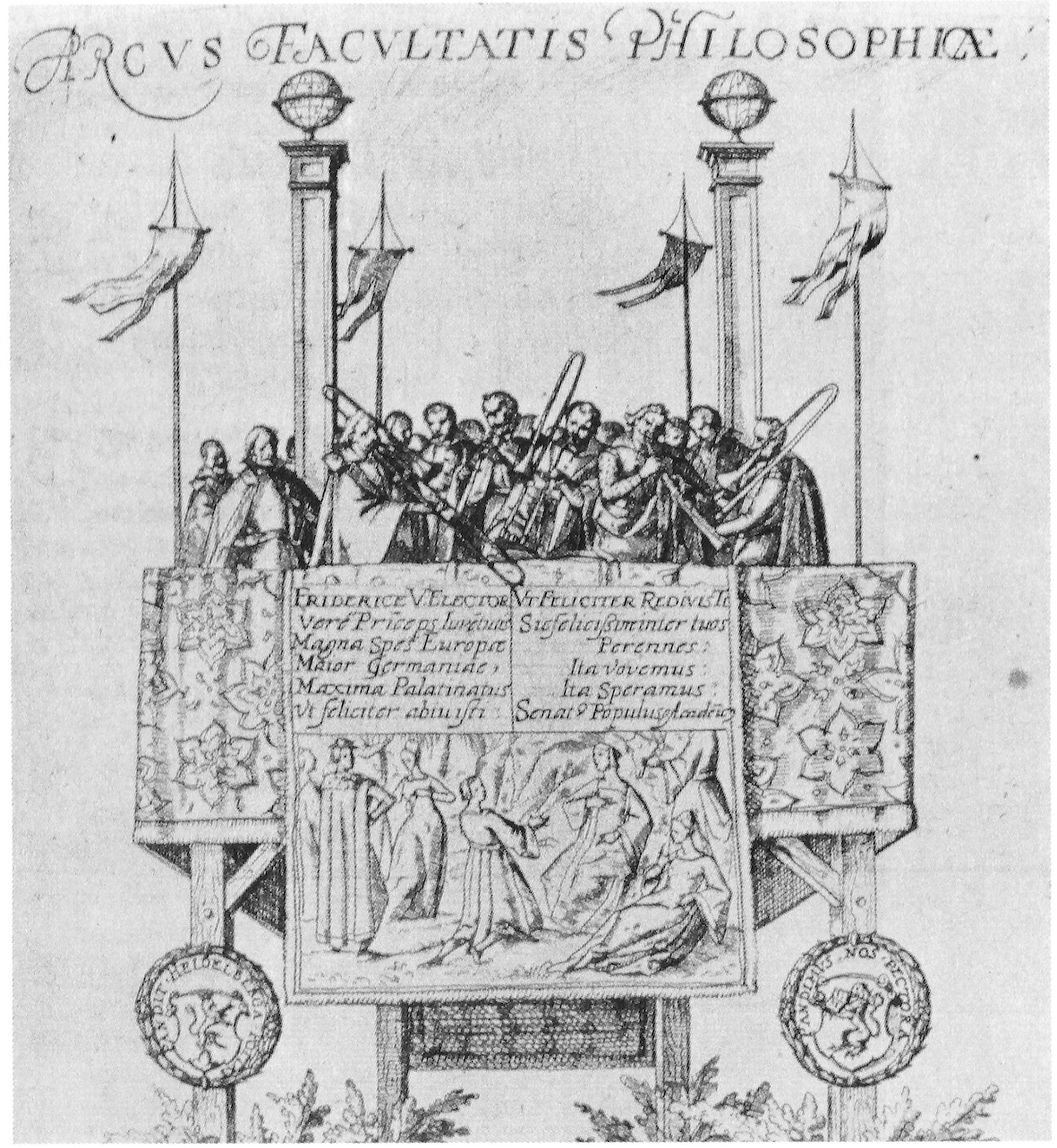
1613—Kassel, Germany: The Hofkapelle includes 2 trombonists on staff (Baines, Two Cassel Inventories).
1613—Kassel, Germany: An inventory of the Hofkapelle includes several sizes of trombones, along with various parts of these instruments: “1 great posaune with its E…[?] or joints [gliedern] mounted with silver, partly gilded; with slides [zugen] and crooks [bogen]; also 2 silver mouthpieces and a silver image [biltlein],” “1 bad posaune with its slide and crooks,” “4 Tenor and Alt posaunen, with 7 crooks and shanks [aufgesticktes],” “2 small Alt or Discant posaune with 3 crooks and shanks,” “1 Quart posaune with crooks and slide,” and “1 bell [glocke] of a posaune without appurtenances and front section” (Baines, Two Cassel Inventories).
1613—Munich, Germany: At the wedding of Duke Wolfgang Wilhelm of Bavaria to Countess Magdalena of the Pfalz, the wedding party goes to the Frauenkirche, where, according to one report, “Throughout the church, high up, trombones, trumpets and kettledrums were heard” (Bowles, Music in Court Festivals of State).
1613—Siena, Italy: Alberto Gregori, whom Montebuoni Buondelmonti praises as “a most singular trombone player, perhaps the best in Italy,” is hired at the cathedral. He serves there until 1618, then again from 1627 to 1641. He is also employed at various times throughout his career at Siena’s Palazzo Pubblico and Santa Maria della Scala (Reardon, Insegniar 127).
1613—Naples Italy: Pietro Cerone writes his Spanish-language treatise, Melopeo y Maestro. He classifies trombones [sacabuches] among instruments de viento, also noting that ensembles [conciertos] are found comprised of trombones, curtals, Doppioni, recorders, dolzaine, cornetts, Cornamusas, and crumhorns (Cerone 1038).
1613—Mantua, Italy: Amante Franzoni, maestro at Santa Barbara, includes “Concerto a cinque” for 4 trombones and tenor voice, as well as Sancta Maria ora pro nobis for 4 trombones and soprano voice, in Apparato Musicale di Messa, his collection of liturgical music (Kurtzman, Monteverdi Vespers 32; Sanders, Gonzaga 154).
1613—England: Drayton’s Polyolbion relates a musical contest between the Welsh and the English: “So were there some again, in this their leaned strife, Loud Instruments that loved, the cornet and the fife, The Hoboy, sagbut deep, recorder and the flute: Even from the shrillest shawm unto the cornamute” (Whitwell, Renaissance 38).
1613—Bologna, Italy: Records from the convent Santa Margherita show that a woman named Suor (sister) Olimpia Ghisilieri and another nun both own trombones (Monson, Disembodied 47).
1613—Freistadt, Austria: Civic musician Wolf Hueber is found to own, upon his death, 3 trombones, 4 trumpets, 5 cornetts, a shawm, 9 “Querpfeifen,” 8 violins, and a zither.” Historian David Whitwell has speculated that “some civic musicians, perhaps unwilling to trust the town to have the necessary instruments available and in good repair, owned large personal collections of all the instruments they might need” (Whitwell, Renaissance 152).
1613—Imola, Italy: Giulio Belli writes Concerti ecclesiastici a due et a tre voci, which calls for trombone. Specifically, Canzona No. 16 is a 2-part work that specifies trombone, cornett (or violin), and continuo, and Canzona No. 29 is a 3-part work calling for 2 cornetts (or violins), trombone, and continuo (Collver 43).
1613—Italy: Ercole Porta’s Canzona 33, a 2-part work, calls for cornett and trombone. Canzona 34, a 3-part work, calls for 2 cornetts or violins and one trombone (Winkler 299). His La Luchina, canzon in risposta, from Vaga Ghirlanda di soavi, calls for violin, cornett, 2 trombones, and basso continuo (Collver 65).
1614—Dresden, Germany: An image documenting a procession in honor of the baptism of Duke August depicts two trombones and a cornetto, followed by a person dressed as Mercury (see below image; public domain) (Dresden Staatsarchiv).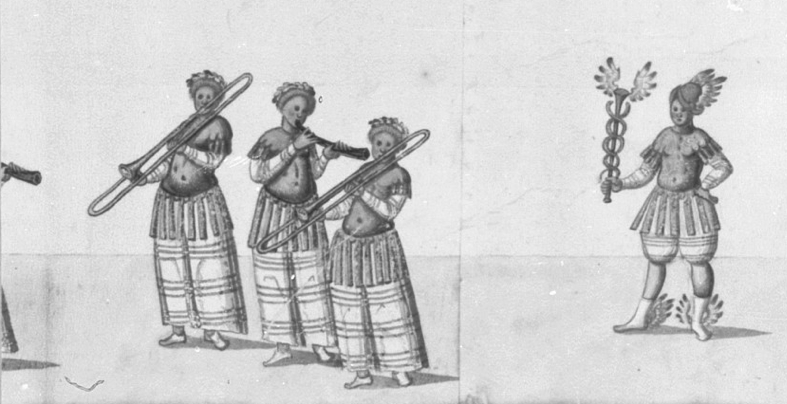
1614—Italy: Usper’s Intonuit is scored for 2 voices and 4 trombones (Whitwell, Baroque 213).
1614—Vienna, Austria: Giovanni Bassano presents the Doge with a request to make his piffari e tromboni a “union of instrumentalists” with the privilege of playing “both in the churches and the scuole grande within and outside of Venice.” The request is approved and detailed bylaws are drawn up two years later (Moore 82).
1614—Brescia, Italy: Pietro Lappi calls for trombone in his vocal work, Sacrae melodiae (Collver 129).
1614—Venice, Italy: An official roster for the orchestra at St. Mark’s cathedral indicates that there are at least 3 trombones on payroll (Selfridge-Field, Bassano and the Orchestra of St Mark’s).
1614/15—England: The Colledge Sagbutt is repaired at Trinity (Payne 146).
c. 1615—Bologna, Italy: A painting in the cupola of Basilica di San Domenico features an angel-trombonist (see below image; public domain) (special thanks to Kellyn Haley).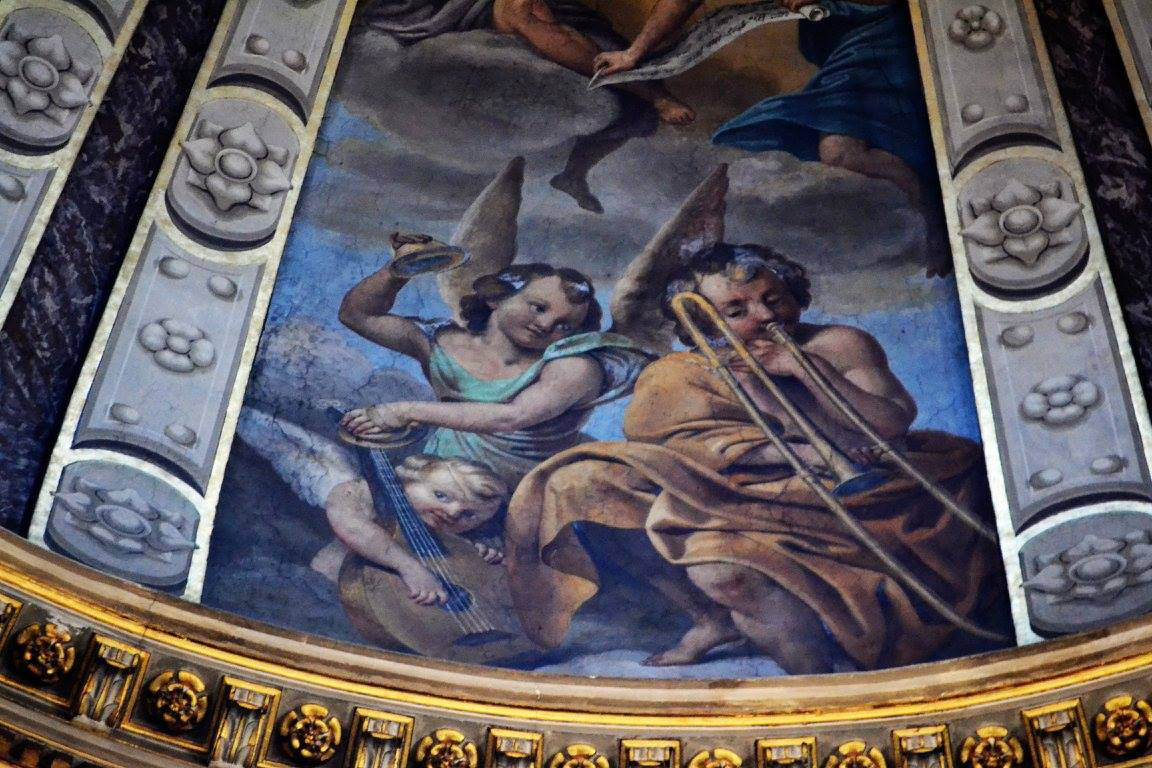
c. 1615—Cislago, Italy: The Church of Santa Maria della Neve contains an anonymous fresco lunette featuring several angel musicians, including a trombonist. The trombone is particularly noteworthy because it is a rear-facing (sometimes called “over-the-shoulder”) instrument, an unusual configuration for this early date (see below image; public domain) (Morandi; Farioli). For another early rear-facing instrument, see 1578 in the 16th century timeline, where a cherub-trombonist is featured. In later centuries, particularly the 19th century, rear-facing trombones become much more common; the 19th century timeline includes at least 9 such images.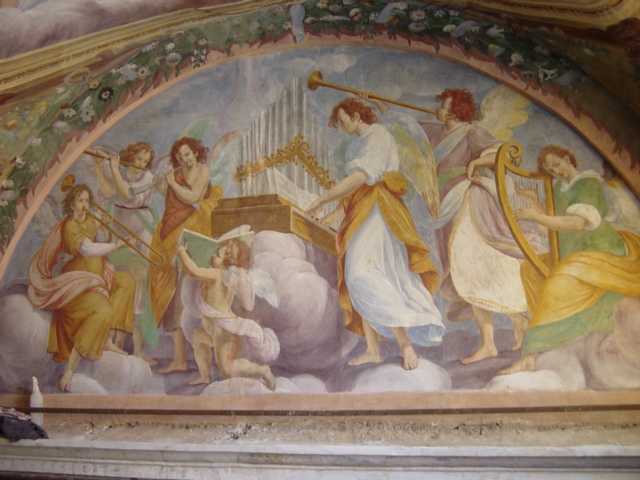
c. 1615—Belgium: Allegory of Music by Jan Bruegel the Elder includes a trombone among numerous instruments resting on the floor (see below image; public domain).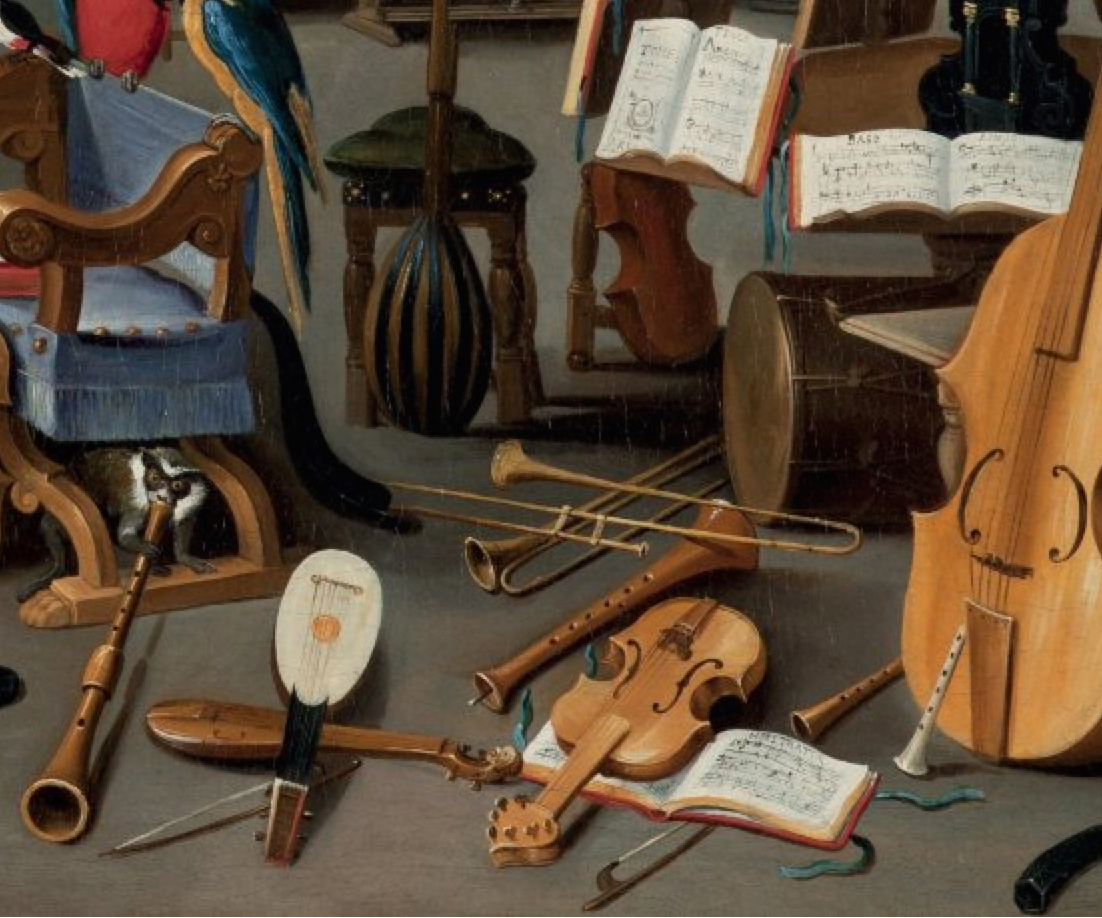
c. 1615—Antwerp, Belgium: Hendrick van Balen’s painting, Minerva among the Muses, on the cover of a virginal belonging to Queen Maria Kazimiera Sobieski, features a trombone among several instruments resting on the ground. The trombone is somewhat unusual because of the double loop of tubing on the back of the instrument, similar to the one portrayed by Brueghel and Rubens in Allegory of Hearing (1617-18). Queen Maria, originally from Poland, marries King James Stuart and spends most of her life in Rome. Hendrick van Balen, the artist, is a mannerist from the Antwerp School (see detail and full image, below; click full image for larger version; public domain) (source: wikimedia commons).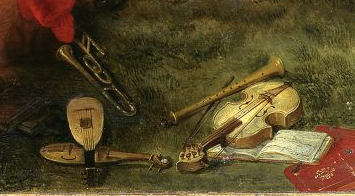
c. 1615—Antwerp, Belgium: Hendrick van Balen’s painting, Minerva and the Muses, includes a trombone among several musical instruments resting on the ground (see below image; public domain). See also the copy within Bruegel and Rubens, Allegory of Hearing (1617-1618, below).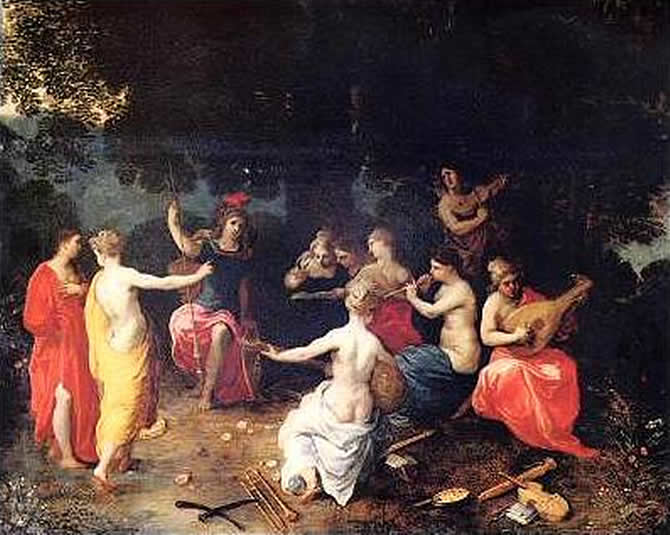 c. 1615—St. Omer, France: Pas de Calais, headmaster of the College of St. Omers, describes the musical activities of the school. Sackbut is included among the category of “Other wind instruments [that] require more lung-power” (Long Study 28).
c. 1615—St. Omer, France: Pas de Calais, headmaster of the College of St. Omers, describes the musical activities of the school. Sackbut is included among the category of “Other wind instruments [that] require more lung-power” (Long Study 28).
c. 1615—Graz, Austria: Giovanni Valentini (c. 1582-1649) writes Canzon a 2 for trombone, cornett, and continuo; Sonata a 4 for trombone, cornettino, bassoon, and organ; and Sonata a 5 for trombone, 2 cornetts, 2 violins, and continuo (Collver 71).
c. 1615—Italy: Sienese artist Francesco Rustici (sometimes known as “il Rustichino”) includes what appears to be a trombone in his painting, Concerto. The trombonist, standing in the middle-rear, appears to be female (see detail and full image below; public domain) (Museo di Arti Figurative; Markova). For a commercial reproduction of a detail of the trombone player (labeled “trumpet” on the site), see here.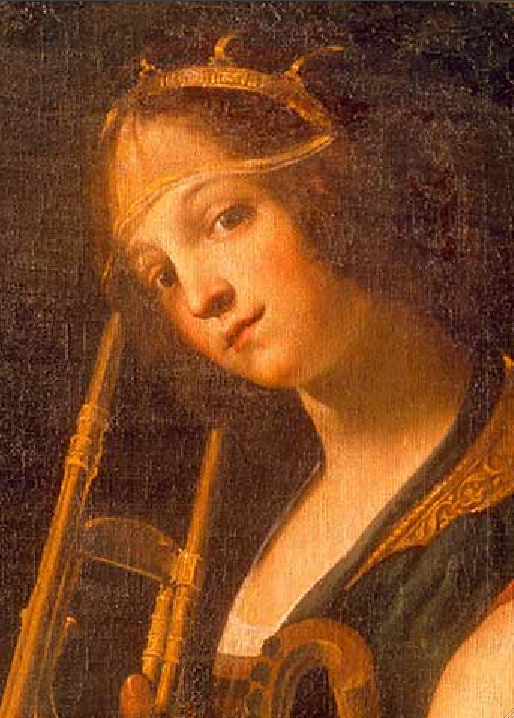
c. 1615—Hans Rottenhammer’s painting, Madonna col Bambino in Gloria con angeli musicanti, bears several similarities to Raphael Sadeler’s engraving, Allegory of the Immaculate Conception (which, in turn, is after a painting by Pietro Candido). An angel playing trombone is featured on the bottom-left of the image (see below image; public domain).
1615—Munich, Germany (?): Allegory of the Immaculate Conception, an engraving by Raphael Sadeler (1584-1632) after Peter Candid (also known as Peter de Witte and Pietro Candido), includes an angel-trombonist among a group of musical angels (see detail and full image below image; public domain) Click on detail to expand.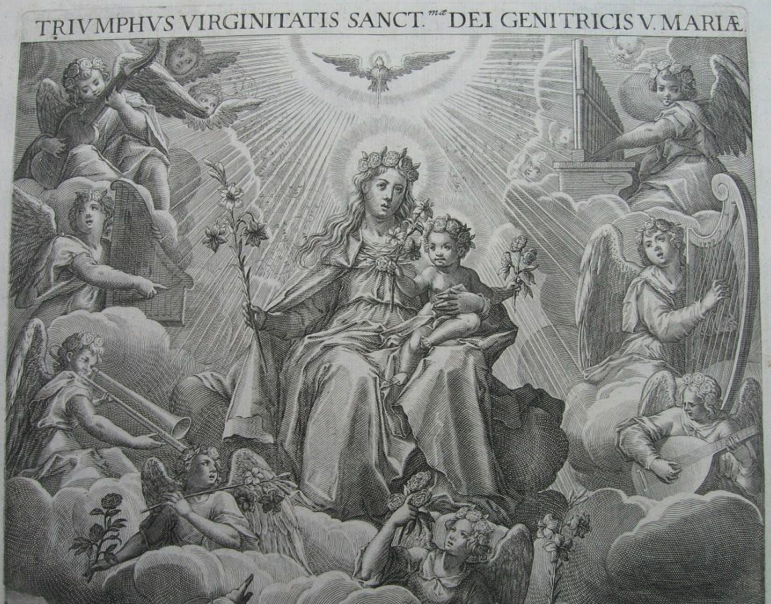
1615—Mexico: Regarding music in Mexico, Juan de Torquemada says, “After a while there was no single instrument used in churches which Indians in the larger towns had not learned to make and play. It became unnecessary to import any of these from Spain. One thing can be asserted without fear of contradiction; in all Christendom there is nowhere a greater abundance of flutes, sackbuts, trumpets, and drums, than here in New Spain” (Stevenson Music in Mexico 68).
1615—Milan, Italy: Bartolomeo Roverio’s painting at Santa Maria church, Chiaravalle Abbey, features an angel-trombonist among a number of other angel-musicians (see below image; public domain) (Die bemalten Orgelflügel 360).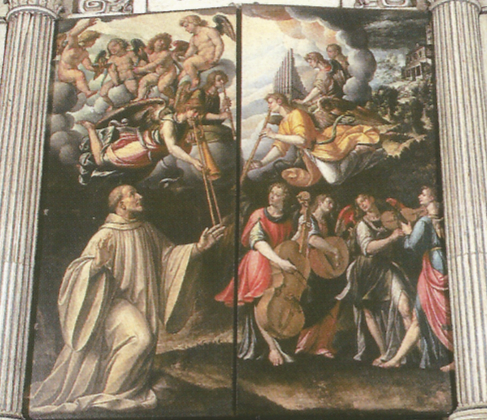
1615-16—Brussels, Belgium: Archduchess Isabella visits Brussels and subsequently commissions several paintings to portray the related celebrations. In a series of several paintings, Denis van Alsloot, court painter for Archduke Albert and Isabella, depicts the ommegang, or procession, that had taken place outside the Brussels church of Notre Dame du Salon. One of the paintings depicts the 6-member civic wind band of Brussels that had been part of the procession (see 1st detail and full image, below; public domain). The group includes trombone, cornetto, dulcian, and several sizes of shawms, and occupies a place of honor between the relics and the statue (Denis van Alsloot, Procession en l’honneur de Notre-Dame du Sablon a Bruxelles le 31 mai, Museo Prado, Madrid) (Lesure 94-95; Forney, Antwerp 363; Whitwell, Baroque 181; Wangermée, vol. 1 241). Another artist, Antoine Sallaert, also depicts the procession, portraying the wind band in nearly the same posture and configuration as Alsloot, then in a slightly different configuration (see final 2 details, below; public domain) (Galleria Sabauda, Turin).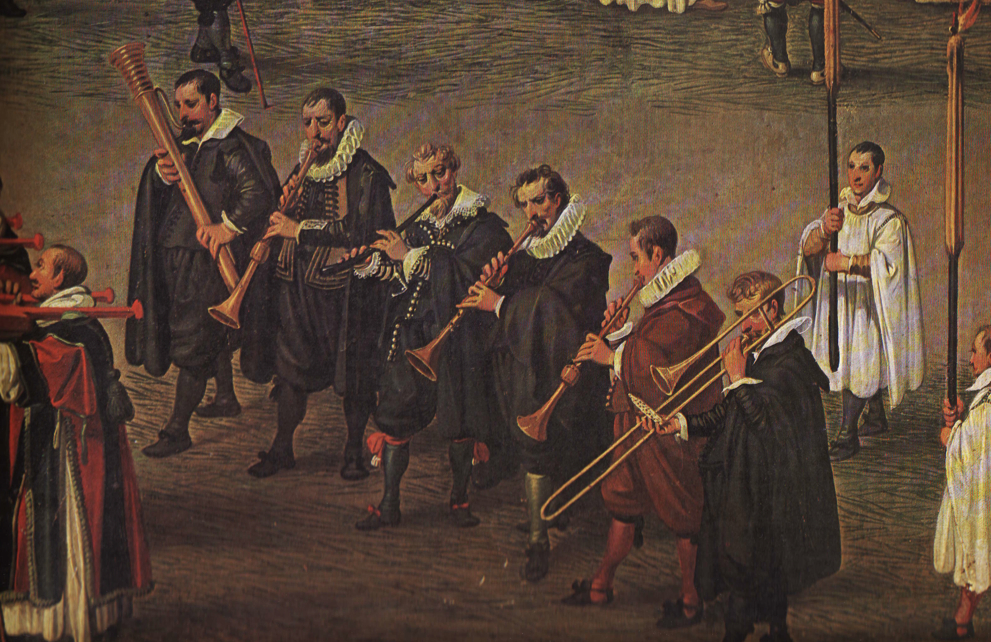
1615—Modena, Italy: Modena Cathedral possesses a musical establishment of approximately 15 singers, a cornettist, a trombonist, and an organist (Kurtzman, Monteverdi Vespers 381).
1615—Siena, Italy: Authorities grant trombonist Alberto Gregori permission to augment his salary by playing at the church of Santa Maria di Provenzano (Reardon, Insegniar 136). The same year, Lorenzo Scala, a full-time member of the chapel and former student of Gregori, petitions for permission to supplement his income by playing trombone at the Santa Maria di Provenzano; his request is approved on condition that he play no more than 2 times a month at the church (Reardon, Music and Musicians).
1615—Reggio Emilia, Italy: Lionello Spada’s fresco in the cupola of the Chiesa della Ghiara includes depictions of numerous angel-musicians, including an angel playing trombone. The other instruments include harp, recorder, triangle, tambourine, cornetto, lute, and violin (see detail and full image below—click on full image to expand; public domain) (Quintavelle, plate 81; Monducci 130; Artioli, plates 8 and 12).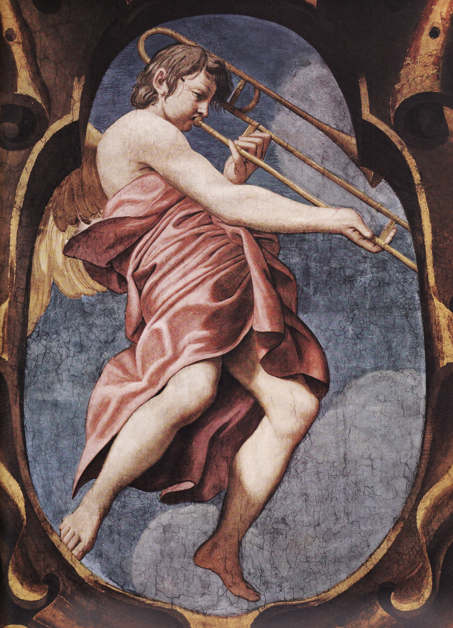
1615—Venice, Italy: Symphoniae sacrae II, a collection of Giovanni Gabrieli’s works, is published 3 years after his death. Trombone is featured prominently. For example, Jubilate Deo is scored for alto voice, tenor voice, 5 trombones, 2 cornetts, and bassoon. Surrexit Christus is scored for alto voice, tenor voice, bass voice, 4 trombones, 2 cornetts, and 2 violins, and features extended instrumental sections (Roche, North Italian 115; Collver 116). Suscipe a 12 calls for 6 voices and 6 trombones (Bartlett, Giovanni Gabrieli: A Guide). Quem vidistis pastores a 14 utilizes 3 trombones (Collver 116).
1615—Italy: Arcangelo Borsaro writes for 2 cornetts (or violins), trombone, and organ in his La Matusaleme a tre from Odarati fiori (Collver 45).
c. 1616—Brussels, Belgium: An artist from the studio of Sallaert includes a trombone in the below drawing that appears to be either a preparatory sketch or a copy of the more famous 1616 Procession by Sallaert (see below image; public domain) (Van Sprang, Pictura Nova, 2014, vol. 2, no. F6, ill. 95).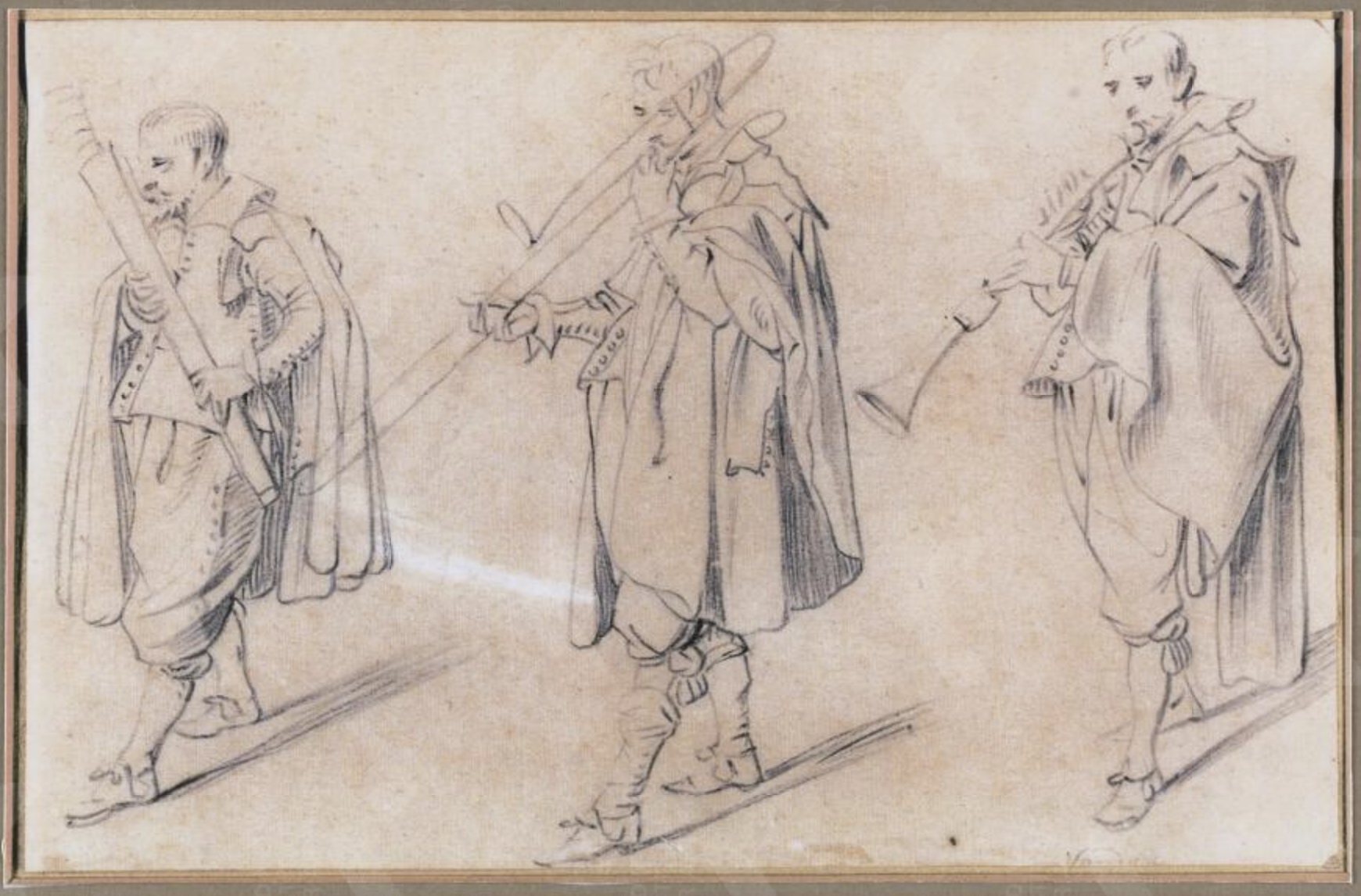
c. 1616—Augsburg, Germany: A painting by Thomas Maurer, The Diocesan Synod of 1610 in the Cathedral of Augsburg, includes what may be two trombones situated on opposite sides of the group of musicians, with only the rather long rear bow of the instruments visible (see detail below; public domain) (Chevalley 142).
1616—Munich, Germany: Bernardino Borlasca, newly-appointed Hofkapellmeister of the Bavarian court, publishes Scala Iacob, a collection of motets. The preface to the collection says the following about instrumentation of polychoral works: “The first choir is to consist of four principal parts with a soprano and a castrato or a pleasant falsetto, accompanied by a body of diverse stringed instruments such as viole da braccia or da gamba, a large harp, a lirone, or other similar instruments as are common today, especially at the Bavarian court; indeed His Serene Highness has examples of every kind of instrument of this sort, as well as men of exquisite excellence. Moreover, where the letter V. is found, the voice should sing; at the word Sinfonia the instruments should play, and at the letter T. the voices and instruments should play together. The second choir should, like the first, also consist of the same voices, but of different instruments. For, if in the first are found plucked instruments or strings, in the second should be placed wind instruments, such as cornetts and trombones, and pleasingly tempered by a violin playing the contralto part an octave above. In this same way in the first choir a cornett playing the same part, if it is a choir of viols, is such a different instrument that by following these instructions one will be assured of obtaining lovely and delightful harmony.” Borlasca’s collection contains at least a dozen works that utilize 2 or 3 trombones in such a manner (Collver 93).
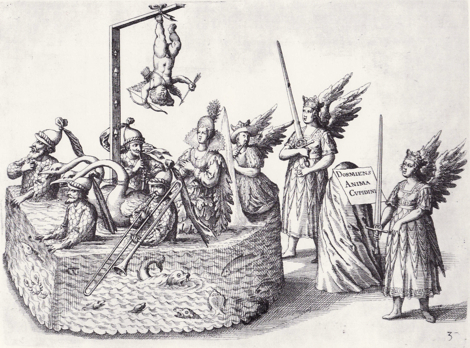 1616—Stuttgart, Germany: A highly symbolic series of engravings by Esaias van Husen depicts trombones with various combinations of instruments. The players are said to represent town musicians (stadtpfeifer) who entertain at peasant weddings, baptisms, fairs, and dances. In the facing image, bass trombone performs with 2 cornetts (see facing image; public domain) (Naylor 28, 194).
1616—Stuttgart, Germany: A highly symbolic series of engravings by Esaias van Husen depicts trombones with various combinations of instruments. The players are said to represent town musicians (stadtpfeifer) who entertain at peasant weddings, baptisms, fairs, and dances. In the facing image, bass trombone performs with 2 cornetts (see facing image; public domain) (Naylor 28, 194).
1616—London, England: Beaumont and Fletcher’s tragicomedy, The Mad Lover, uses trombones for a solemn scene, indicated by the following stage direction: “A dead march within of drums and sackbuts” (Long Study 37).
1616—Stuttgart, Germany: Festivities celebrating the baptism of Prince Friedrich von Württemberg feature trombone extensively. First, at the service itself, the “Assum Version” festival book records, “The charming piece by Gregor Aichinger, Laudate Dominum &c. for eight voices, with two cornetts, four trombones and two bassoons was executed by the most select vocalists, ending most appropriately.” Following the baptism, a Te Deum by Salomon is sung, utilizing 3 ensembles: “The first, with a positive organ, four fiddles, two lutes, a small pipe and large contrabass viols, besides four singers. The other, with regal, one cornett, two trombones, a bassoon and four vocal soloists. The third also with a regal, three trombones, a serpent, in addition to four musicians. Whenever the three ensembles played together [there was added] the great organ, a cornett and a contra bassoon [Pommerten Vagoten].” Later, trombone is again involved, this time during a banquet: “For this, the Kapellmeister of the prince directed a warm, intense chamber and banquet music for the assembled company with select members of the ensemble, in the Italian, English and French manner, with instruments [such as] portative organ, cornetts, trombones, bassoons, lutes, fiddles, viole bastarde, small pipes and live voices, the best soloists, [all] in various combinations.” Two days later there is a procession incorporating instrumentalists dressed as the Nine Muses that includes a trio of trombone and 2 cornetts (See below image; public domain) (Bowles 199-200, 207).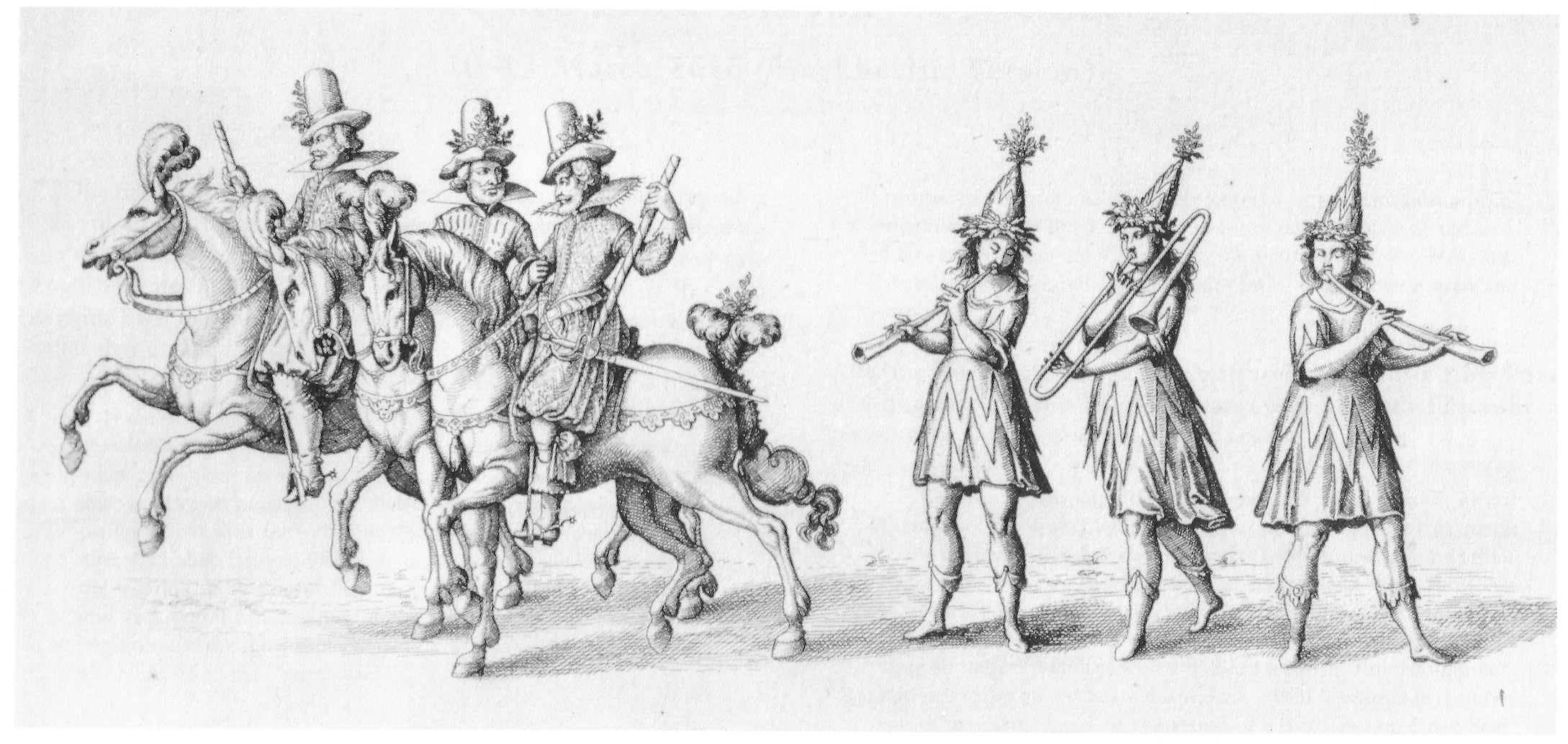
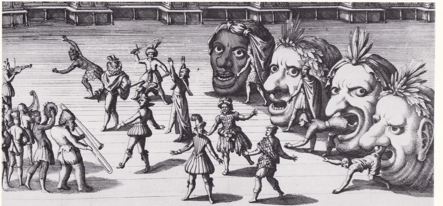 1616—Stuttgart, Germany: In a separate account of festivities celebrating the baptism of Prince Friedrich von Württemberg (as distinct from the “Assum Version” cited above), the author of the “Weckherlin Version” renders the account into English himself, taking note of the banquet: “None may doubte of the plentie of costlie meate and any kind of daintinesse, and rich shew’s of fountaines, images, beasts and other prettinesse set upon the boord, dressed most artificially, no lesse as of sweet musicke. For there were heard three severall companes th’ one after the’ other, so that when the first (that did sound, after the Italian fashion, instruments and voices together) did finish, the second (playing according to the English manner with cornets and sack-botts) did beginne…” The author then describes a “Ballet of Nations” that follows, in which characters representing various nations crawl out of 4 large heads. Of the trombone’s role he says, “The third that came forthe of the second head was a Laponian, covered with the skinne of a beare, and trampling about at the sound, such an other fellow of Lappie did tune with a sackbotte” (see facing image; public domain) (Bowles 209-11).
1616—Stuttgart, Germany: In a separate account of festivities celebrating the baptism of Prince Friedrich von Württemberg (as distinct from the “Assum Version” cited above), the author of the “Weckherlin Version” renders the account into English himself, taking note of the banquet: “None may doubte of the plentie of costlie meate and any kind of daintinesse, and rich shew’s of fountaines, images, beasts and other prettinesse set upon the boord, dressed most artificially, no lesse as of sweet musicke. For there were heard three severall companes th’ one after the’ other, so that when the first (that did sound, after the Italian fashion, instruments and voices together) did finish, the second (playing according to the English manner with cornets and sack-botts) did beginne…” The author then describes a “Ballet of Nations” that follows, in which characters representing various nations crawl out of 4 large heads. Of the trombone’s role he says, “The third that came forthe of the second head was a Laponian, covered with the skinne of a beare, and trampling about at the sound, such an other fellow of Lappie did tune with a sackbotte” (see facing image; public domain) (Bowles 209-11).
1616—Halle, Germany: As part of festivities celebrating the baptism of Sophie Elisabeth, first daughter of Markgraf Christian Wilhelm of Brandenburg, there is an enormous introductory procession that includes a group of 3 gypsies on horseback, escorted by a musical trio of 2 viol players and a trombonist (see below image; public domain) (Bowles 203, 220).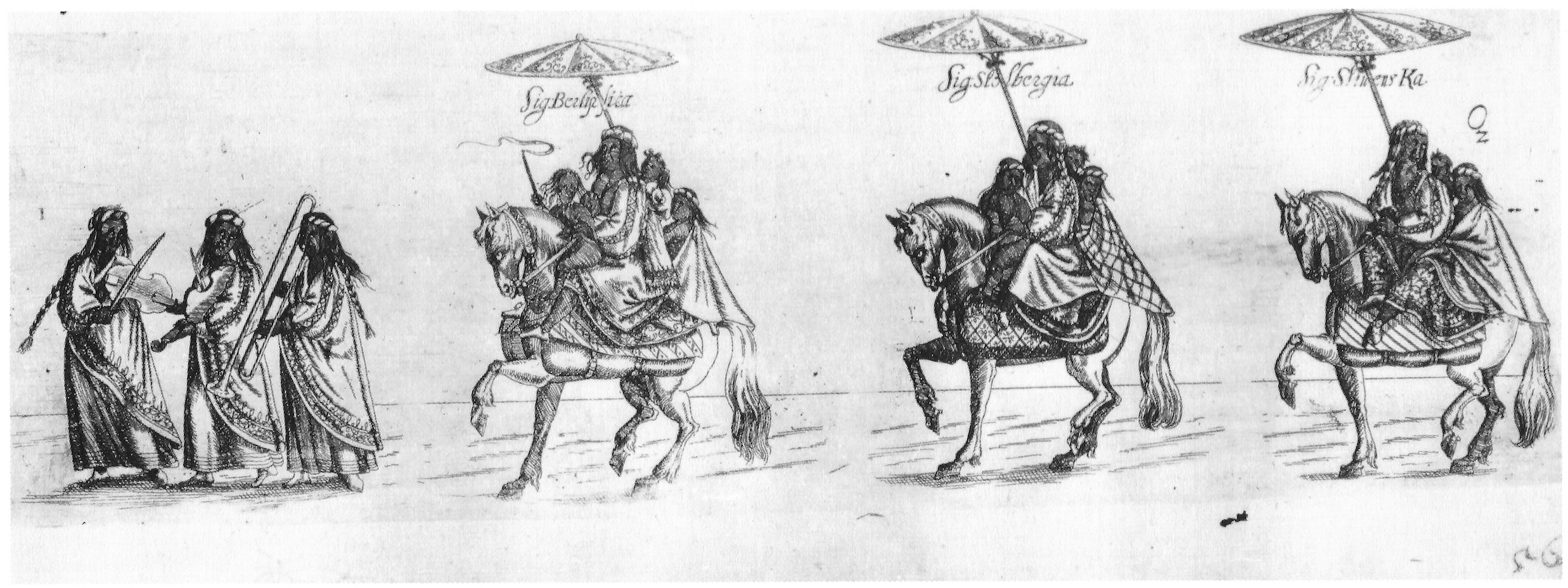
1616—Bologna, Italy: Ludovico Carracci’s Paradise, an altarpiece painting located in the Church of San Paolo Maggiore, features an angel-trombonist situated prominently among a group of angel-musicians (see below image; public domain) (Komma 109; Emiliana 167).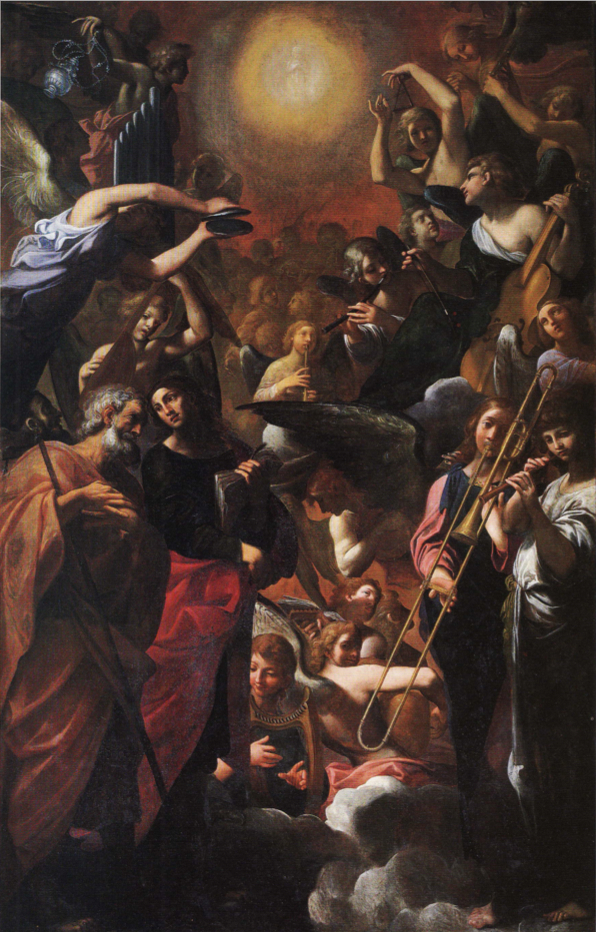
c. 1617—Antwerp, Belgium: Hendrick van Balen and Jan Brueghel collaborate on a painting called An Allegory of the Five Senses, which includes a trombone among several instruments in the foreground (see below detail; public domain) (Haeften, pl. 8). For other depictions of the trombone by the same painter, see c. 1610 (Banquet of the Gods), c. 1615 (Minerva among the Muses), and c. 1625 (Allegory of Music).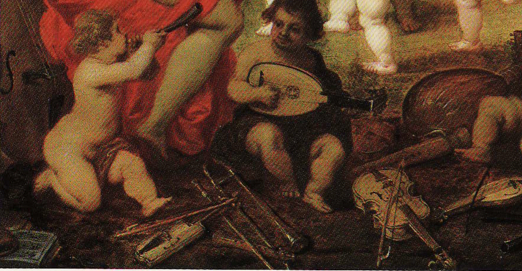
1617—Milan, Italy: Bartolomeo Roverio includes 3 trombones among many angel musicians in a ceiling fresco at San Marco (see 3 details and full image below; public domain) (Perer 172).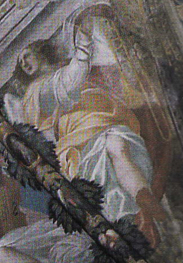
1617—Stuttgart, Germany: A festival book with engravings by Esaias von Hulsen, published in 1618, portrays the Stuttgart festivals of 1617 surrounding the christening of Ulrich of Württemberg and the marriage of Ludwig Friedrich of Württemberg to Elisabeth Magdalena of Hesse-Darmstadt. It features two different plates in the procession that include 4 different trombonists, all of them apparently female players (see below 2 images; click on image for larger version; public domain) (sources: Komma 128, Festkultur online).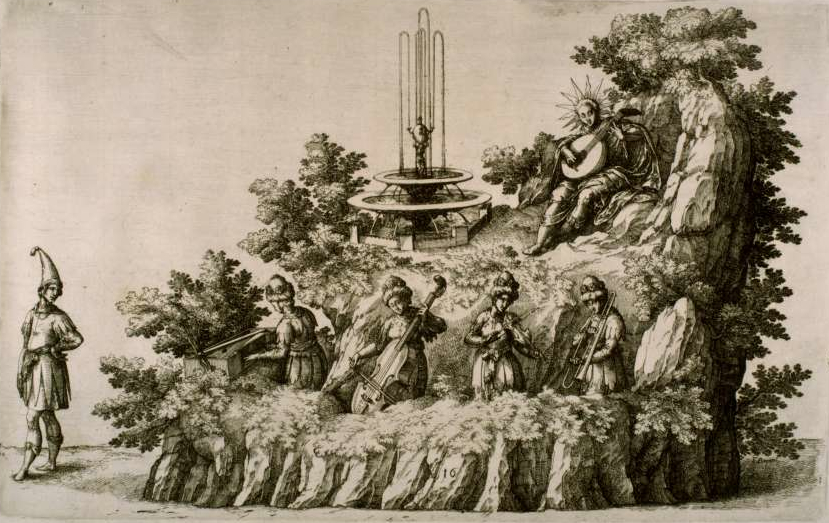
1617—Dresden, Germany: In a letter from Heinrich Schütz to Heinrich Posthumus of Reuss-Gera (Germany), Schütz recommends that 2 boys of the court ensemble be trained on trombone (Spagnoli 69-70).
1617—Dresden, Germany: A 3-day celebration is held to mark the centenary of the start of the Reformation. For the occasion, Heinrich Schütz writes several richly scored Psalm settings that include cornetts, trumpets, trombones, and timpani (Smallman 29).
1617—Venice, Italy: Biagio Marini’s Affetti musicali, a collection of instrumental music, includes several works that specify trombone: La Giustiniana (2 cornetts or violins, trombone, continuo), La Foscarina (2 cornetts or violins, trombone or bassoon, continuo), La Hiacinta (violin or cornett, trombone, continuo), La Marina (cornett or violin, 2 trombones, continuo) (Winkler 299, Collver 45).
1617-1622—Ferrara, Italy: Incoronazione della Vergine, a painting by Carlo Bononi in the basilica di Santa Maria in Vado, includes a lute and trombone (see below image; public domain).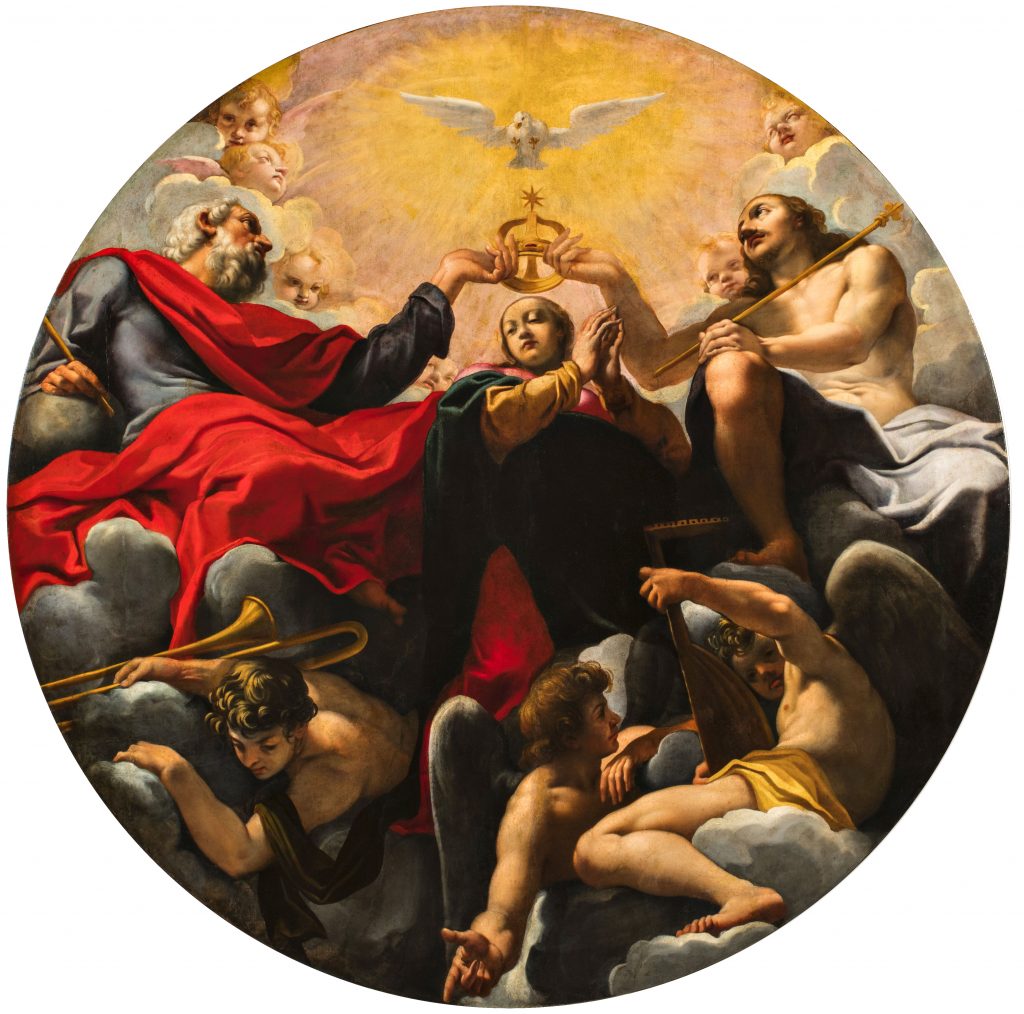
1617-1618—Antwerp, Belgium: Jan Brueghel the Elder and Peter Paul Rubens collaborate on a series of paintings on the subject of the 5 senses. The Sense of Hearing or Allegory of Hearing depicts a trombone among the many instruments in the room (see Detail 1, below). In the upper-left of the painting is a painting within a painting: a copy of Hendrick van Balen’s Minerva and the Muses, which also includes a trombone (see Detail 2, below and c. 1615, above). The full painting by Brueghel and Rubens is the third image below (images public domain) (Woollett, 91-92; Museo del Prado, Madrid).
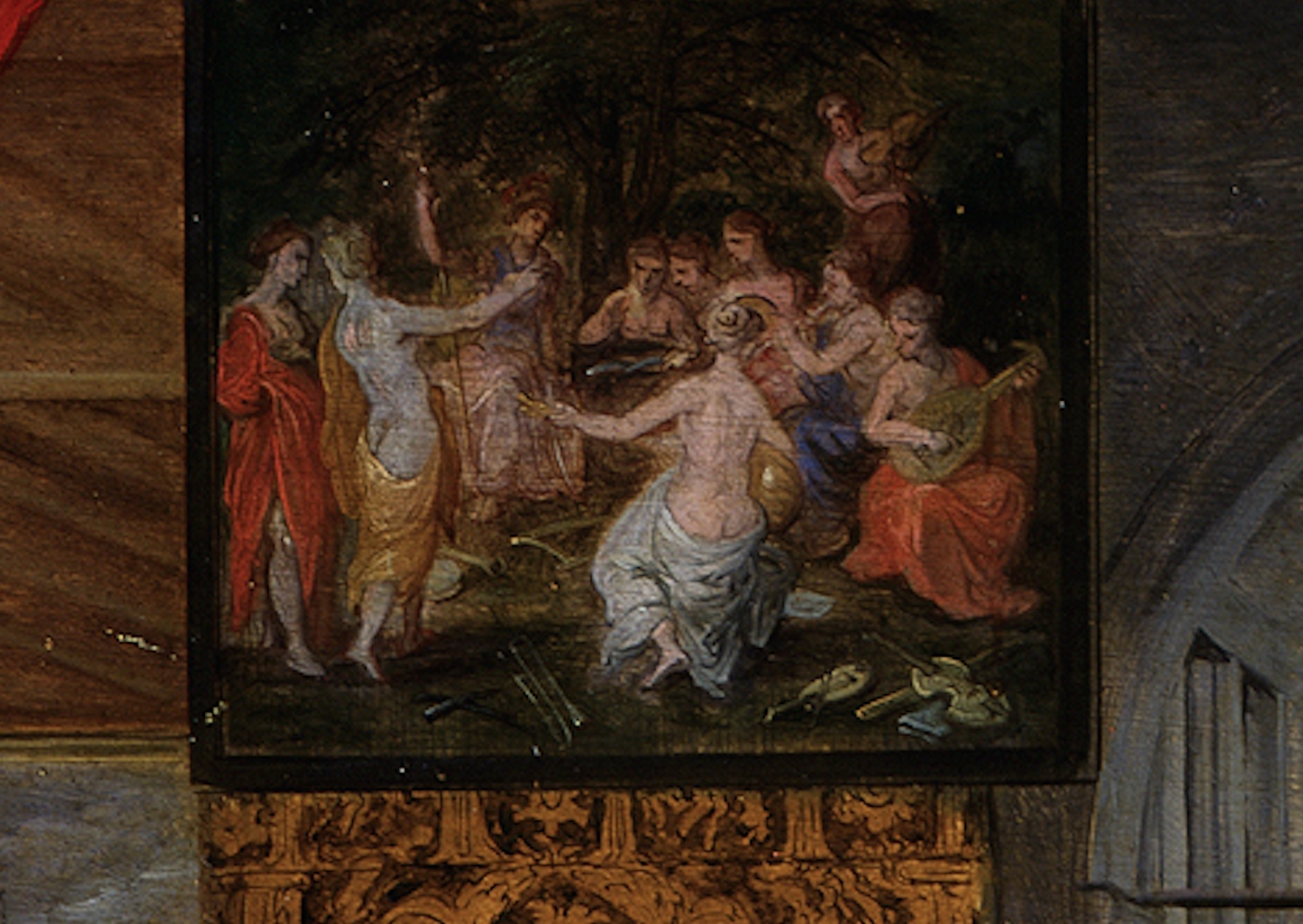
Detail 2 from upper-left of Breugel and Rubens, The Sense of Hearing or Allegory of Hearing, showing a painting-within-a-painting of Hendrick van Balen’s Minerva and the Muses (c. 1615).
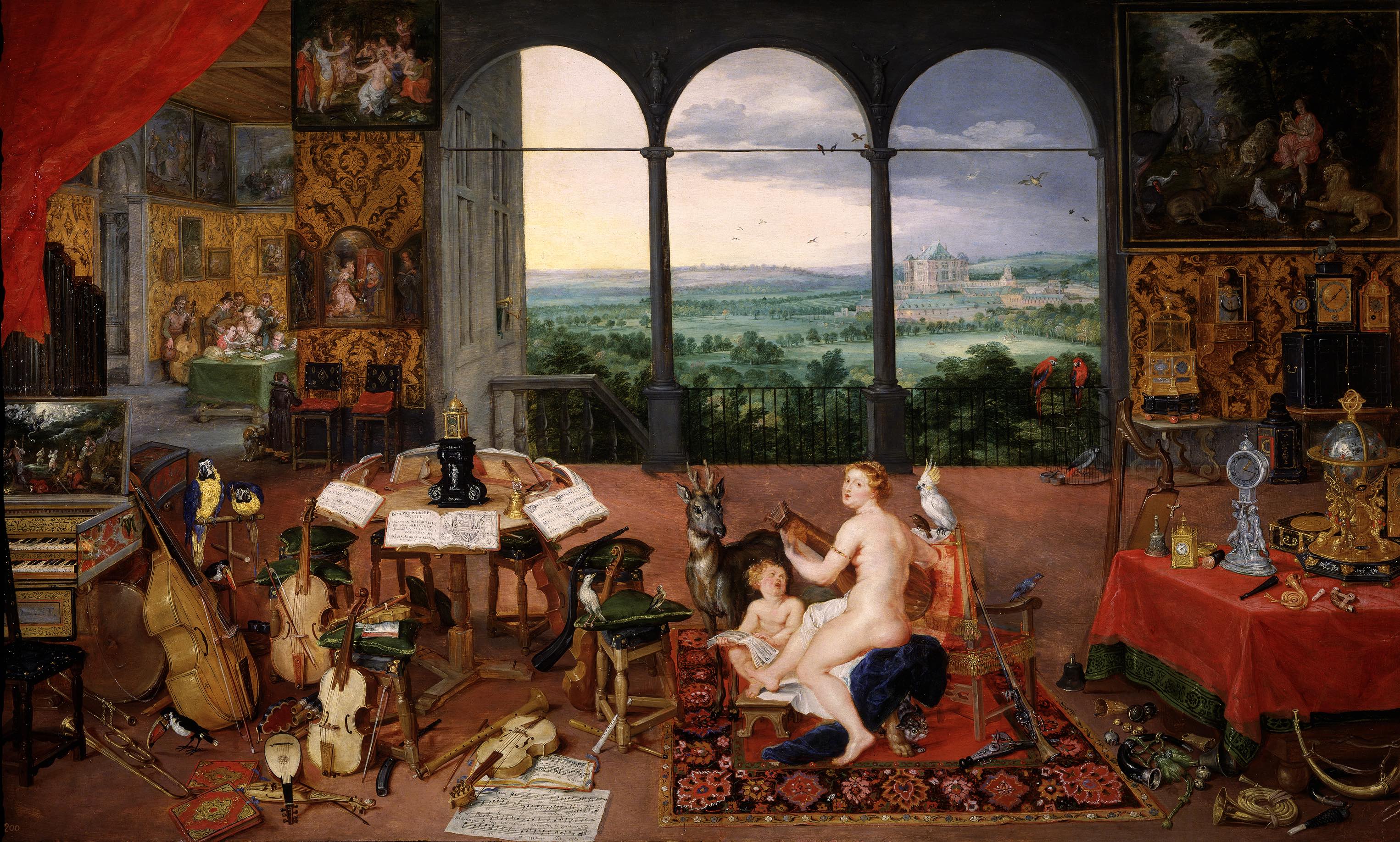
Jan Brueghel the Elder and Peter Paul Rubens, The Sense of Hearing or Allegory of Hearing (full painting).
1618—Belgium: Jan Brueghel includes a trombonist resting on the ground in his allegorical painting, Taste, Hearing, and Touch (see lower-left corner of detail and full image below; public domain).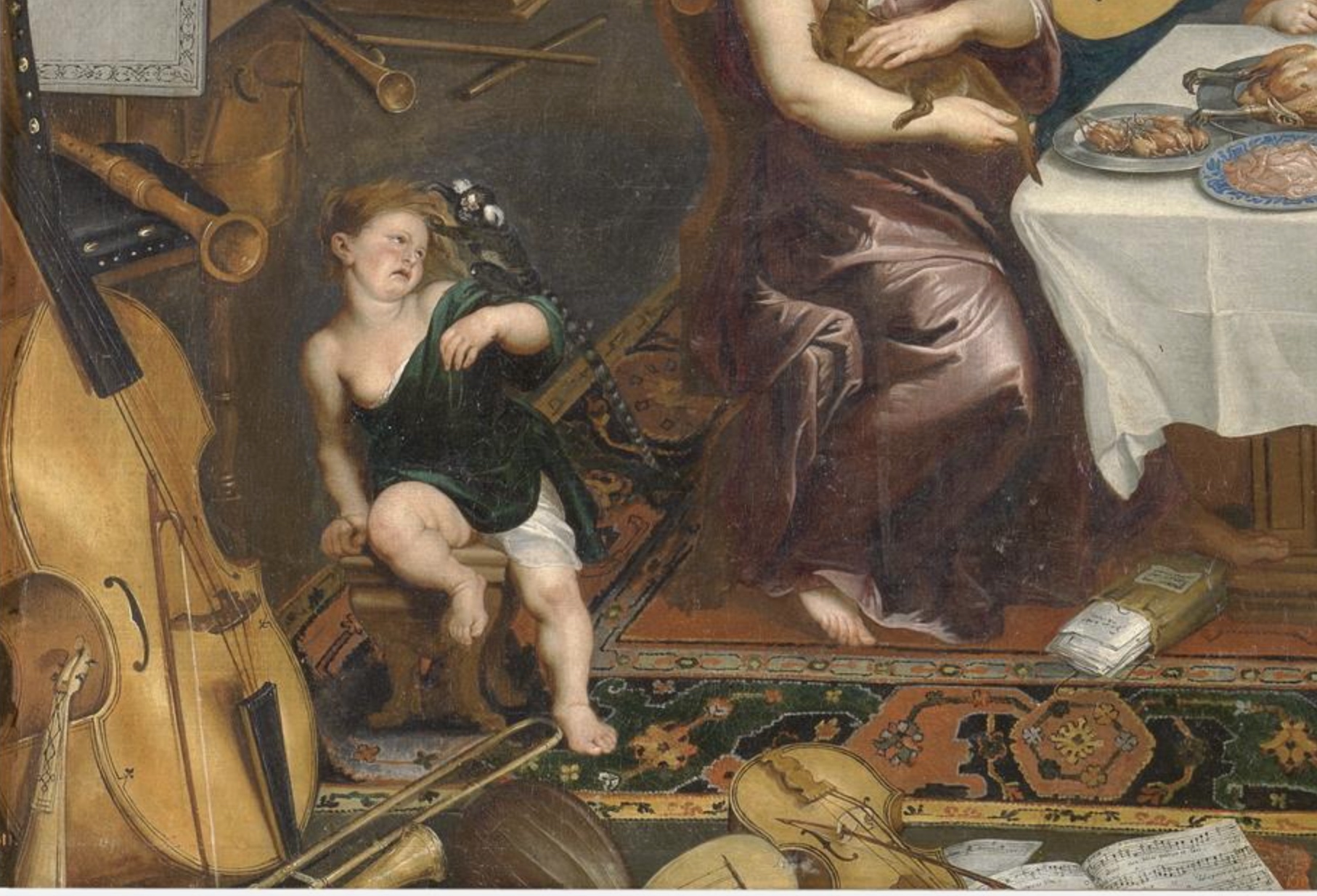
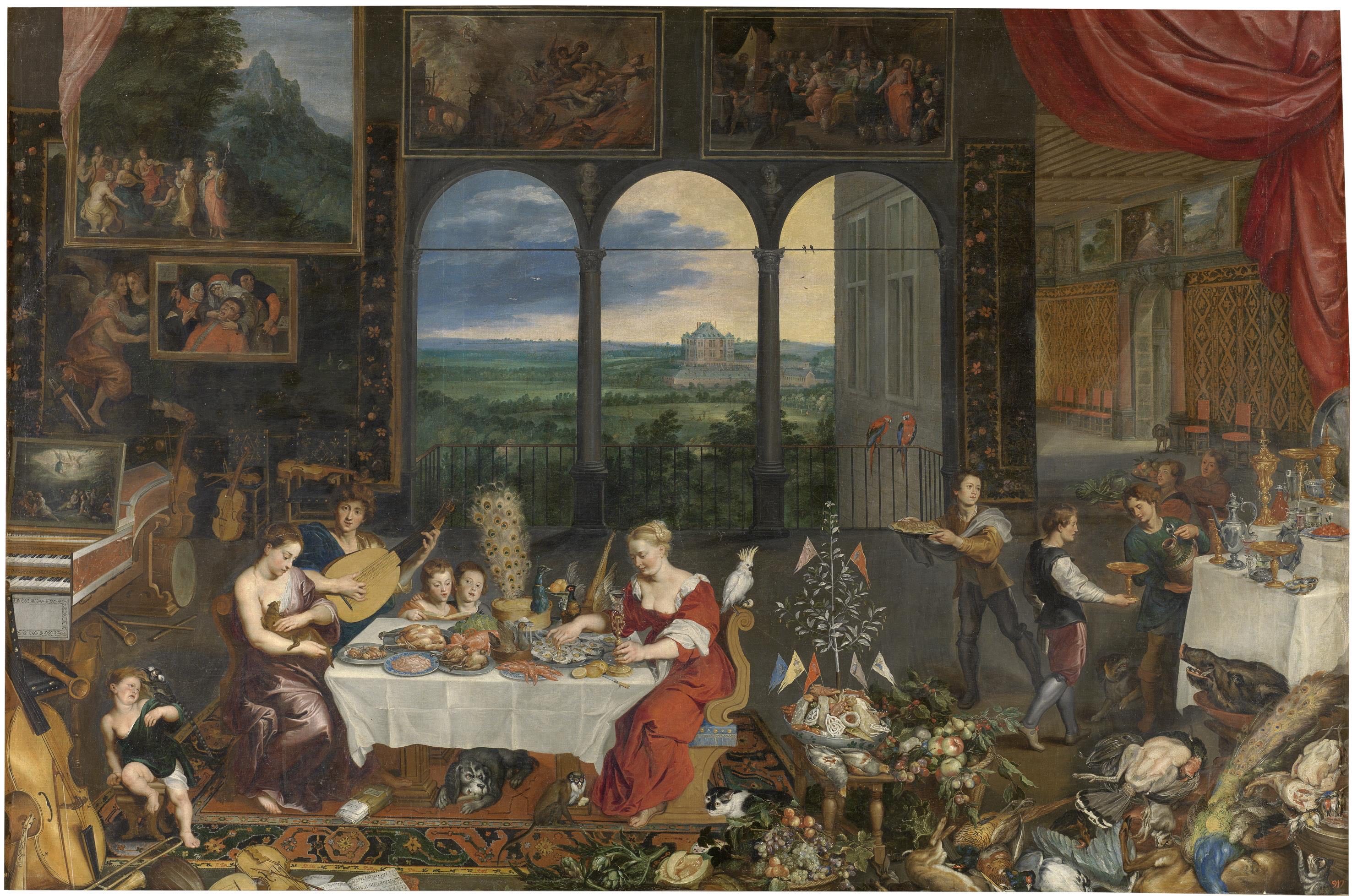
1618—Venice, Italy: Trombonist Alvise Grani becomes a member of the ducal pifferi. At some point, he also becomes a teacher at the Pieta in Venice—the earliest known hiring of an external maestro at that institution (Baldauf-Berdes 188).
1618—Stuttgart, Germany: Town musicians are forbidden to play cornetts or trombones at “common” weddings; rather, fiddles and other stringed instruments are encouraged for such occasions (Marcuse 811).
1618—Venice, Italy: Biagio Marini’s Madrigali et symfonie a una, 2, 3, 4, 5 utilizes trombone in “La Rizza,” which calls for violin, cornett, trombone, bassoon, and basso continuo (Collver 60).
1618—Italy: Bastiano Miseroca writes Canzon a 3 for 2 cornetts, trombone, and continuo. The work is part of a larger collection called I pietosi affetti (Collver 62).
1618—Bologna, Italy: Suor (sister) Angela Maria Rugieri brings a trombone and bass viol with her to the convent Santa Caterina (Monson, Disembodied 263).
1618—Pieter Lastmann’s altar scene, David in the Temple, portrays a trombone performing with voices, tamborine, pommer, and 2 string instruments (see detail and full image below; public domain) (Kinsky 177; Buchner 254; Herzog Anton Ulrich-Museum, Braunschweig).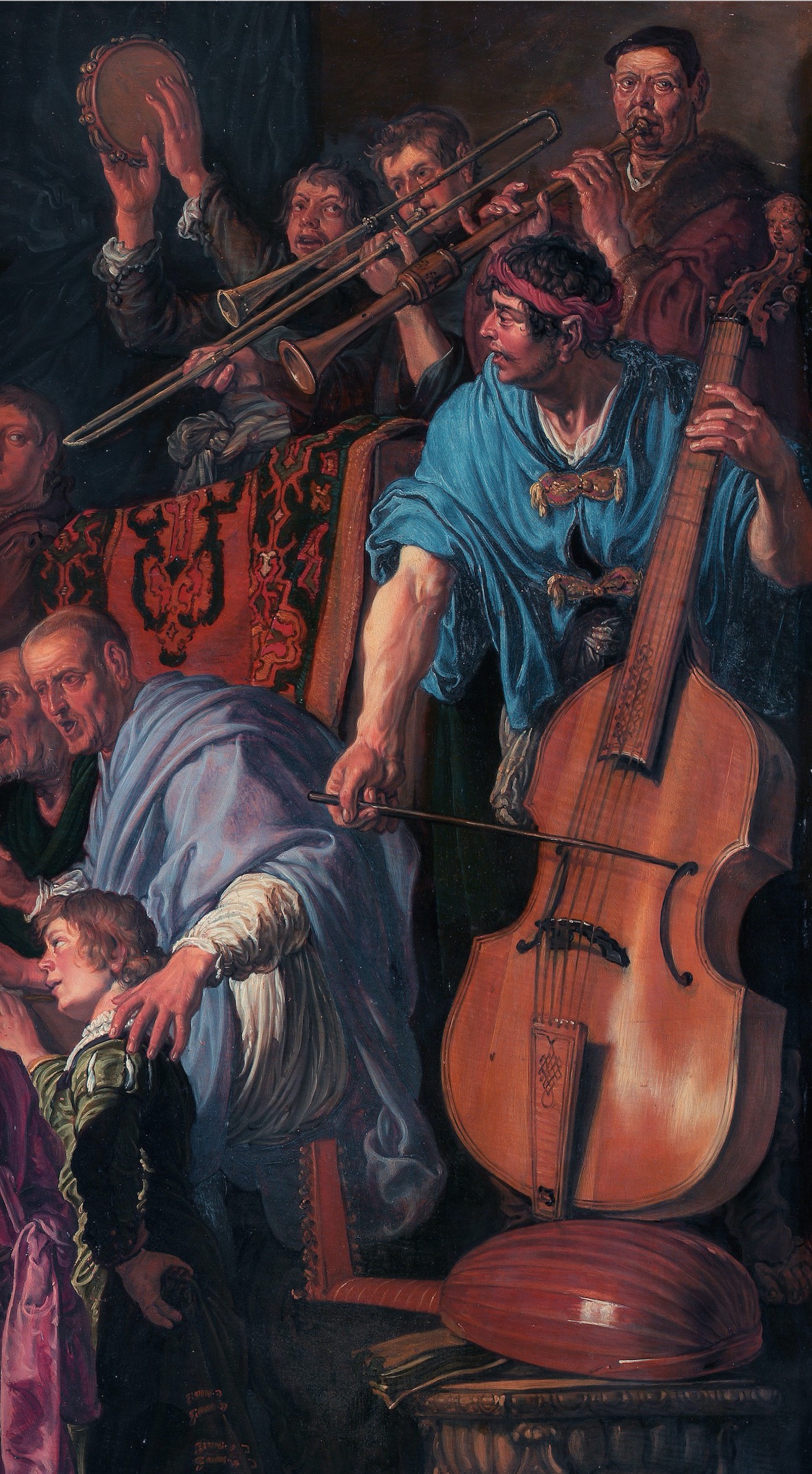
1618—Leipzig, Germany: Heinrich Schütz (1585-1672) utilizes trombones in Concert mit 11 Stimmen, Haus und Güter erbet man von Eltern, which he composes for the wedding of Michael Thomes and Anna Schules (Collver 167).
1618—Leipzig, Germany: Johann Hermann Schein (1586-1630) writes Das Te Deum Laudamus, a polychoral work that calls for 2 trombones in one choir and 1 trombone in another (Collver 163).
1618—Bremen, Germany: An anonymous oil painting depicts a wedding procession led by 4 town musicians—alto, tenor, and bass trombones with cornett (instrument identification according to Walter Salmen). The wedding party is apparently wealthy and the musicians are elegantly dressed. The painting is set against the backdrop of the Hanseatic town of Bremen (Salmen, Status).
1618—London, England: Records for the King’s Music list Hautboys and Sackbuts together instead of separately. The group consists of 6 (Woodfill 302).
1618—Wolfenbüttel, Germany: The title page from Polyhymnia panegyrica by Michael Praetorius depicts 3 angels playing trombone among a compact jumble of other musicians (see below image; public domain) (Naylor 216).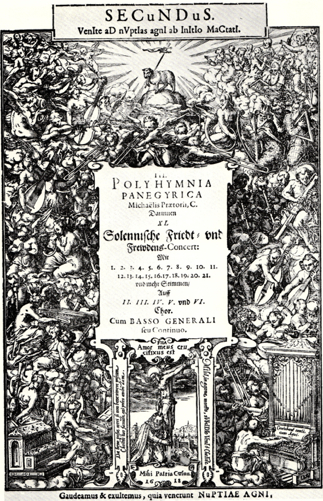
1618/19—Giovanni Priuli, Canzon terza a 6 (due cornetti e viola, due tromboni e fagotto).
1618/19—Giovanni Priuli, Canzon quarta a 6 (3 violini, 3 tromboni).
1618-1624—Christof Angermair’s ivory carving from the coin cabinet of Elizabeth of Lorraine depicts a number of musicians, including a trombonist in the foreground, performing with Pan, the shepherd’s god (see below image; public domain) (Munich: Bayerische Staatsgemäldesammlung; Salmen, Gartenmusik 75; Hindley 164).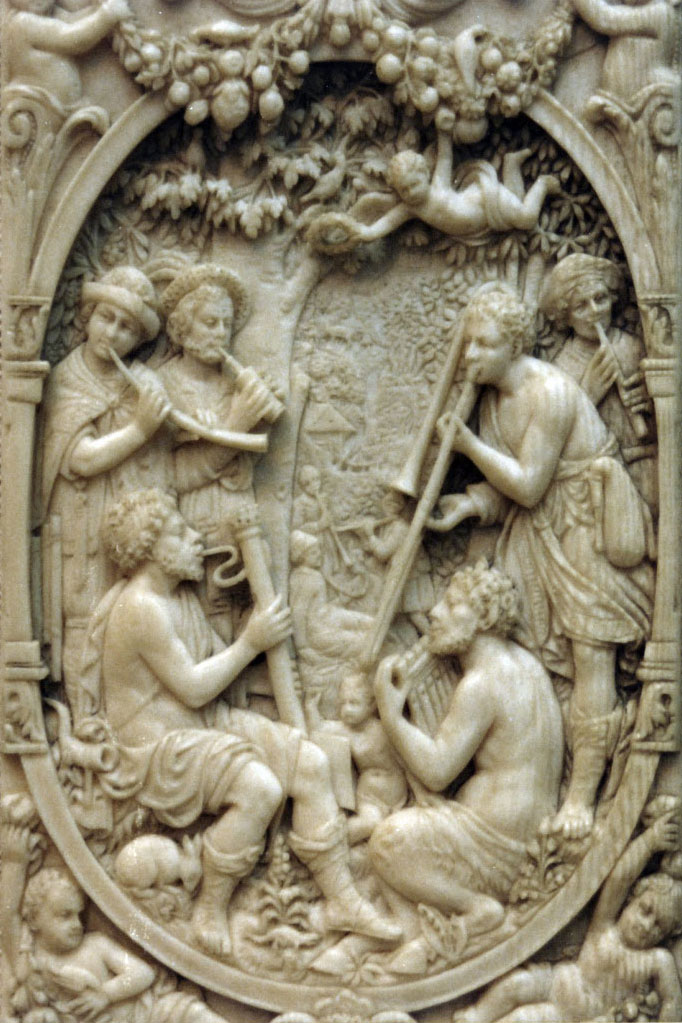
1619—Wolfenbüttel, Germany: In his Syntagma Musicum II, Michael Praetorius calls the trombone (posaun) the “wind instrument par excellence in concerted music of any kind.” He continues, “A skilled player can play at will in all sorts of keys through tones and semitones, and can go beyond the compass in either direction; not only by inserting and extracting the crook (called cromette) and the other extension-piece (polette), but also by practiced control of embouchure and wind-pressure, without using the slide at all.” Praetorius uses the term posaun, but lists the following additional terms for the instrument: trombone, tuba ductilis, tuba oblonga, trombetta (Praetorius-Crookes II 44; Praetorius II 35).
1619—Wolfenbüttel,Germany: Michael Praetorius, discussing tuning in his Syntagma Musicum II, reveals qualities valued in contemporary trombone performance, asserting that the lower the trombones are tuned, “the more solemn and stately they will sound” (Praetorius-Crookes II 31).
1619—Wolfenbüttel, Germany: Michael Praetorius claims that there is no better guide to a correct pitch standard than a tenor trombone of Nuremberg make, with the slide extended by a width of two fingers. (Trombones from the period do seem reasonably standardized in dimensions, according to historians, and provide a pitch of roughly a’=460).
1619—Wolfenbüttel, Germany: Praetorius, discussing tuning, reveals some qualities that are valued in trombone playing at the time, asserting that the lower tuned the trombones are, “the more solemnly and majestically they present themselves” (Praetorius-Crookes II 31).
1619—Wolfenbüttel, Germany: In his Syntagma Musicum II, Praetorius details an acceptable way of performing Quo properas, a double-choir, 10-voice motet by Orlando di Lasso. He recommends trombone in 8 of the 14 sections, thus using the trombone more than any other instrument.
1619—Wolfenbüttel, Germany: In his Syntagma Musicum II, Praetorius includes the following paragraph about some noteworthy trombone players: “Some players, however—among them Phileno, the famous Munich virtuoso—have taken this instrument to even greater lengths by assiduous practice. They can play without discomfort from bottom D to top c, d, or e in the soprano register. In fact, I myself have heard in Dresden the player Erhardus Borussus, who is supposed to be living in Poland now: he could take this instrument almost as high as a cornett (reaching the top g sol re ut) and as low as a quart-posaun, down to A. He was capable of the fast coloratura divisions that are played on a viola bastarda or a cornett” (Praetorius-Crookes II 43).
1619—Wolfenbüttel, Germany: In his discussion of cornetto torto, a cornetto pitched in the tenor range, Praetorius states, “However, since its sound is unpleasantly horn-like [hornhafftig], I think it better to use a trombone in its place” (Praetorius-Crookes II 47).
1619—Wolfenbüttel, Germany: Michael Praetorius, in his Syntagma Musicum III, writes enthusiastically about a mixed consort he says is in use in England: “The English quite appropriately refer to a consortio as ‘consort,’ when several people with assorted instruments, such as harpsichord [Clavicymbeln] or double harpsichord [Großspinet], large lyra viol, double harp, lutes, theorbos, pandoras, penorcon, cittern, violas da gamba, small discant violin [Geig], transverse flute or recorder, sometimes also a soft trombone or recorder, play harmoniously together, softly and sweetly in a charming ensemble (Praetorius-Kite-Powell III 19).
1619—Wolfenbüttel,Germany: Praetorius, in his Syntagma Musicum III, discusses use of various instrumental configurations: “In the instrumental choir it is only instruments such as trombones, cornetts, curtals, flutes, or violins [Geigen] that perform; it is added to the vocal choir; that is, to the concertato voices, for the sake of greater weight and a fuller, more pleasing sound” (Praetorius-Kite-Powell III 126). Discussing the Italian style of vocal soloists with accompaniment, he says, “They do not like this style as they believe it is too sparse, and that it has no particular attraction or harm for those who have no understanding of music. Therefore I had to come up with the solution of adding a four-part choir or consort of either trombones or violins [Geigen] that could play along at all times. And because such a sound is somewhat more pleasing to the ear when arranged in this fashion in the church, I have earned the public’s approbation” (Praetorius-Kite-Powell III 126).
1619—Wolfenbüttel, Germany: Praetorius, explaining the expectations of table musicians in his Syntagma Musicum III, recommends alternating voices with various instruments, including trombone.
1619—Wolfenbüttel, Germany: Praetorius, discussing canzoni in his Syntagma Musicum III, mentions various groups of wind instruments, detailing specific transpositions. He says, “And both of these (nos. 3 & 4), as well as the first two in the Hypoionian mode, can be played on 6 crumhorns if they are transposed up a tone. The following, however, is played at pitch on crumhorns, but a fifth lower on curtals, pommers and trombones [posaunen].” Elsewhere he suggests an ensemble of one chor of 4 crumhorns and another chor of 4 trombones (posaunen). Given the music and clefs he shows, Praetorius recommends that the entire ensemble transpose down a fourth.
1619—Date of trombone made in Nuremberg for George Ehe. The Ehe family is a major brass dynasty in Nuremberg. The instrument has the bore of a tenor trombone, but the tube length is longer than normal, making it a major 2nd or minor 3rd below standard pitch (Young 43). One expert has remarked specifically on the craftsmanship of the instrument: “Perhaps the finest example of the solderer’s art on a musical instrument can be seen on the flawless toothed bell seam…” (Barclay 34).
1619—Wolfenbüttel, Germany: Polyhymnia caduceatrix et panegyrica, a collection by Michael Praetorius of compositions based on Lutheran hymns, includes vater unser im Himmelreich, a hymn accompanied by contrasting groups of 4-part strings and 4-part trombones (Leaver 281). Many others call for trombone, including Das alte Jahr ist nun vergahn, Nun komm der Heiden Heiland, Wachet auf, Christ unser Herr zum Jordan kam (3 trombones), Jubiliret frölich, In dich hab ich gehoffet Her (4 trombones), Als der gütige Gotte, Lob sei dem allmächtigen Gott, Erhalt uns Herr bei deinen Wort (4 trombones), In dulci jubilo, Wenn wir in höchsten Nöten sein (3 trombones), and Herr Christ der einzig Gottes Sohn (Collver 151).
1619—Dresden, Germany: Heinrich Schütz publishes Psalmen Davids, his first major collection of German church works. Many of the works include prominent trombone parts and obbligato roles (Smallman 35, 37, 42). Herr unser Herrscher and Zion spricht, der Herr hat mich Verlassen both call for 4 trombones, for example, while Ist nicht Ephraim mein theurer Sohn and Wol dem, der den Herren fürchtet call for 3 trombones (Collver 168).
1619—London, England: Robert Parker successfully competes against Henry Field for an open position with the town waits. Parker is reportedly especially good on wind instruments; among his many instruments are double sackbut, violen, and low tenor violin. He holds his position until 1649 (Woodfill 249).
1619—Bristol, England: City leaders, who feel that the Bristol town waits, consisting of 4 players, need strengthening, resolve to grant a salary “to a fifth man to play with the other musitions of the City on the saggebutt to make up a fifth part.” (Bridge, Town Waits and Their Tunes).
1619—Derbyshire, England: An anonymous ceiling painting in the Heaven Room of Bolsover Castle shows Christ’s ascension, surrounded by angels. The outer circle of angels features angels with several different musical instruments, including trombone (see detail and full image below; public domain) (Drury 25).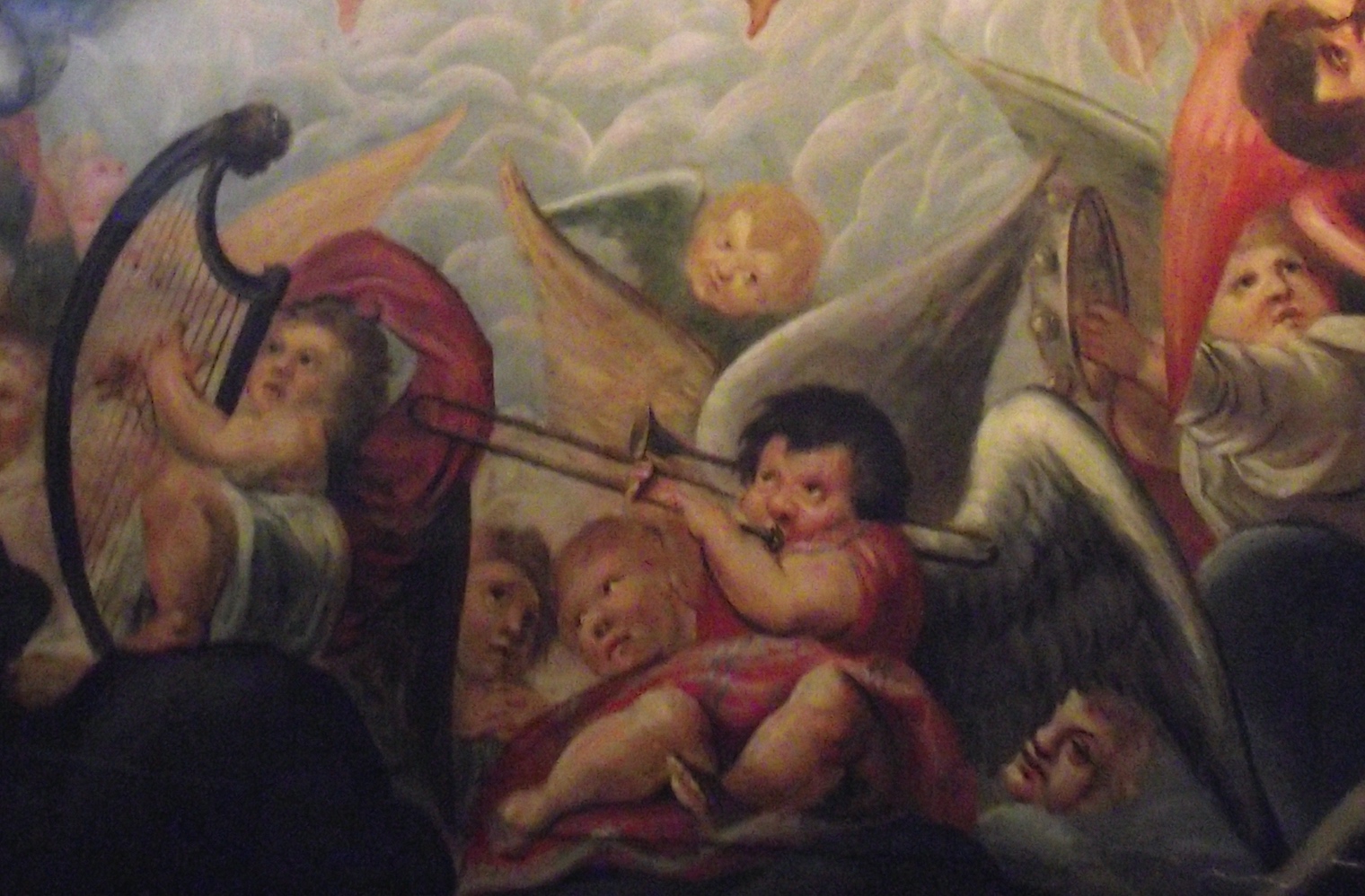
1619—Greiz, Germany: The Stadtpfeifer play “spiritual songs” on trombones at 3:00 am, 9:00 am, and 7:00 pm. (At 9:00 am and 4:00 pm they play on trumpets) (Whitwell, Baroque 156).
1619—Parma, Italy: An Assumption Day celebration at the cathedral includes 21 singers accompanied by cornetts and trombones (Kurtzman, Monteverdi Vespers 381).
1619—Venice, Italy: Francesco Usper writes Compositioni armoniche. It includes Sonata a 8, which calls for 4 trombones, 2 cornetts, 2 violins, and continuo; Beatus qui intelligit, which utilizes 3 trombones (including “Trombone Grosso”); and Ego dormio a 8, which utilizes 4 trombones (Collver 71, 179).
1619—Modena, Italy: Motetti spirituali by Sulpitia Cesis calls for 2 trombones (Collver 99).
1619—Siena, Italy: Lorenzo Mini, who has been singing with the choir since 1617, replaces his former teacher, Alberto Gregori, as cathedral trombonist. He holds the trombone post until his death in 1626, whereupon Alberto Gregori resumes the role (Reardon, Agostino Agazzari 53).
1619-20—Giovanni Priuli’s Canzon prima a 12 is published as part of a collection that includes a number of canzoni featuring trombone.
c. 1620—Giovanni Valentini calls for 2 cornetti and 2 trombones in Canzon a 4.
c. 1620—Imola, Italy: Visione di S. Cecilia e angeli, a painting by Giovanni Battista Bertusio (1577-1644) located in chiesa di S. Agata, includes a depiction of an angel playing trombone (see detail and full image below; public domain) (Negro and Roio 37).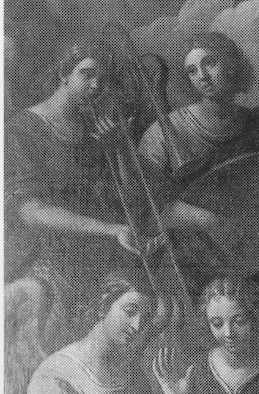
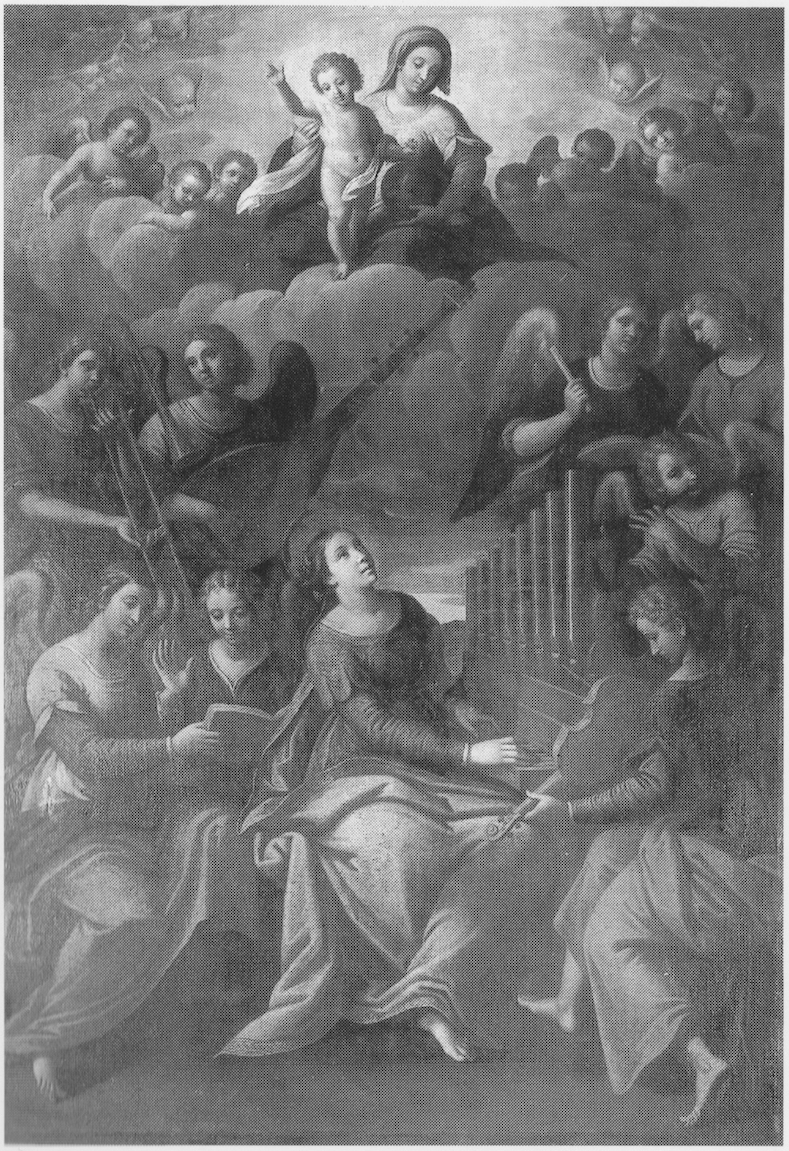
c. 1620—Bienno, Italy: A painting by Giovanni Mauro della Rovere (also known as Fiammenghino) in the Chiesa Parrocchiale de Bienno includes a depiction of an angel playing trombone among a large group of angel musicians (see detail and full image below; public domain).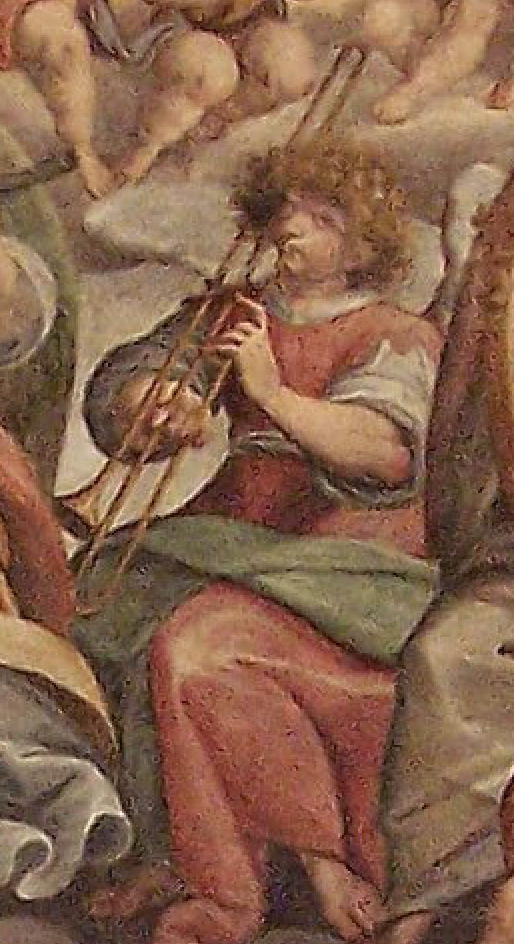
c. 1620—Italy: Italian Baroque painter Bernardo Strozzi includes a putto holding a trombone in the painting, Santa Cecilia con le teste di Valeriano e Tiburtio (see below image; public domain) (source: The Digital Library of the National Library of France).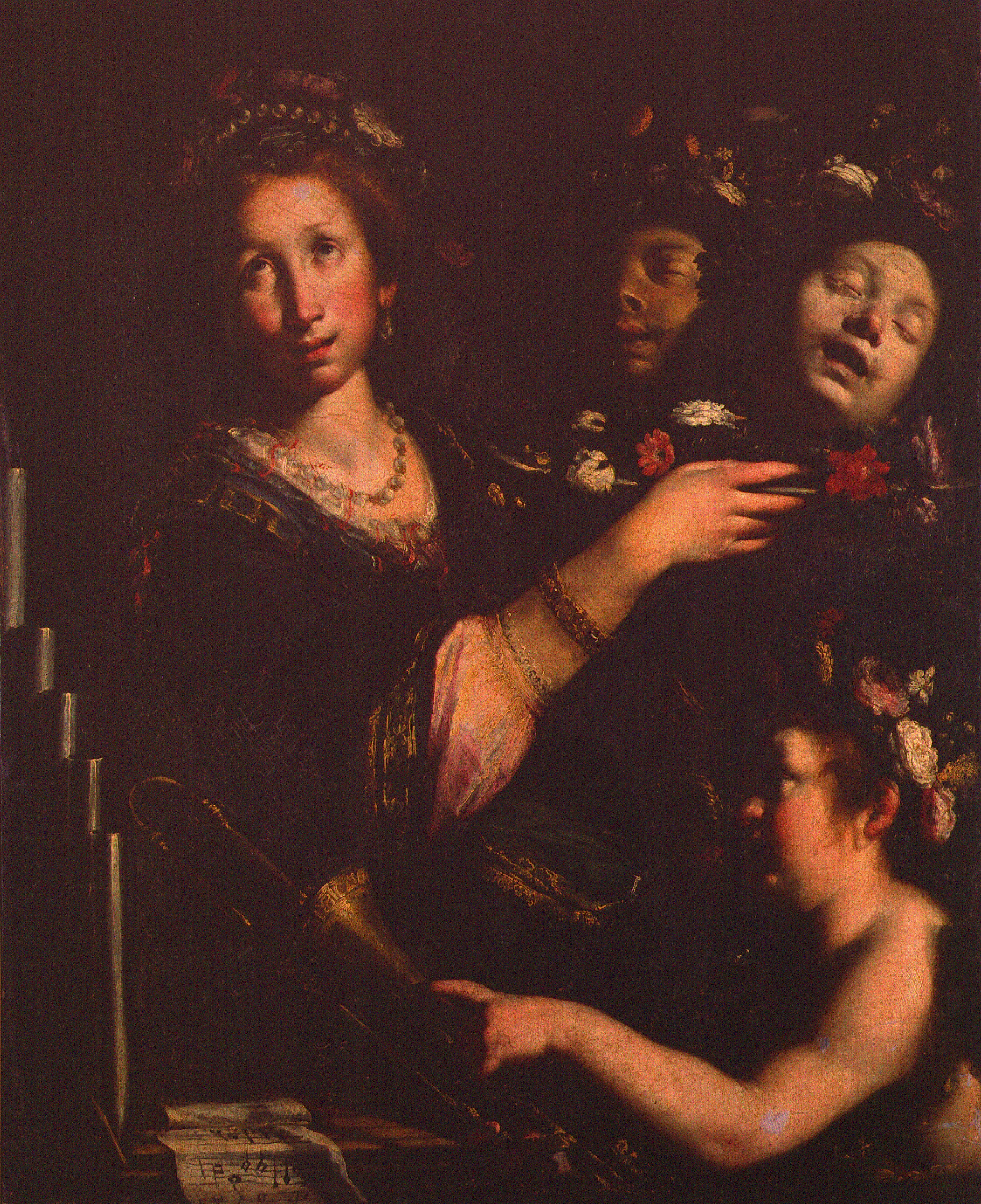
c. 1620—Vicenza, Italy: A painting by Vincenzo Maganza in the church of San Stefano features 4 musical angels, including an angel-trombonist (see below image; public domain) (Die bemalten Orgelflügel 564; Palladio e la Maniera 126).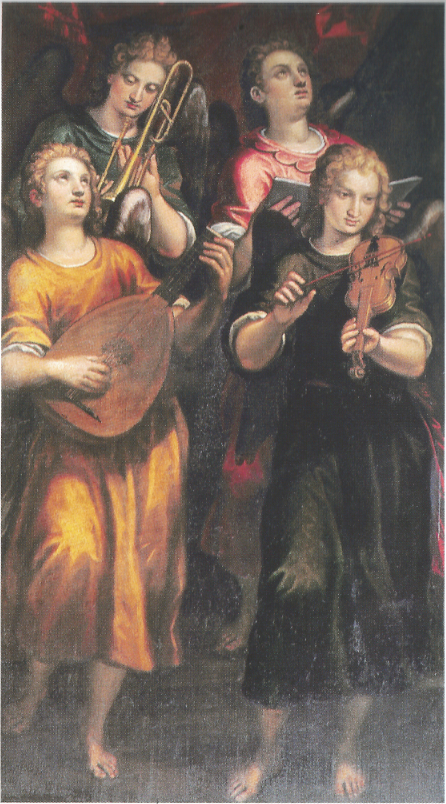
c. 1620—Genio delle arti (Genius of the Arts), a painting by Carlo Bononi, includes a trombone (see first image below; public domain) (Benati 19; Collezione Roberto Lauro, Bologna). An anonymous print duplicates the painting closely (see second image below; public domain) (Moir pl. 44). Located at the foot of the angel, the trombone is noteworthy for its bell flare, which would appear to be slightly more pronounced than that of other trombones of the period. The image belongs to an interesting group of allegorical art works from the 17th century that feature trombones, including Brueghel’s Allegory of Hearing, Van Kessel’s Allegory of Music, and a Czech wall painting from Rozmberk Castle entitled Allegory of Music.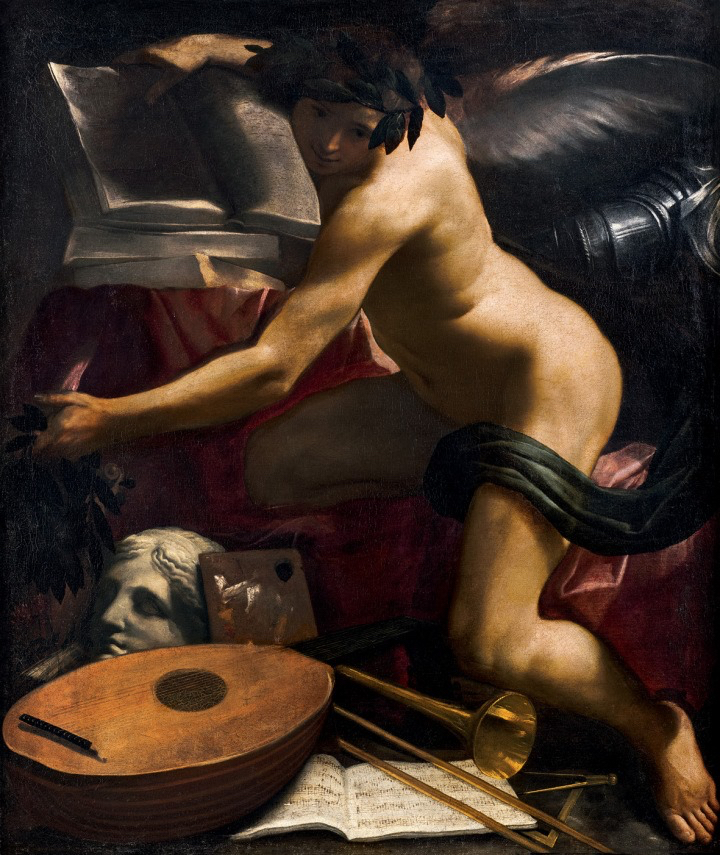
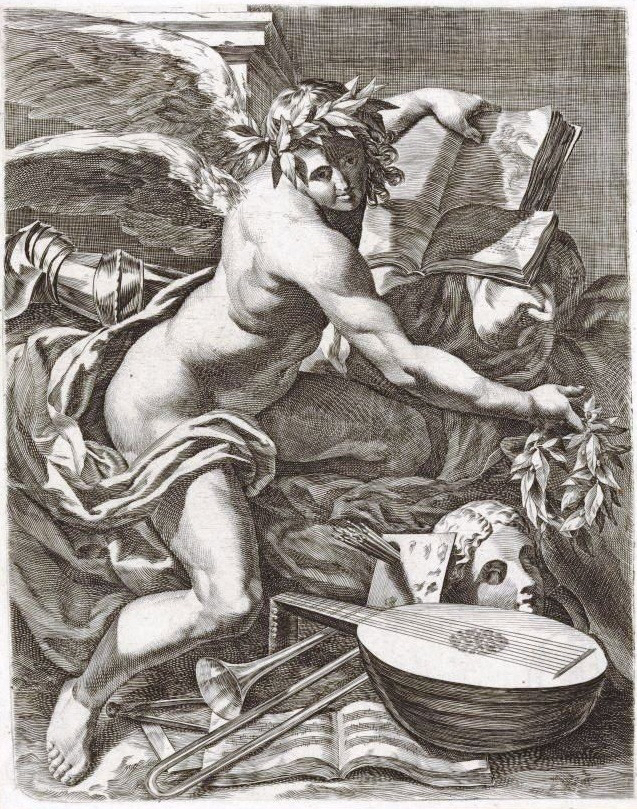
c. 1620—Antwerp, Belgium: In a painting called Minerva Visits the Nine Muses, attributed to Hendrick van Balen and Jan Brueghel the Elder, a trombone rests upon the ground among several other musical instruments (see below image; public domain).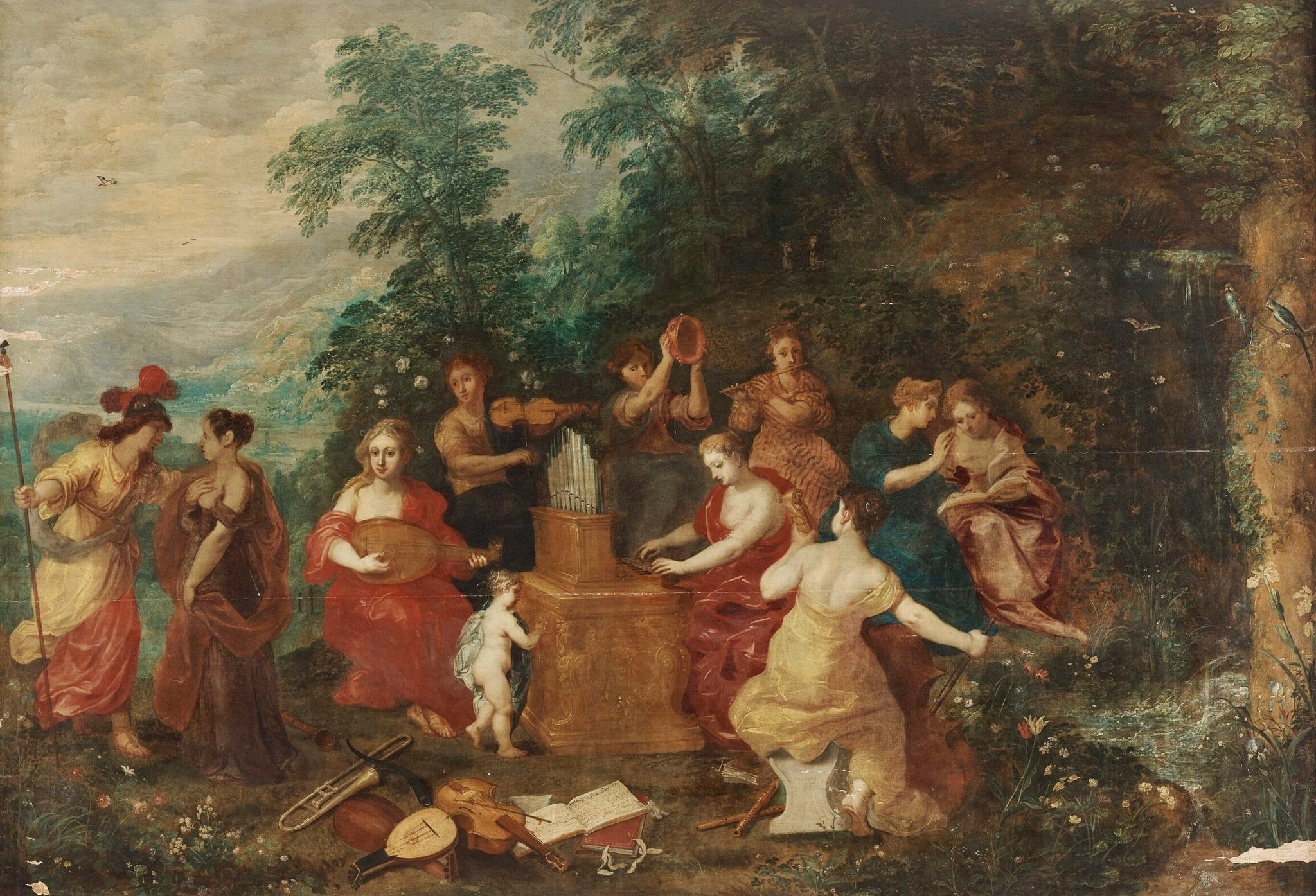
c. 1620—Valencia, Spain: Composer Juan Bautista writes a vernacular song, “Quién será aquel caballero,” with a texted voice labeled Tiple and 3 untexted voices labeled Bajoncillo, Sacabuche, and Bajón grande (Kreitner, Minstrels in Spanish Churches).
c. 1620-24—Seville, Spain: The altarpiece of the Virgin of the Rosary of the Parish of Santa Ana, probably painted by Diego López Bueno and Miguel Cano, includes a depiction of an angel playing trombone (see bottom-right of below image; public domain) (Alonso Cano 613).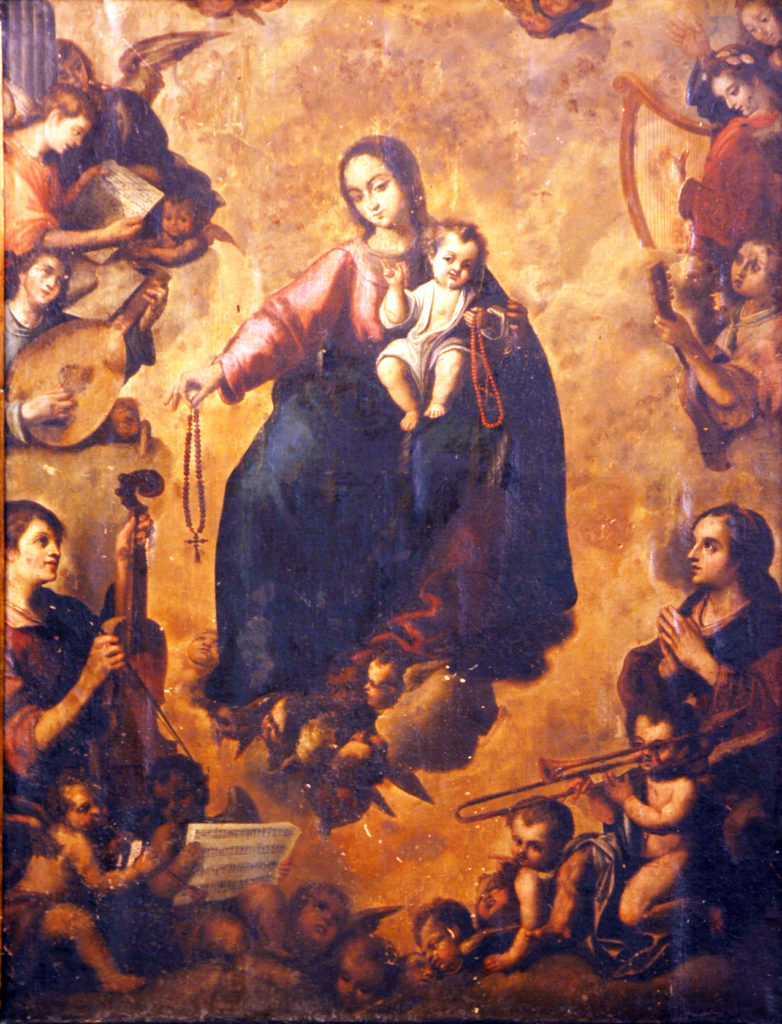
1620—Italy: Giovanni Baglione’s painting, Euterpe, Muse of Music, includes a trombone (see below image; public domain).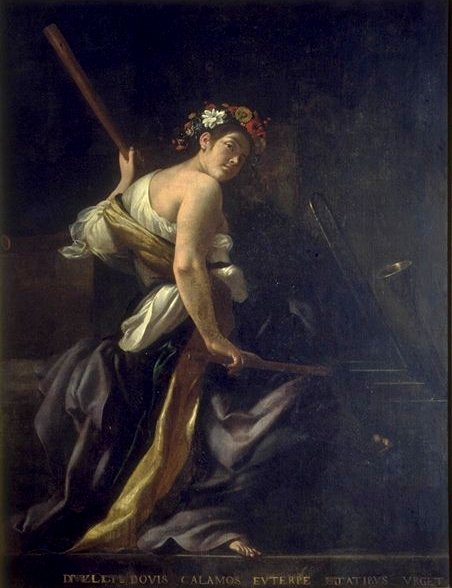
1620—Germany: Woodcuts of the various members of the trombone family appear in Michael Praetorius’s Sciagraphia, a collection of illustrations appended to Syntagma musicum (Treatise of Music). The trombones pictured include alt or discant posaun (comparable to modern alto), gemeine posaun (comparable to modern tenor), quart- or quint-posaun (bass trombones, fourth and fifth below tenor), and octav posaun (contrabass, an octave below tenor) (see below image; Praetorius II, plate 8; public domain).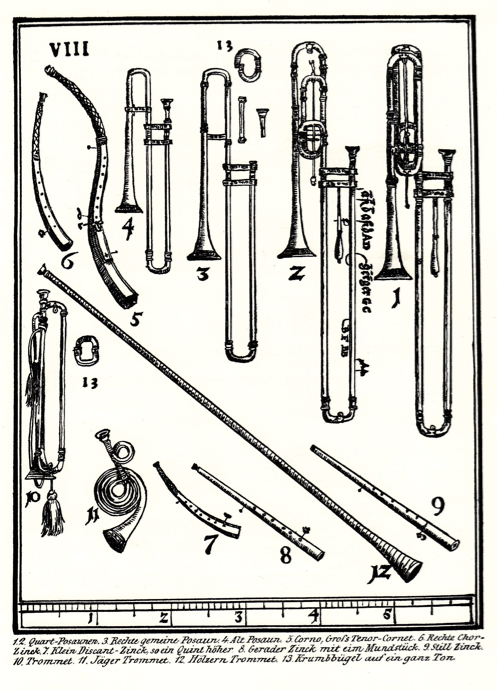
 1620—Germany: Also included, on a separate plate of Praetorius’s Sciagraphia, is a highly-decorated bass trombone similar to an extant trombone by Johann Isaac Ehe (Nuremberg, 1612) (Praetorius II, plate 6; Naylor 196; public domain image).
1620—Germany: Also included, on a separate plate of Praetorius’s Sciagraphia, is a highly-decorated bass trombone similar to an extant trombone by Johann Isaac Ehe (Nuremberg, 1612) (Praetorius II, plate 6; Naylor 196; public domain image).
1620—England: A chronicler records that when King James travels in state to St. Paul’s Cathedral, “by them conducted into the Quire; where having heard the Divine service for that day most solemnly performed with Organs, Cornets, and Sagbots, they went to a prepared place…” (Heylyn 20).
1620—Bergamo, Italy: At Santa Maria Maggiore, musical records list 4 instruments: 2 violins, cornett, and trombone (Roche, Maggiore).
1620—Italy: Ercole Porta’s Mass is scored for five-part choir, 3 trombones, and 2 violins (Roche, North Italian 140).
1620—Italy: Ercole Porta’s L’Animosa and La Spensierata, both 2-part works, are scored for trombone and violin (Winkler 300).
1620—Milan, Italy: Francesco Rognoni’s improvisational treatise, Selva di varii passaggi, includes a setting of Lassus’s song, Susanne un jour. Marked “Modo di passegiar il violone over trombone alla bastarda,” it features rapid technical passages to be played on either violone or trombone (Baines, Brass 114; Guion, Short History; Herbert, Trombone 87).
1620—Venice, Italy: Giovanni Battista Riccio calls for trombone in a collection of canzoni (Selfridge-Field, Instrumentation). Specific examples include Canzon La Fineta, a 2-part work for trombone and violin; Canzon La Savoldi, a 2-part work for trombone and violin; Canzon La Picchi, a 2-part work for trombone and violin; Canzon La Rubina, a 3-part work for 2 violins or cornetts and trombone, and Canzon La Moceniga, a 3-part work for 2 violins and 2 trombones (Winkler 300).
1620—Naples, Italy: Two frescoes by Belisario Corenzio at the church of Gesu Nuovo include angels playing trombone (see below images; public domain) (Romano 10, 19).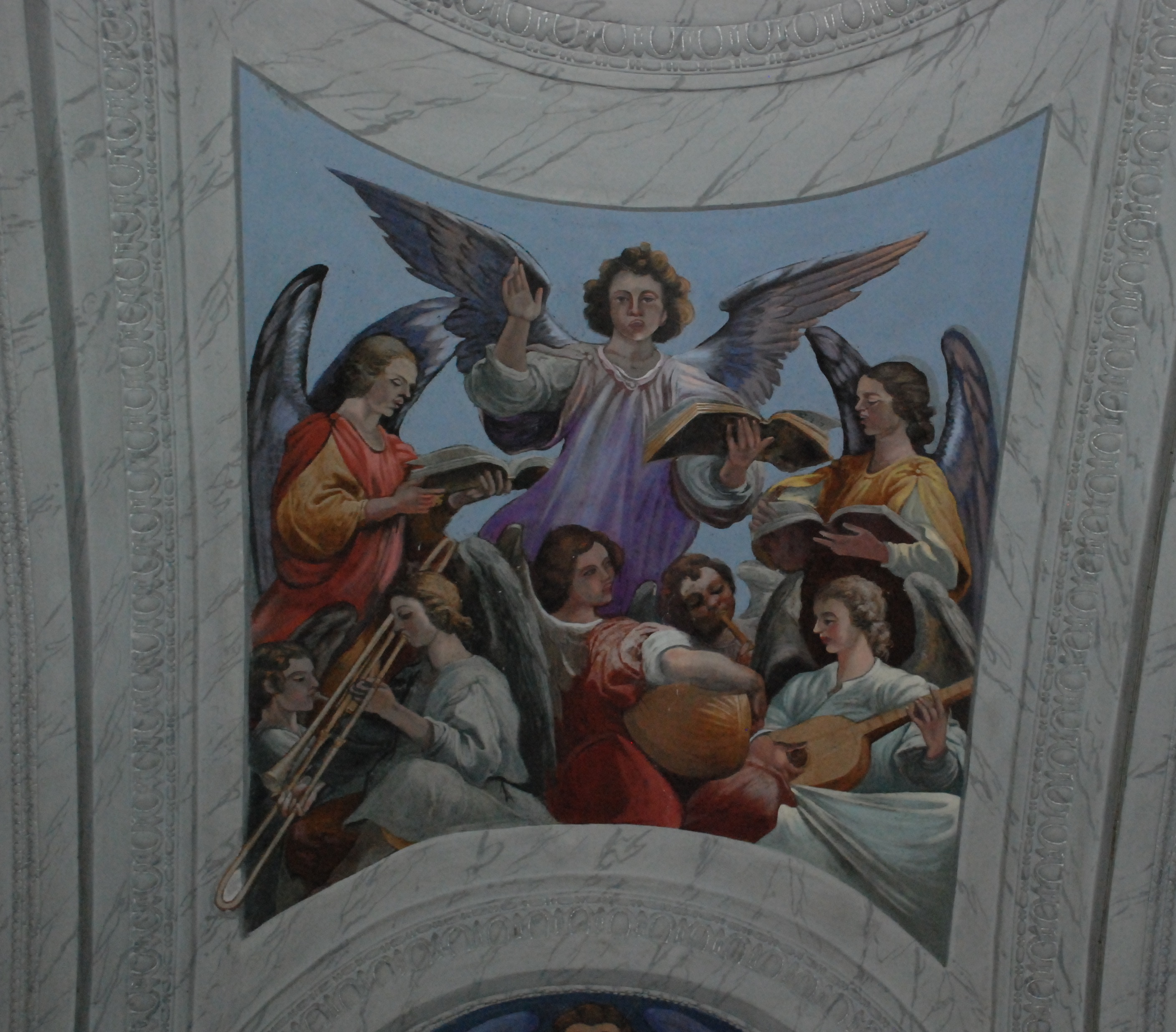
1620—England: King James visits St. Paul’s cathedral, where musicians “with solemn singing brought the king into the quire [and] they began to celebrate Divine Service, which was solemnly performed with organs, cornetts, and sackbuts” (Woodfill 149).
1620—Italy: Ercole Porta’s Corda Deo dabimus, contained in the collection Sacro convito, is scored for soprano voice, alto voice, and 3 trombones. Historian Jerome Roche later coins the phrase “trombone motet” for this type of piece, a genre that culminates in Schütz’s Absalom fili mi (1629) (Roche, North Italian 82). Also from the same collection is Porta’s Messe secunda toni, which calls for 2 violins and 3 trombones to accompany a 5-part choir; when doublings occur, trombones double the 3 lowest voices (Schnoebelen, The Role of the Violin).
1620—Seville, Spain: Among the leading ministriles mentioned in records of the Seville cathedral are trombone players Alonso Ortega and his son Diego, and Juan de Viedma (Stevenson, Christmas Music from Baroque Mexico 68).
1620—Leipzig, Germany: Johann Hermann Schein writes Lyrica Davidica, which calls for trombone (Collver 163).
1620—Tröchtelborn, Germany: Michael Altenburg (1584-1640) publishes the collection Der dritte Theil, which includes at least 2 intradas that call for trombone (Collver 76).
1620—Milan, Italy: Francesco Rognoni, Divisions on Palestrina’s Pulchra es.
1620—Bologna, Italy: Banchieri’s collection of sonatas specifies trombone and violone (Selfridge-Field, Instrumentation). Specifically, Sonata sopra l’Aria del Gran Duca calls for trombone and 2 violins (Winkler 299).
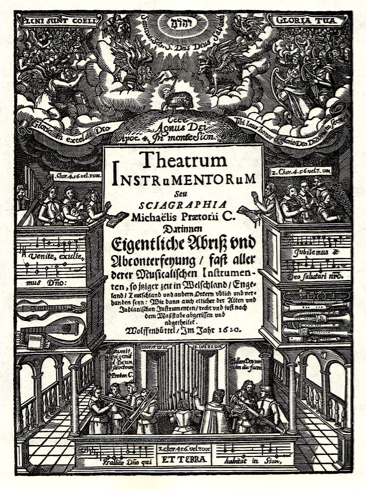 1620—Germany: The title page of Praetorius’s Sciagraphia (a collection of illustrations appended to Syntagma musicum) depicts a performance of several church musicians, including 2 trombones (see facing image; public domain) (Praetorius II).
1620—Germany: The title page of Praetorius’s Sciagraphia (a collection of illustrations appended to Syntagma musicum) depicts a performance of several church musicians, including 2 trombones (see facing image; public domain) (Praetorius II).
c. 1620-24—Wolfenbüttel, Germany: The organ is installed at the Wolfenbüttel Hauptkirche. Paintings located under the organ balcony, which probably date from the same period, include an angel playing trombone (see below image; public domain).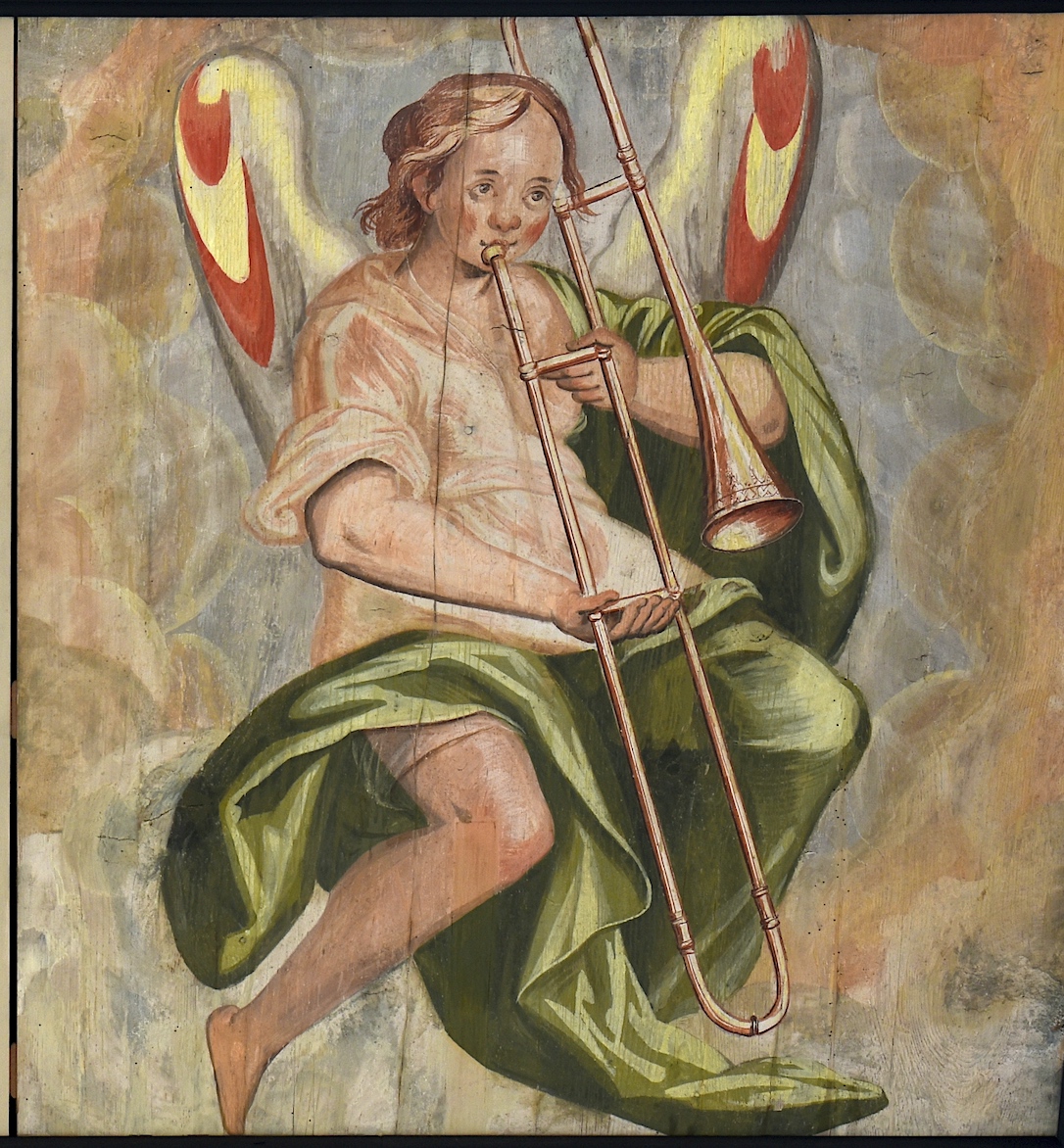
1620s—Italy: Francesco Gregori is employed as trombonist and cornettist at music chapels in Malta and Caltagirone (Reardon, Insegniar 127).
1621—Germany: An ordinance at the Württemberg court of Duke Johann Friedrich requires the trombone and cornett players to appear without fail for the choir rehearsals during the week (Whitwell, Baroque 206).
1621—London, England: John Adson, a London wait, composes Courtly Masquing Ayres composed to 5 and 6 Parts for Violins, Consorts, and Cornets. Three of the 5-part works (airs 19, 20, and 21) are specifically scored for “Cornets and Sagbuts” (Collver 40; Boyd 163; Whitwell, Catalog Baroque 12). See altus part from air 19 below (public domain).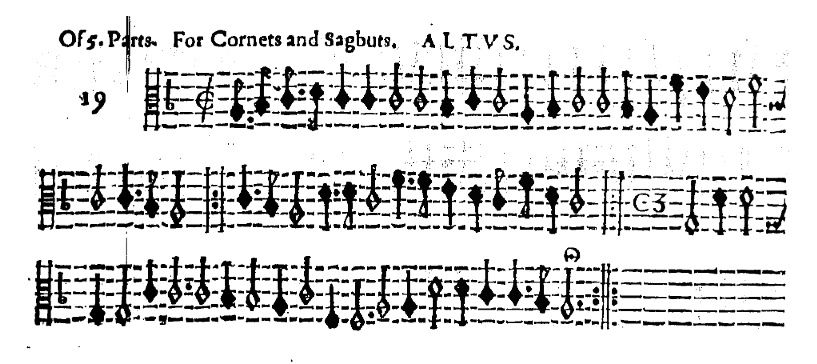
1621—Venice, Italy: Dario Castello, a member of the piffaro (wind band), composes numerous chamber compositions with parts for 1 or 2 trombones, particularly in his Quinta Sonata from Book I (Selfridge-Field, Instrumentation; Wigness 9). Referring to the virtuosic technical demands of the trombone parts in these sonatas, the second edition of Book 1 includes the following note: “He says, in short, that they are the consequence of the new style everyone is observing and hopes that the players will not give up on the first try” (Wigness 10). Specific pieces include Quarta Sonata (No. 47), Quinta Sonata (No. 48), and Sesta Sonata (No. 49), all of which are 2-part works scored for soprano and trombone or violetta, as well as Duodecima Sonata (No. 50), which is a 3-part work scored for 2 violins and trombone or violetta (Winkler 300).
1621—Venice, Italy: Stefano Bernardi’s (1585-1636) 7 Canzonas a 3 from Madrigaletti a due et a tre voci specify the following for the bottom musical line: theorbo or bassoon or trombone. The other 2 voices are to be played by either 2 cornetts or 2 violins (Collver 43).
1621—Johann Schein’s, Musica Boscareccia, which contains music of 3 melody lines, specifies the following for the third line: “bass voice or trombone or bassoon or violone” (Dart, Interpretation 128).
1621—Munich, Germany: At the Bavarian court, cornettist and trombonist Giulio Martino Cesare writes a collection of 28 instrumental and vocal works titled Musicali Melodie. It includes “La Hieronyma,” the earliest known solo work to specify trombone. Also included are “La Augustana,” for cornett (or violin) and trombone, “La Costanza,” for 2 cornetts (or violins) and trombone, “La Famosa,” for 2 cornetts (or violins) and trombone, “La Gioia,” for 2 cornetts (or violins) and trombone, “La Bavara,” for 4 trombones, “La Monachina,” for 3 cornetts and trombone, “La Fenice,” for 2 cornetts and 2 trombones, and “La Vittoria,” for 3 cornetts and 3 trombones (Whitwell, Catalog Baroque 122; Collver 47; Winkler 300). Also included is a motet for one voice and 3 trombones (Dickey, Cornett and Sackbut 107).
1621—London, England: Richard Brathwaite’s Some Rules and Orders for the Government of the House of an Earle describes use of trombones at banquets: “At great feasts, when the earl’s service is going to the table, they are to play upon shagbut, cornetts, shawms, and such other instruments going with wind” (Bowles, Musical Ensembles 125).
1621—Bergamo, Italy: At Santa Maria Maggiore, music for the feast of the Assumption includes 2 trombones (Roche, Maggiore).
1621—Valladolid, Spain: Procession of Our Lady of San Lorenzo, a painting by Matias Velasco in the Church of San Lorenzo, includes a trombone among a group of musicians (see detail and full image below; public domain).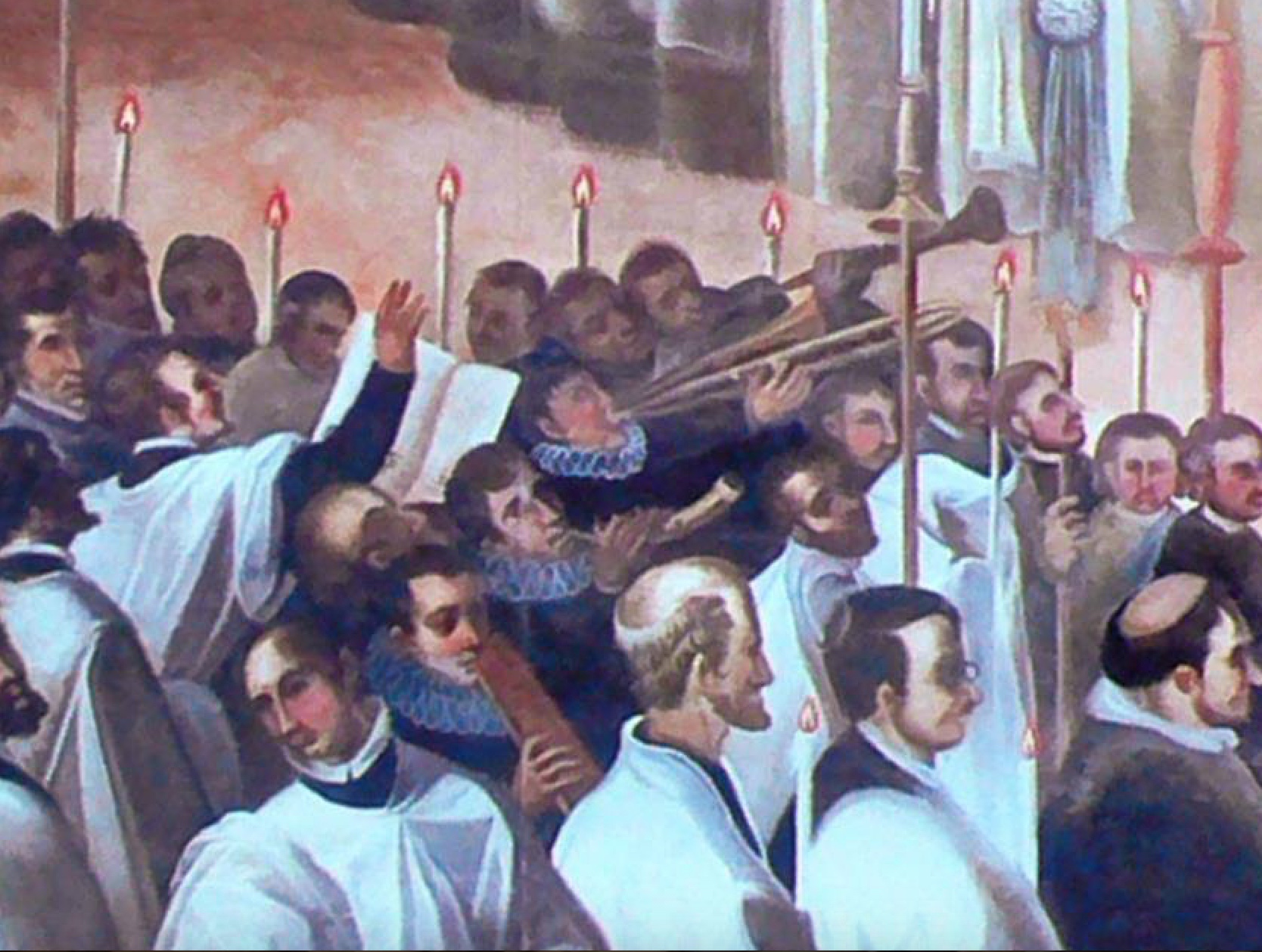
1622—Siena, Italy: At the church Santa Maria di Provenzano, the 4-singer chapel is augmented with a trombone for the Christmas season (Reardon, Music and Musicians).
1622—Italy: Adriano Banchieri writes several works scored for violin, trombone, and organ: Prima Sonata, Seconda Sonata, Terza Sonata, and Quarta Sonata (Winkler 300).
1622—Venice, Italy: By this date, P.A. Mariani writes Canzon Per il Deo Gratias, a 2-part work for violin and trombone (Winkler 300).
1622—Norwich, England: A document dealing with the town waits indicates that the group owns at least 3 trombones (Whitwell, Baroque 170).
1622—Hamburg, Germany: Samuel Scheidt calls for trombone in his vocal work, Pars prima concertuum sacrorum. For example, both Concertus III and Concertus XII utilize multiple trombones (Collver 163).
1622—Vincenz Jelic [Jelich] writes Parnassia militia, which contains 4 ricercari for cornett, trombone, and continuo (Whitwell, Catalog Baroque 131; Collver 54).
1622—Giacinto Bondioli (1596-1636) includes 7 canzoni in his collection, Soavi fiori colti, that call for cornetto (or violin), trombone (or bassoon), and organ (Collver 44).
1622—La Plata, Bolivia: A silversmith is paid for repairs to the trombone owned by La Plata Cathedral (Bermúdez).
c. 1623—Lima, Peru: The permanent instrumental ensemble at the chapel includes a trombone (Mendoza de Arce 140).
1623—Varese, Italy: Cappella XI, cappella della Resurrezione, of Sacro Monte, is completed. The semicircular apse features a fresco by Isidoro Bianchi that includes what is probably a trombone among one group of angel-musicians (see detail and bottom-left of full image, below; click image to expand; public domain) (Angelis 147).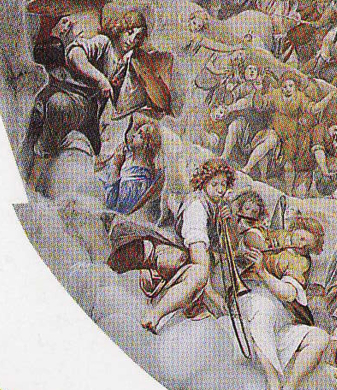
1623—York, England: The York House Books show that the town waits own a sackbut (Woodfill 85).
1623—Casalmaggiore, Lombardy: Ignazio Donati’s psalm collection, Salmi boscarecci, features instrumental accompaniment of 3 trombones (or bassoons) and 3 violins (or cornetts). The composer instructs, “If one wishes to use the last six books for both voices and instruments, it should be noted that where it says solo, only the singer should sing, and where it says trombone or violin, only the instrument should play; in passages marked tutti, they both sing and play in unison” (Roche, North Italian 132).
1623—Siena, Italy: At the church Santa Maria di Provenzano, the 4-singer chapel is augmented with a trombone for the Christmas season (Reardon, Music and Musicians).
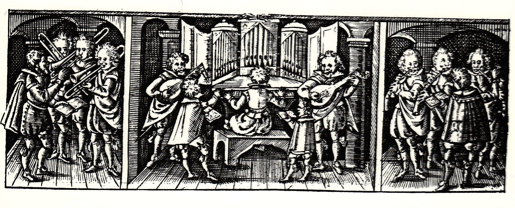 1623—Leipzig, Germany: The title page of Johann Hermann Schein’s Fontana d’Israel features a pure consort of 3 trombonists in one of the panels performing under the direction of a conductor (see facing image; public domain) (Naylor 215).
1623—Leipzig, Germany: The title page of Johann Hermann Schein’s Fontana d’Israel features a pure consort of 3 trombonists in one of the panels performing under the direction of a conductor (see facing image; public domain) (Naylor 215).
c. 1624—Genoa, Italy: Giovanni Andrea Ansaldo’s trompe l’oeil balcony painting in the castle Villa Spinola di San Pietro includes a trombone among numerous other instruments playing from the balcony (see detail and full image below; click to expand; public domain) (Heck, Guitarists in the Balconies).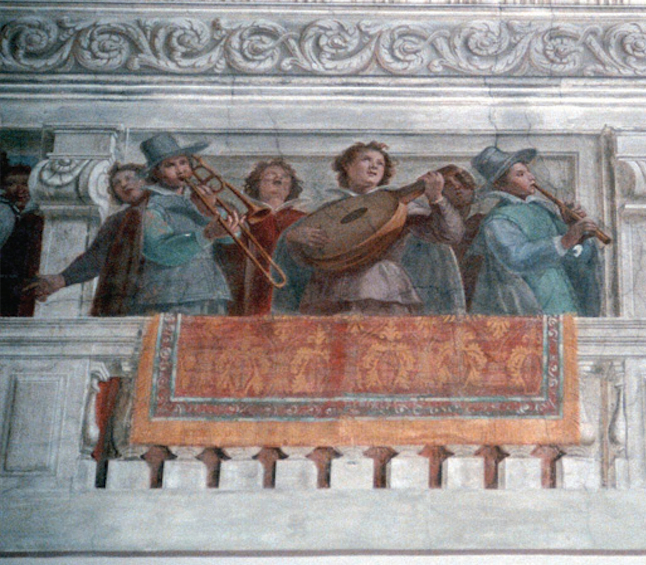
1624—Venice, Italy: A priest by the name of Giovanni Francesco Castello is engaged as a trombonist at San Marco (Selfridge-Field, Dario Castello).
1624—Italy: A Mass by Giovanni Priuli includes ornate parts for trombone, cornett, and violin (Roche, North Italian 140).
1624—Italy: Stefano Bernardi scores for 4 trombones, 4 cornetts, and 4 violins in Sonata ottava a 12 from Il terzo libro de madrigali (Collver 43).
1624—Brescia, Italy: Pietro Lappi calls for trombone in the ripieno of his Messa secondo libro (Collver 129).
1624-25—Milan, Italy: A red-chalk study by Camillo Procaccini for one of the ceiling compartments in the church of SS Paolo e Barnaba includes an angel-trombonist (see below image; public domain) (British Museum; see also Neilson, Camillo Procaccini, Paintings and Drawings, pl. 289).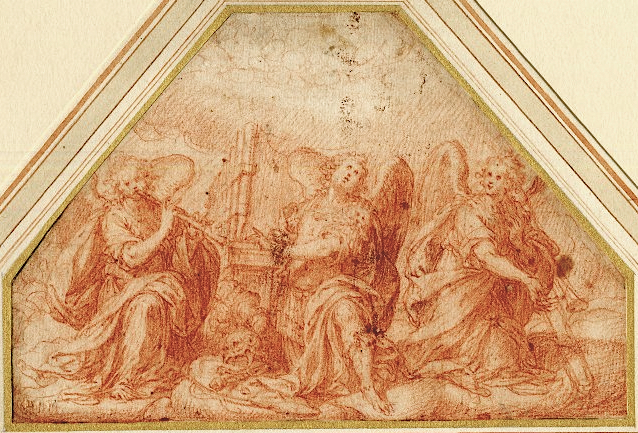
1624-25—England: Records for the King’s Music show livery payments for the following Sagbutts: John Snowesman, Richard Blagrave, Clement Lanier (Ashbee, Records III 133).
1624-1640—Poland: Walerian Trepka writes Liber chamorum, wherein he names more than 100 musicians, including trombones (Przybyszewska-Jarminska, The History of Music in Poland: The Baroque, Part 1, p. 153).
c. 1625—A painting attributed to Jan van Kessel, Hendrik van Balen, and Jan Brueghel titled Allegory of Music features depictions of numerous instruments, including trombone (see below detail; public domain) (Wangermée vol. I, 292; Saint-Germain-en-Laye, Musée municipal).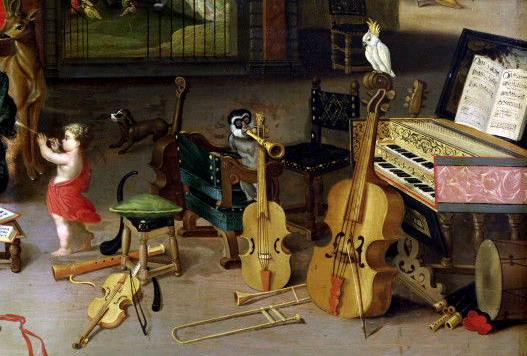
c. 1625—Lübeck, Germany: As part of the city’s extensive ordinances for musicians, weddings are allowed to include processions to and from the church, accompanied by trombones decorated with banners (Buelow, Protestant 203).
c. 1625—Venice: Italy: Alessandro Grandi’s Dixit Dominus calls for trombone (Arnold, Alessandro Grandi).
c. 1625—Antwerp, Belgium: Hans Tilens’s painting, Concert des Muses, includes a trombone resting on the ground (see detail and middle-center of full image below; public domain) (The Digital Library of the National Library of France).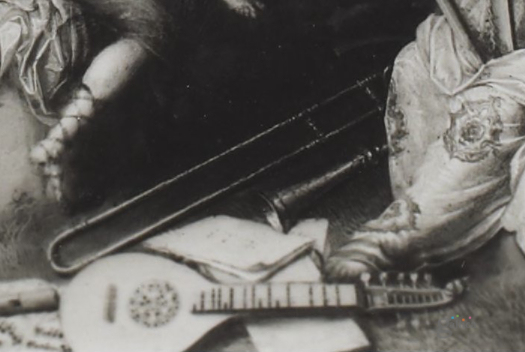
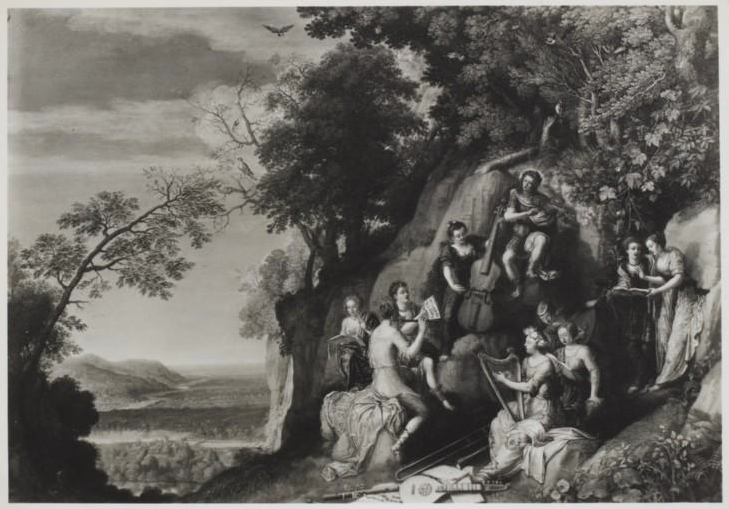
c. 1625—Ascona, Switzerland: Giovanni Serodine paints Coronation of the Virgin with Saints in Ascona’s parish church. The imagefeatures a consort of angel-musicians playing 2 viols, cornetto, and trombone (see below detail of top portion of painting; public domain).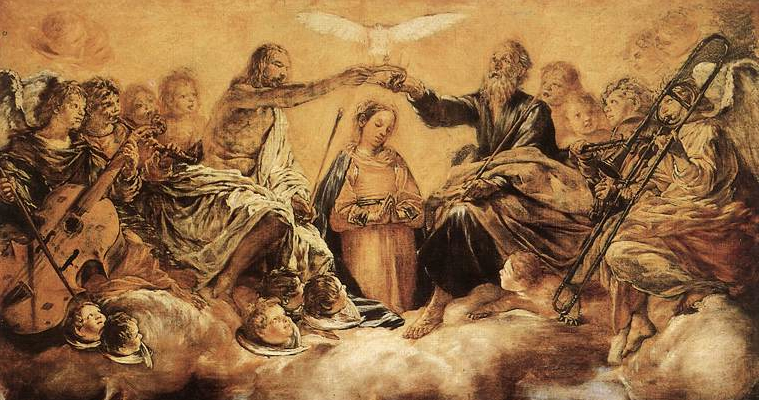
c. 1625—Padua, Italy: Leandro Gallerano, maestro at the Basilica del Santo, uses 2 violins and a trombone as obbligato instruments in a hymn setting in honor of St. Anthony (Roche, North Italian 22).
c. 1625—Milan, Italy: A painting by Giovanni Battista della Rovere (also known as Fiammenghino), originally located the church San Vito al Pasquirolo (subsequentally transferred onto canvas), features an angel playing trombone (see below image; public domain) (Museo d’Arte Antica, Pinacoteca). For a similar rendering of a trombone by his brother, Giovanni Mauro, see 1608 (above).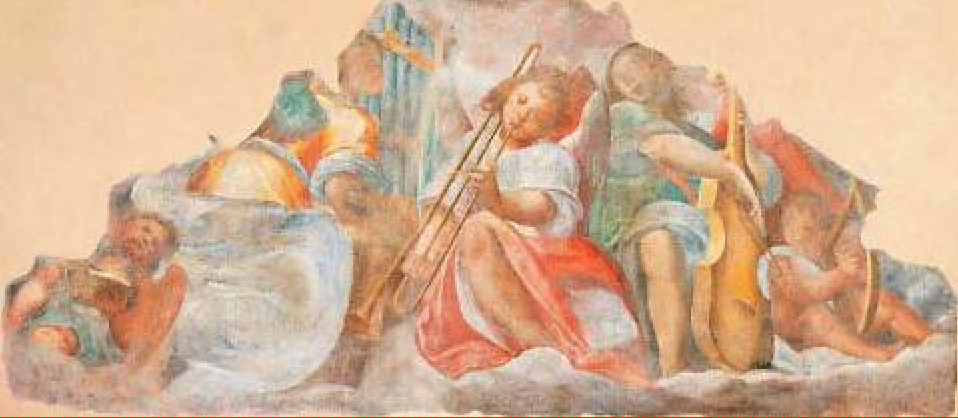
c. 1625—Porto Valtravaglia, Italy: An angel-trombonist is included among a group of angel musicians in a fresco in the Cappella Porta of the church of Santa Maria Assunta (see detail and full image below; public domain).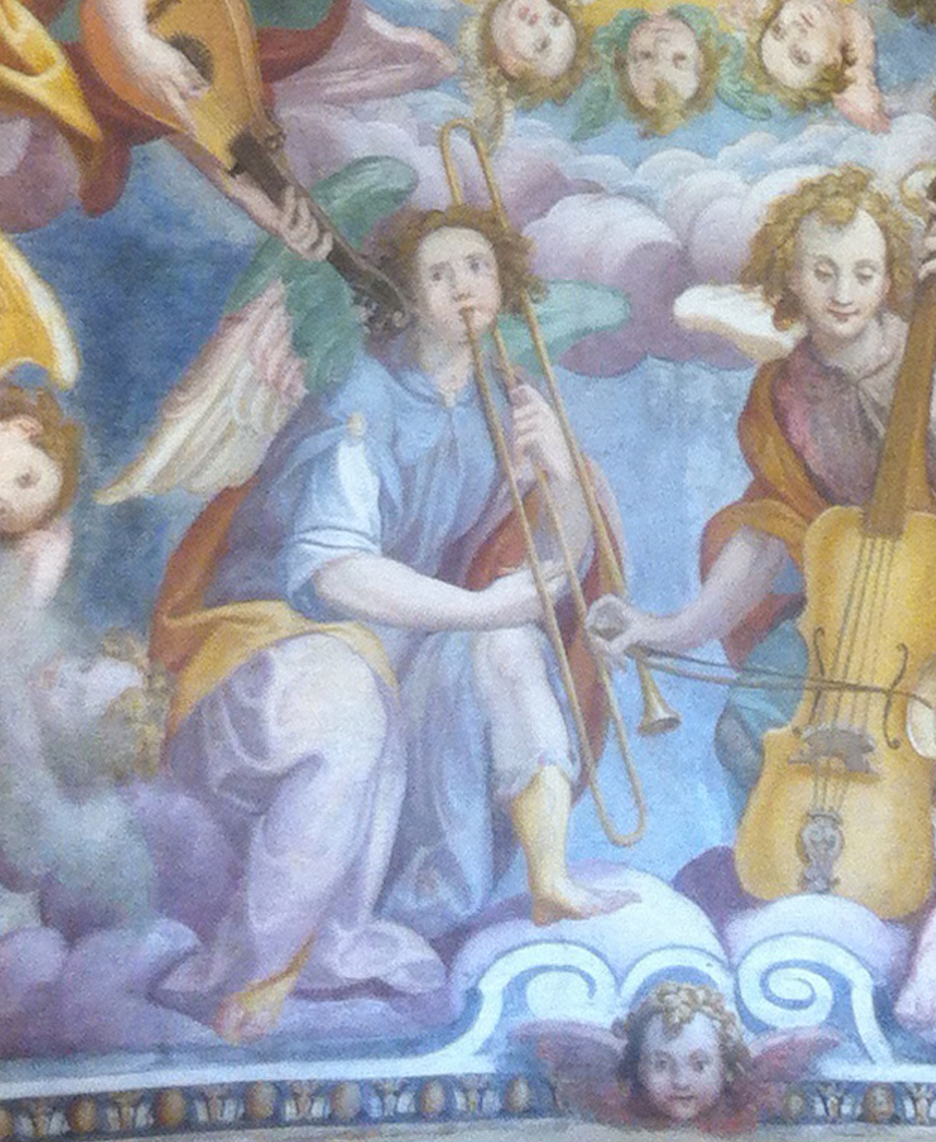
c. 1625—Italy: A painting by Italian Pietro Paolini (or his school), entitled Gruppo di giovani suonatori con vaso di fiori, offers a clear representation of a female trombonist among a group of musicians (see below image; public domain) (Giusti 158).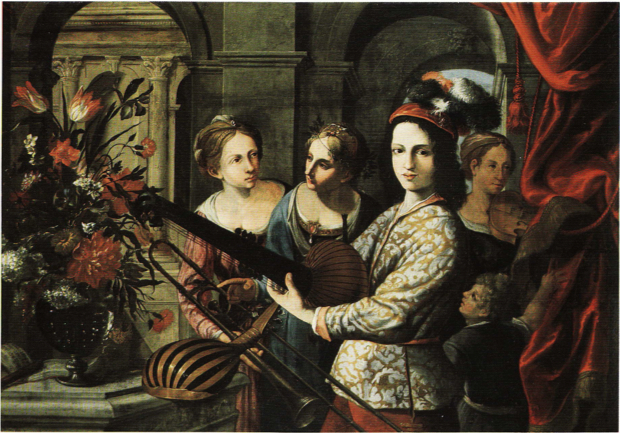
1625—Florence, Italy: Francesca Caccini’s ballet-opera La liberazione di Ruggiero is performed to honor a visiting Polish prince (Guion, Short History). Caccini uses 4 trombones, 4 viols, a positive organ, and keyboard instruments to depict an infernal scene (Weaver, Sixteenth-Century Instrumentation).
1625—Venice, Italy: Giovanni Picchi calls for trombone frequently in his collection of sonatas and canzoni titled Canzoni da sonar don ogni sorte d’Instrumenti. Specifically, Canzon Terza is scored for violin and trombone, Sonata Sesta is scored for violin and trombone, Canzon Settima is scored for 2 violins and trombone, Canzon Ottava is scored for 2 violins and trombone, Canzon Decima is scored for 2 flutes and 2 trombones, Canzon Undecima is scored for 2 cornetts and 2 trombones, Canzon Duodecima is scored for 2 violins and 2 trombones, Canzon Decima Terza is scored for 2 cornetts and 2 trombones, Canzon Decima Quarta is scored for 2 violins or cornetts and 4 trombones, Canzon Decima Quinta is scored for 2 violins and 4 trombones, and Sonata Decima Sesta is scored for 2 violins, 2 flutes, trombone, and bassoon (Winkler 301; Selfridge-Field, Instrumentation; Picchi, Canzoni da sonar).
1625—England: Records for the King’s Music list Hautboys and Sackbuts together instead of separately. The group consists of 11 players (Woodfill 303). Elsewhere, the Sagbutts are listed as John Snowesman, Richard Blagrave, Clement Lanier (Ashbee, Records III 136).
1625—Salzburg, Austria: A fresco by Matthäus Ostendorfer located in the Nonnenchor of Kloster Nonnberg (or Nonnberg Convent) features three angel-trombonists (see below image; public domain).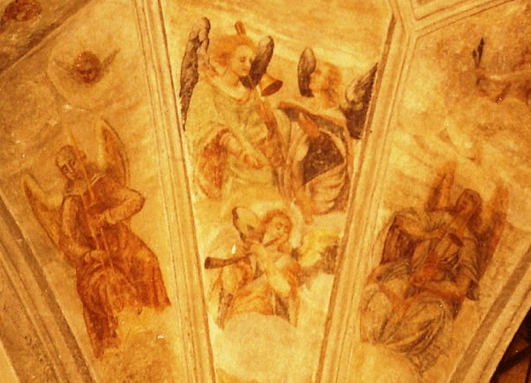 1625—England: the Salisbury cathedral employs cornetts and sackbuts (Woodbury 149). 1625—England: 2 trombones are used at the funeral of James I in Westminster Abby (Daubeny 95). 1625—Canterbury, England: At the Canterbury Cathedral, repairs are made to the “Sackbut book,” indicating the players are reading from written notation (Bowers 445).
1625—England: the Salisbury cathedral employs cornetts and sackbuts (Woodbury 149). 1625—England: 2 trombones are used at the funeral of James I in Westminster Abby (Daubeny 95). 1625—Canterbury, England: At the Canterbury Cathedral, repairs are made to the “Sackbut book,” indicating the players are reading from written notation (Bowers 445).
1625—Stadthagen, Germany: A painting by Anton Boten in the dome of the mausoleum at St. Martinikirche includes an angel playing a large trombone (see below image; public domain).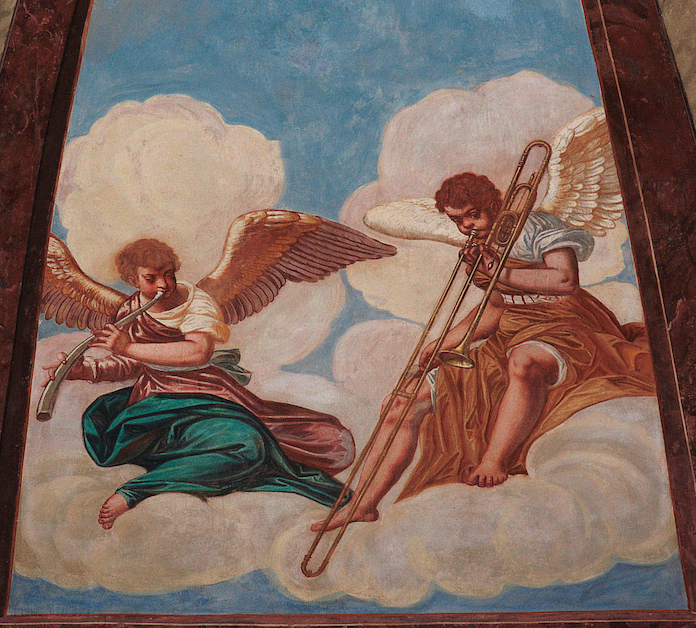
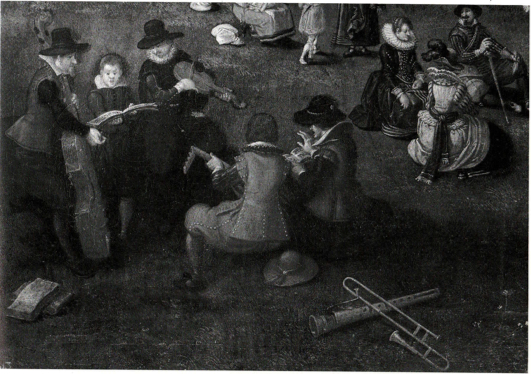 1625-1630—Belgium: The Royal Palace at Brussels, a painting attributed to Sebastian Vranckx and Jan Brueghel the Younger, includes a depiction of a trombone. The trombone rests on the ground, along with a dulcian, near an ensemble of 2 voices and 3 strings that is informally performing outdoors (see above image; public domain) (Kenyon de Pascual, Two Contributions).
1625-1630—Belgium: The Royal Palace at Brussels, a painting attributed to Sebastian Vranckx and Jan Brueghel the Younger, includes a depiction of a trombone. The trombone rests on the ground, along with a dulcian, near an ensemble of 2 voices and 3 strings that is informally performing outdoors (see above image; public domain) (Kenyon de Pascual, Two Contributions).
